Chesapeake Lens: “Companions” By Jay Fleming
The Spy Newspapers may periodically employ the assistance of artificial intelligence (AI) to enhance the clarity and accuracy of our content.

Nonpartisan and Education-based News for Centreville
The Spy Newspapers may periodically employ the assistance of artificial intelligence (AI) to enhance the clarity and accuracy of our content.
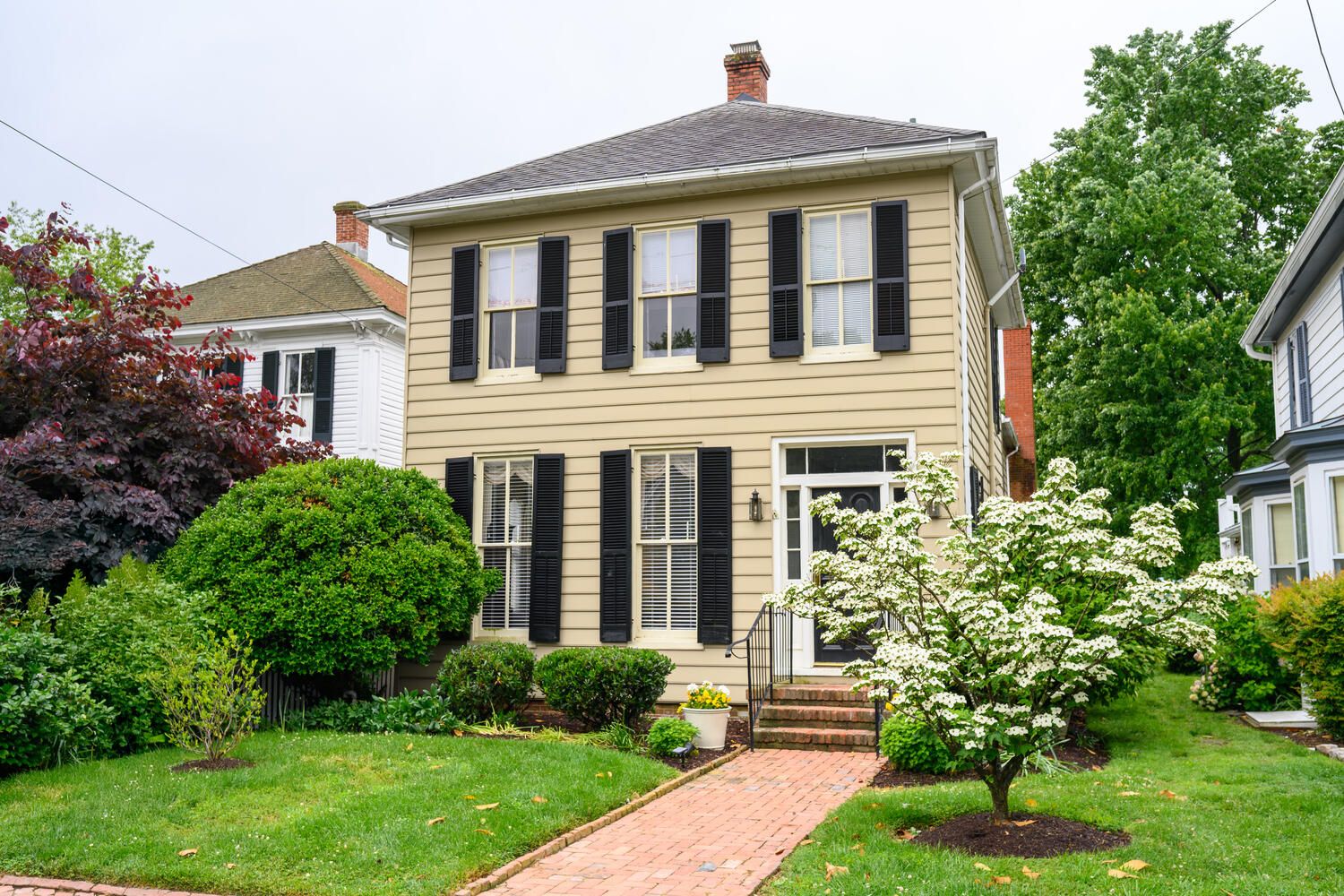
Timeless symmetry and classic details create an inviting façade in a charming town
Oxford’s Historic District has been a treasure trove for me whenever I begin seeking a house to be featured. This three bay house was probably two rooms deep originally but over time, there have been two additions that were easily accommodated on the property’s deep lot that ends at the shoreline of the Tred Avon River.
The Town’s brick sidewalk blends into the house’s brick sidewalk that leads to a brick stoop up to the original front door, with half paneled, half glass sidelights and a transom. I admired the façade’s pale caramel siding, long windows with black shutters and 2/2 windows. Along with the landscaping, especially the white dogwood, the architecture gives this charming house great curb appeal.
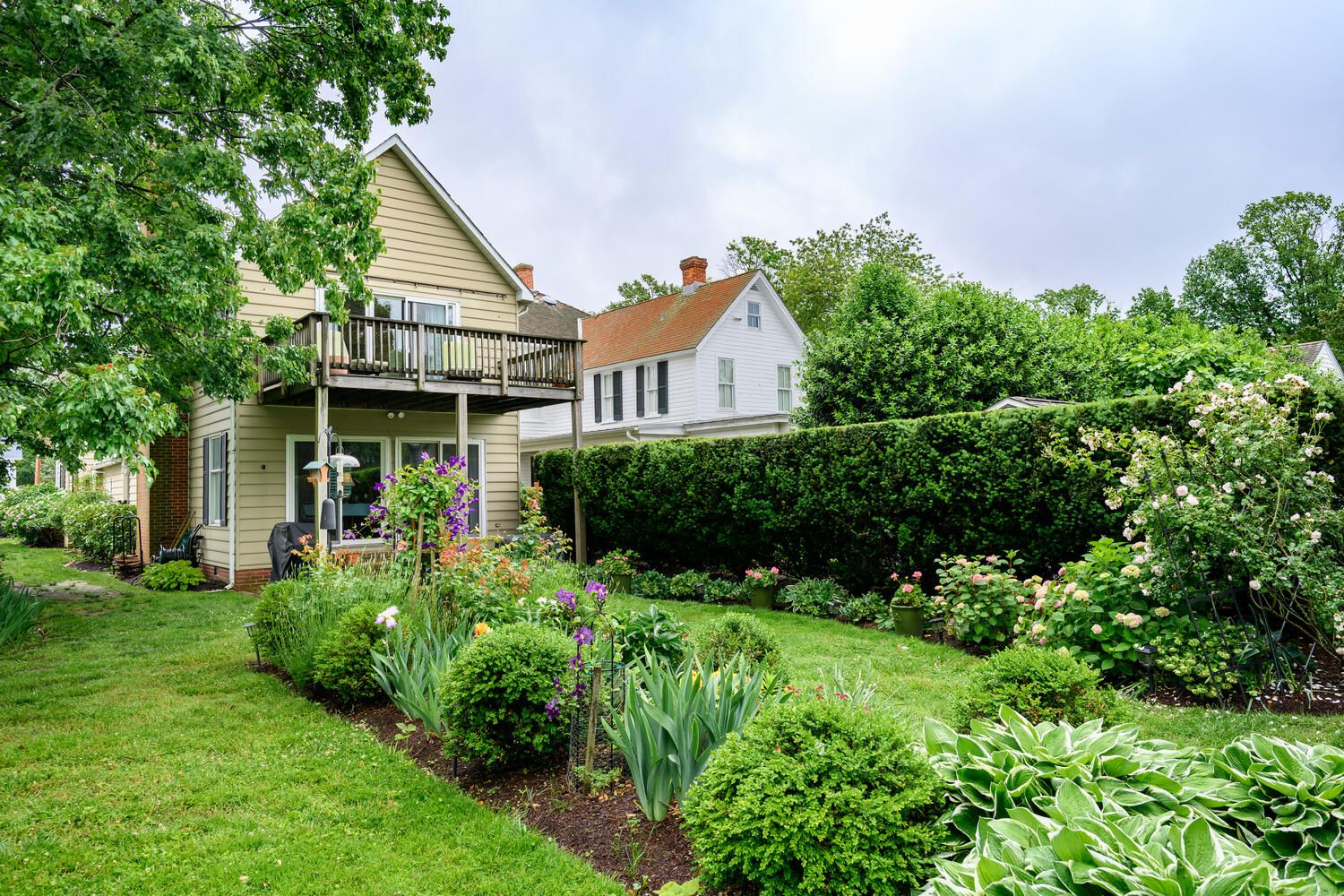
Thoughtful additions maximize views of the tranquil gardens.
The first addition created a kitchen and dining room and the second addition created a main floor family room and a second floor primary suite. I looked forward to seeing the water view from the spacious deck on my tour of the interiors. Both the family room and the primary ensuite overlook the planting beds, edged by a very high hedge for privacy, and the Tred Avon River beyond.
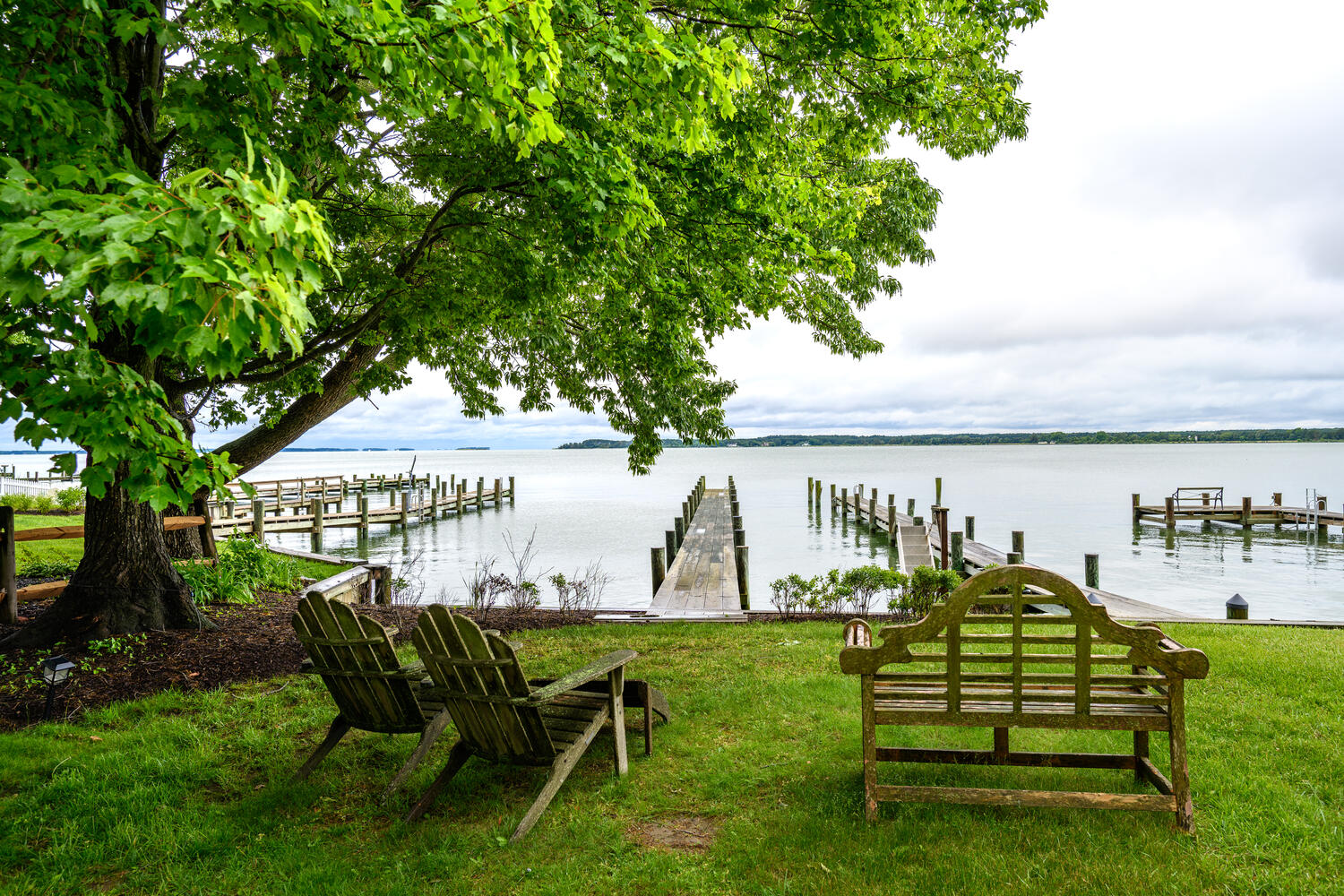
A lush green lawn leads to breathtaking waterfront vistas.
Beyond the planting beds, the lawn stretches across the width of the property. I was tempted to linger to admire the expansive water views but alas, heavy rain had just drenched the property. I imagined how pleasant it must be to relax on the Adirondack chairs or the Lutyens bench on sunny days to enjoy the prevailing summer SW breezes or to savor what must be magnificent sunsets over the water.
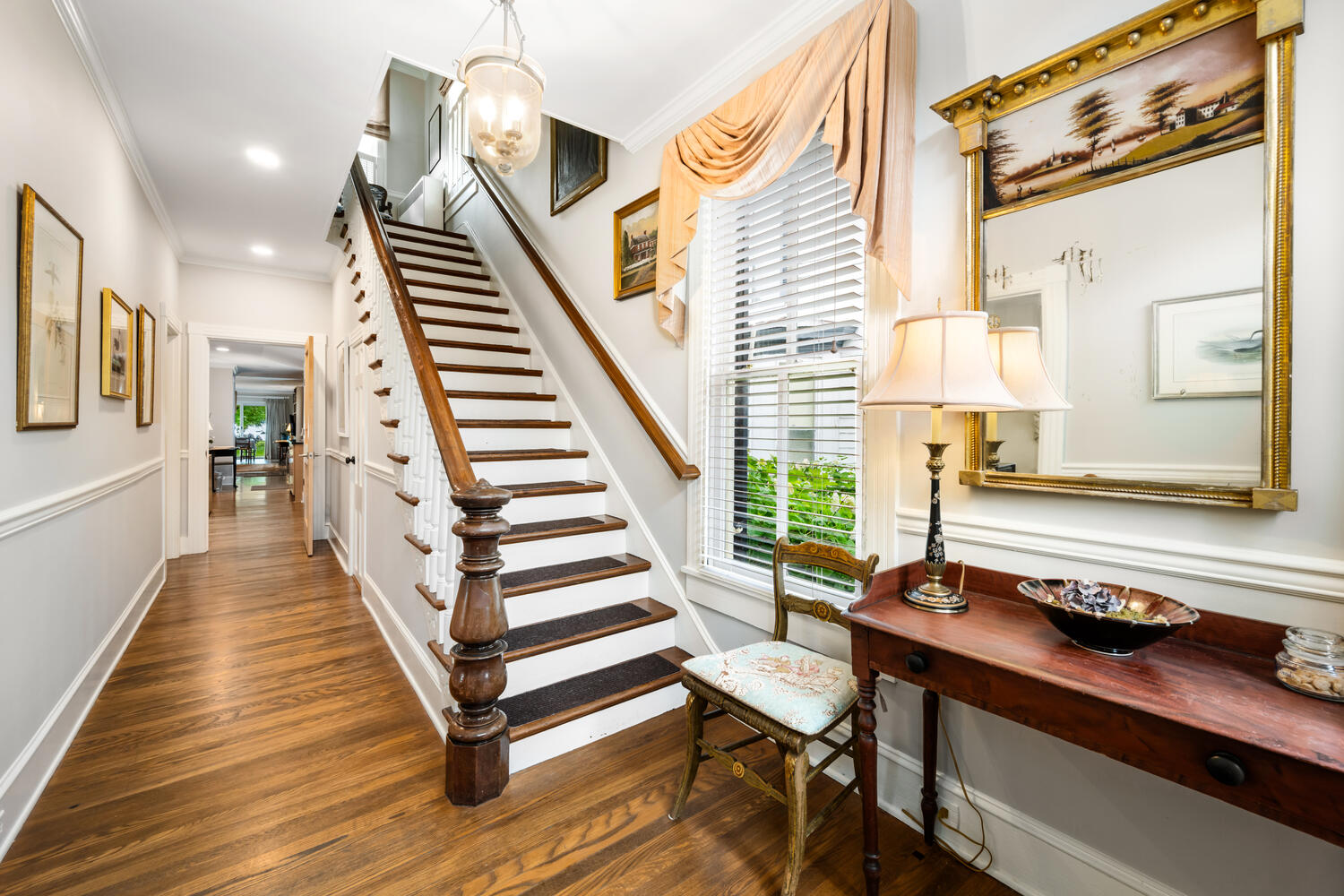
Clear sightlines showcase the layered depth of the home’s design.
It was clear when the wife of the Owner couple opened the door to welcome me that the interiors of this house would be quite tasteful. The foyer’s original staircase, wood antiques, and the mirror with its inlaid artwork portraying another house on the water were harbingers of more treasures to come. The swags over the window add color and the adjustable blinds offer views or privacy. With the stairs and hall at one side of the floor plan, the room sizes are maximized and tucked under the stairs is a full bath. The hall connects the rooms to a vista through the house that ends at the rear wall overlooking the gardens and water.

Elegant millwork and curated furnishings give the space a refined warmth.
Off the foyer is the stylish front sitting room with the yellow tones in the upholstery of the Chippendale sofa and the chairs and the warmth of the wood antique pieces. I also admired the abstract artwork over the wood chest and the coffee table’s multicolored base and glass top that was designed by the husband.
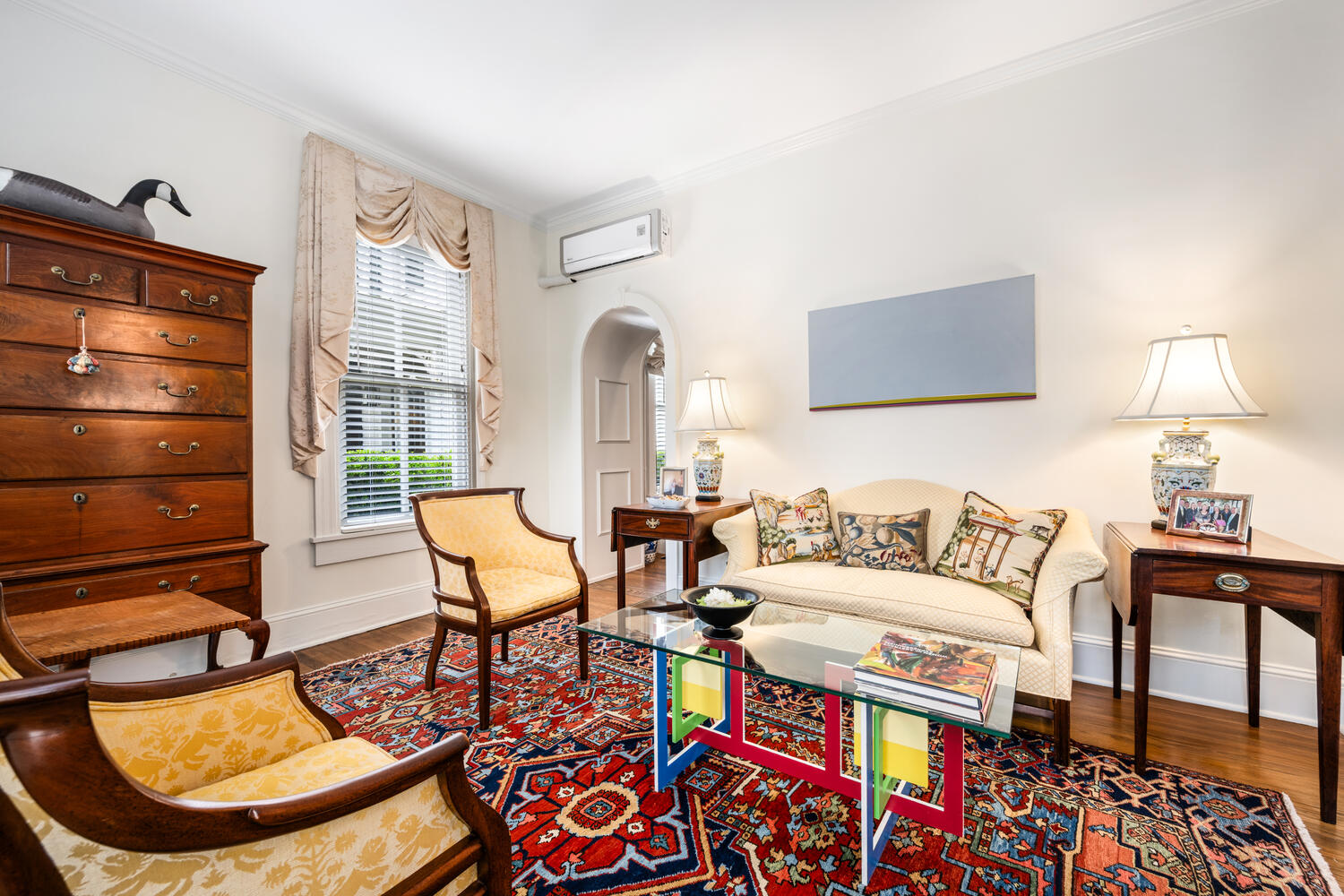
A crafted arched opening adds architectural interest and flow.
Since there is a chimney behind the sofa, the wall opening through the depth of the adjacent wall became a design element with its arched top and trim to evoke paneling. The touches of Chinoiserie in the pillows and the ceramic lamp bases complement the wall hanging on the side wall to the foyer. The glass top of the coffee table allows the colorful Oriental rug to take center stage in the room.
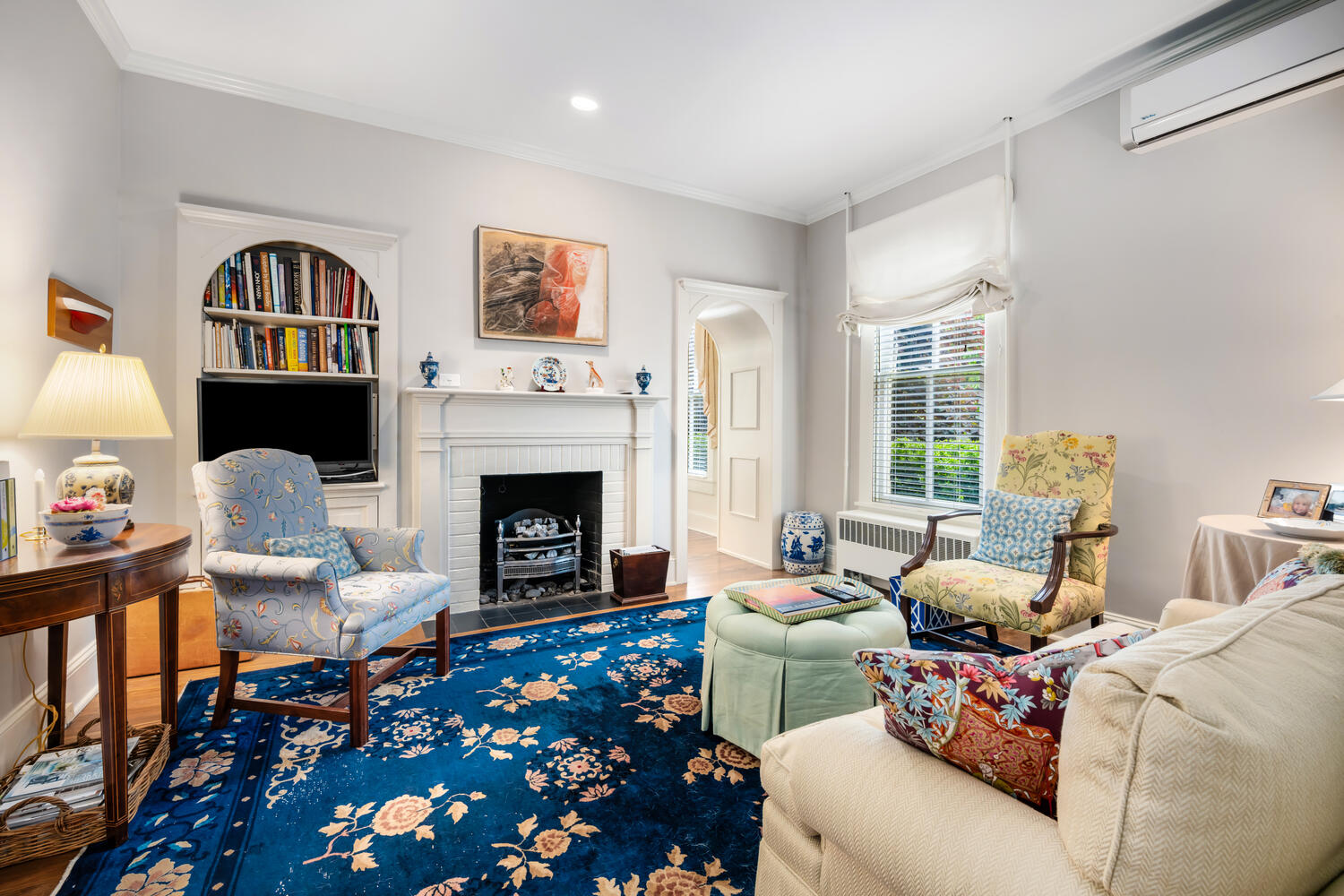
Cozy den design integrates bespoke millwork and classic finishes.
The arched wall opening connects the front sitting room to the cozy den with a fireplace and bespoke millwork for books and a TV. The subtle colors of the upholstery would make it easy to relax with one’s feet resting on the round ottoman to watch TV by the warmth of the “winter” sitting room.

Sophisticated dining anchored by period furniture and intricate details.
A wide wall opening connects the “winter” sitting room with the dining room. Another large Oriental rug anchors the antique table and chairs under the crystal chandelier and another mirror with a painted scene is above the antique chest. I especially admired the antique Sheffield silver tea set and the touches of modern art.
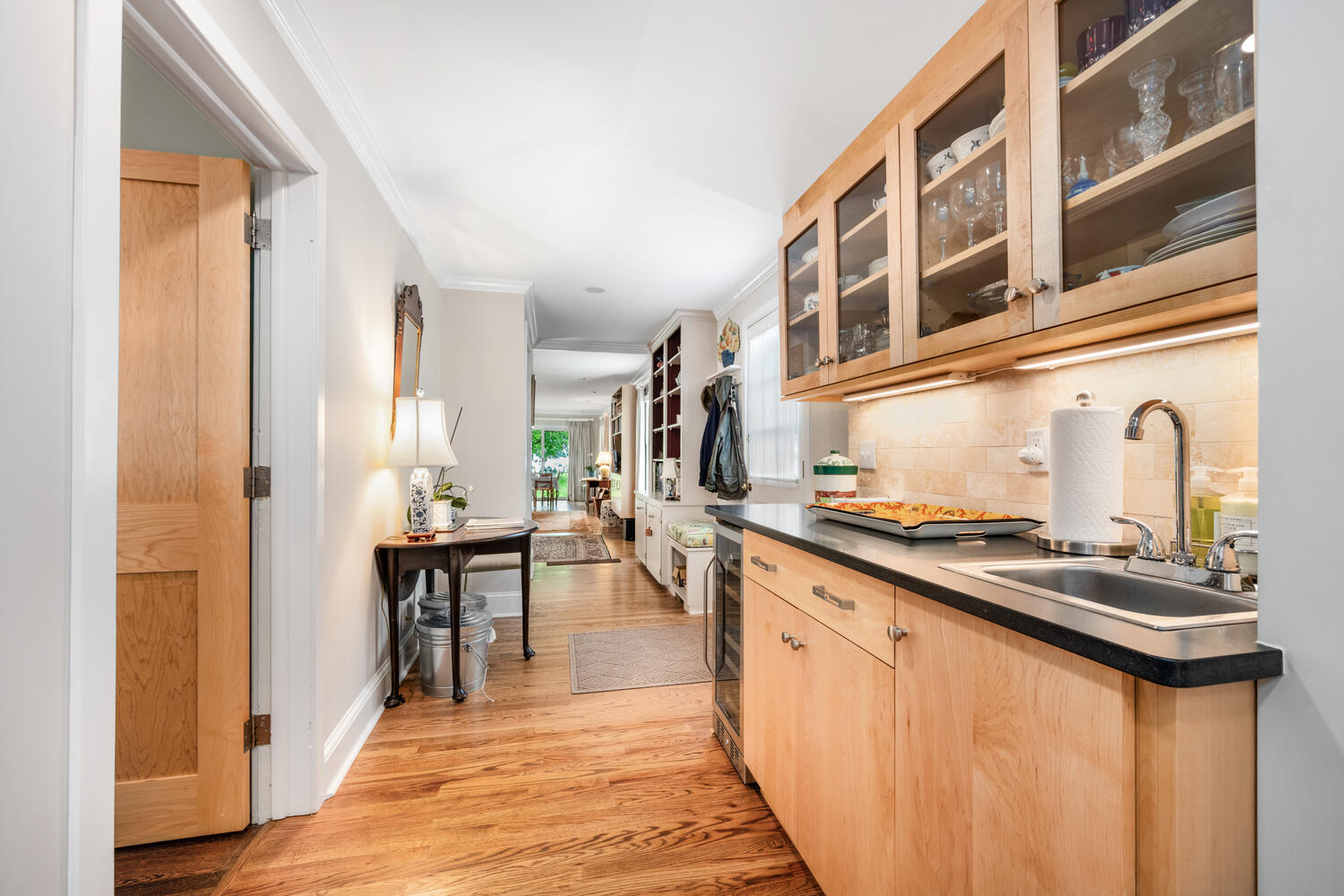
Artisan-crafted cabinetry enhances utility in the compact butler pantry.
It is hard to imagine that the stylish butler pantry area opposite the dining room in the hall was once a powder room. Before this area’s transformation, one had to go through the dining room door to reach both the den and the front sitting room. The current Owners repurposed the powder room and created the butler pantry with a wet bar by the artisan woodworker Dennis Andrews. Maple is one of my fave choices for cabinetry since its fine, even grain has a light color and smooth texture. They also created a mini-mud room space with a bench and open shelving next the exterior door. The maple doors that the Owners added as modern accents were the work of artisan woodworker Tom Maddox.
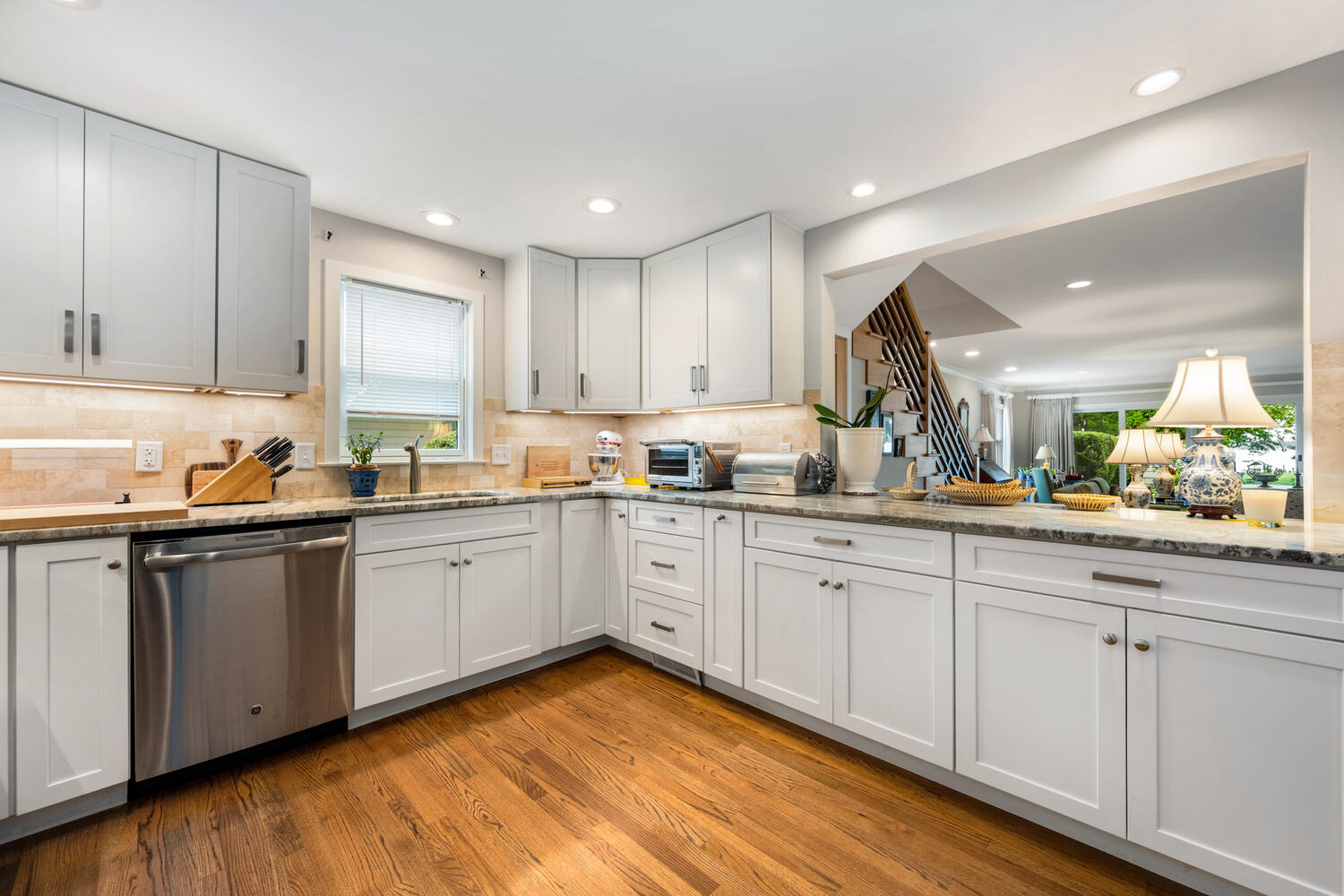
Updated finishes highlight the airy connection between kitchen and serene Eastern Shore views.
Previous owners had added the kitchen-family room addition that is the hub of the house. The current owners replaced the cabinet hardware with sleek pulls and replaced the green tile backsplash with a softer colored Travertine tile. The white craftsman style cabinetry highlights the beautiful wood flooring and the wide wall opening gives the cook an expansive water view.

Modern craftsmanship meets heritage architecture in this seamless design.
I loved the eclectic look of the spacious family room with traditional upholstered furnishings along with the modern bespoke millwork and the stair design by Tom Maddox that replaced the previous owners’ circular stair. Instead of vertical pickets, the walnut pickets are horizontal above maple risers that wrap around the wall and interlock with each other for a seamless design. Another exquisite antique mirror with a painted scene above a Queen Anne table caught my eye.
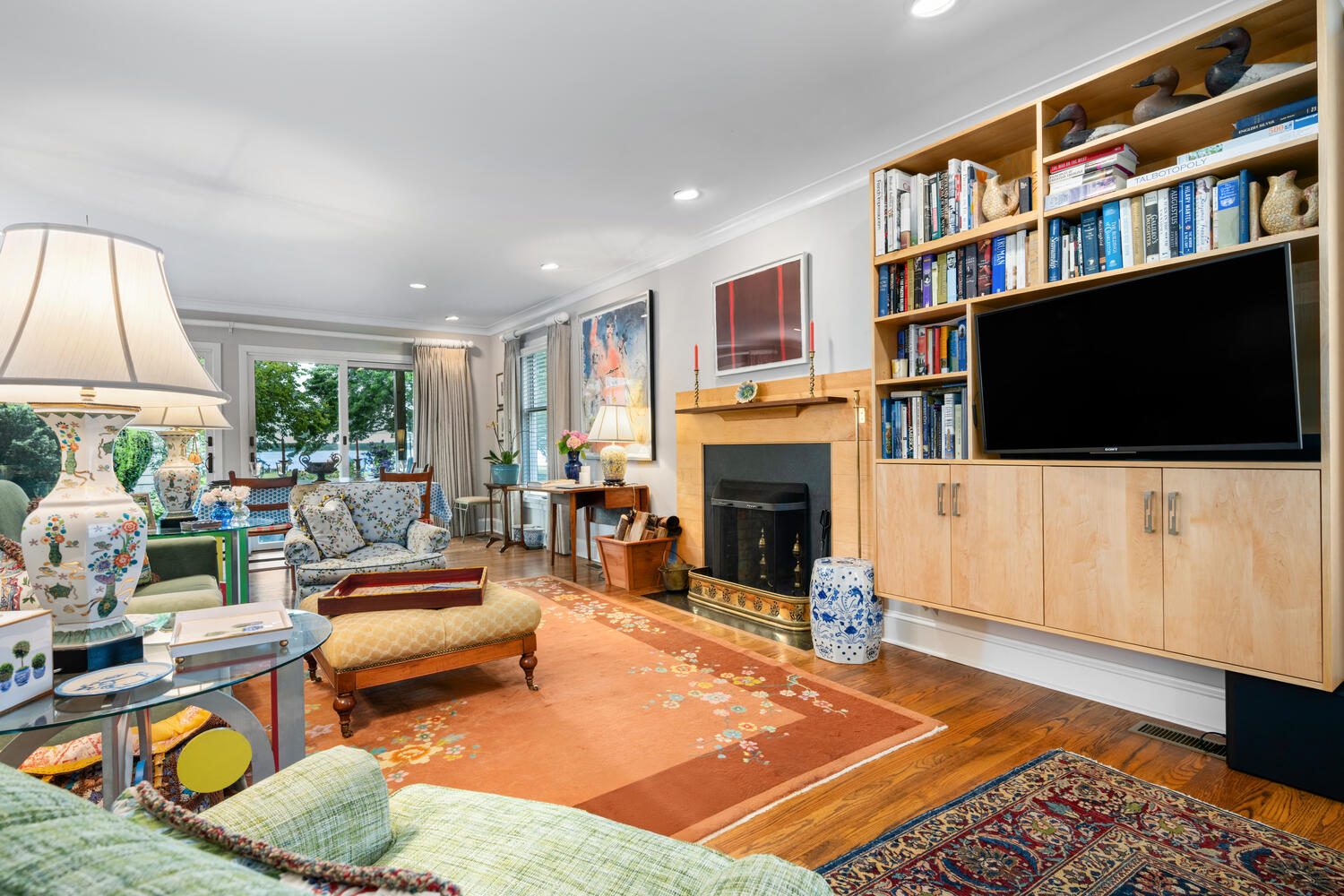
A balance of modernity and tradition defines this large and inviting family space.
Other modern touches of the round glass topped end table, the abstract art above the fireplace with its surround and hearth of “Absolute Black” granite and the bespoke millwork by Dennis Andrews floating over the floor add to this room’s great appeal.
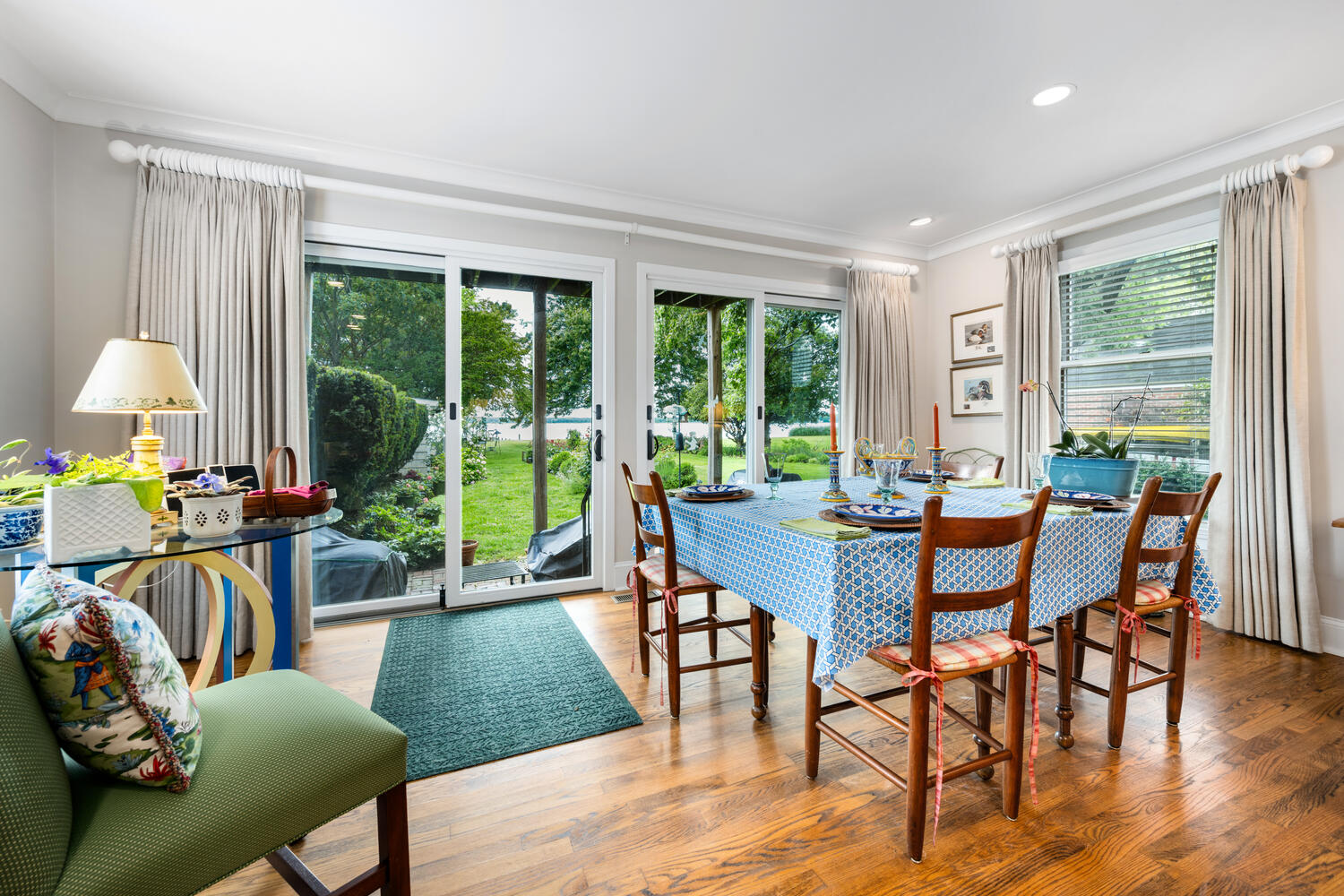
Double doors blur the line between indoor living and outdoor serenity.
At the end of the family room, a pair of double doors infills most of the rear wall and both frames the views of the landscape and water and also leads to the brick terrace under the shade of the primary bedroom’s deck above. This delightful breakfast/informal dining area at the corner of the room with its ceramic dinnerware and candlesticks would make it easy to linger over a second cup of coffee.

Thoughtfully placed windows allow natural light to filter in, illuminating the timeless wooden staircase.
The foyer stairs lead to a landing with its focal point of the exquisite antique clock. Windows on each corner wall filter sunlight both onto the beautiful wood floors and the stairs. The transparent pendant light fixture matches the one in the foyer ceiling.
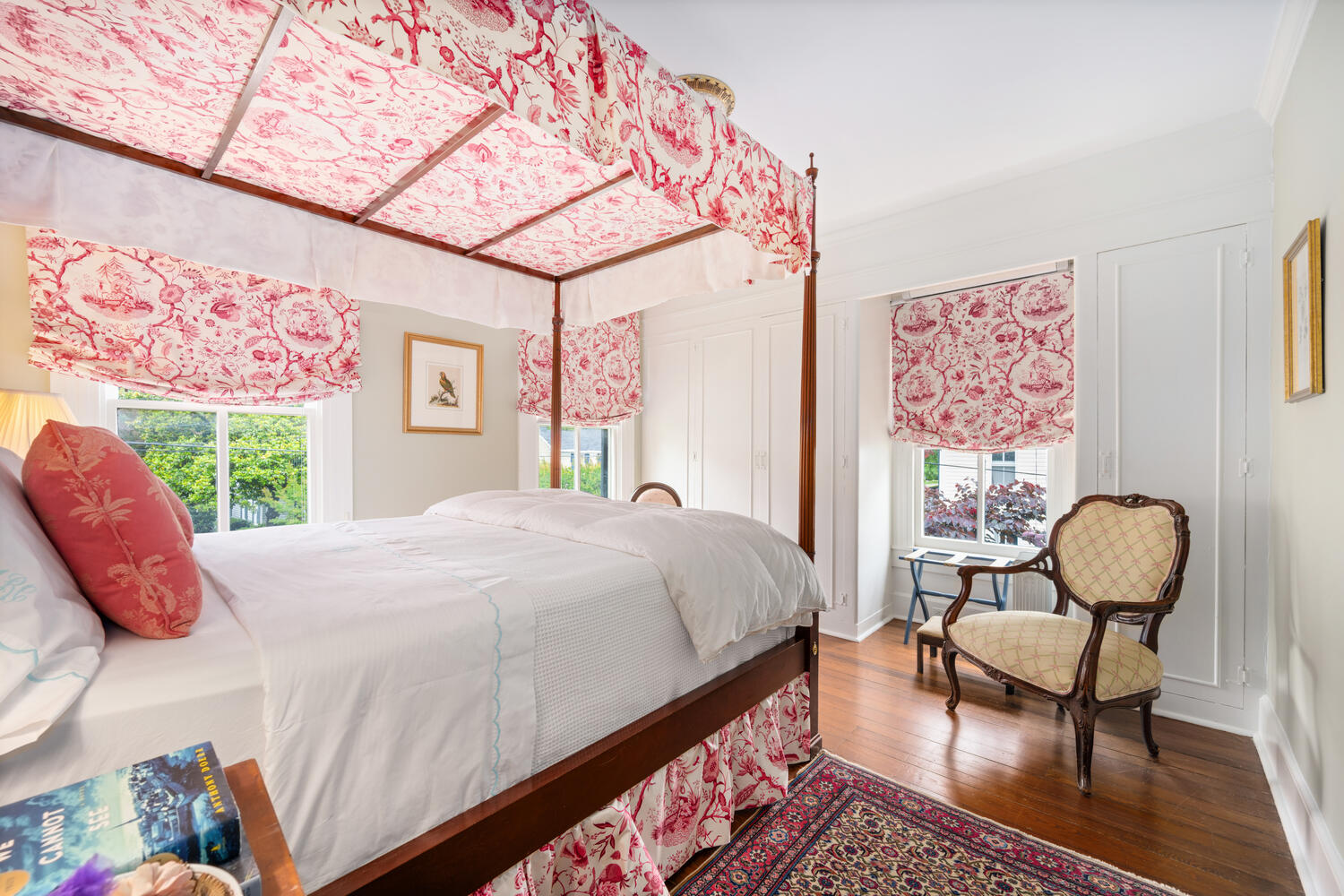
The front bedroom offers an intimate, sunlit retreat.
At the front of the house is this charming corner bedroom with three windows for abundant sunlight. I loved the red and white toile fabric of the bed’s canopy, skirt and window shades. I was amazed when the wife told me she had sewn them all!
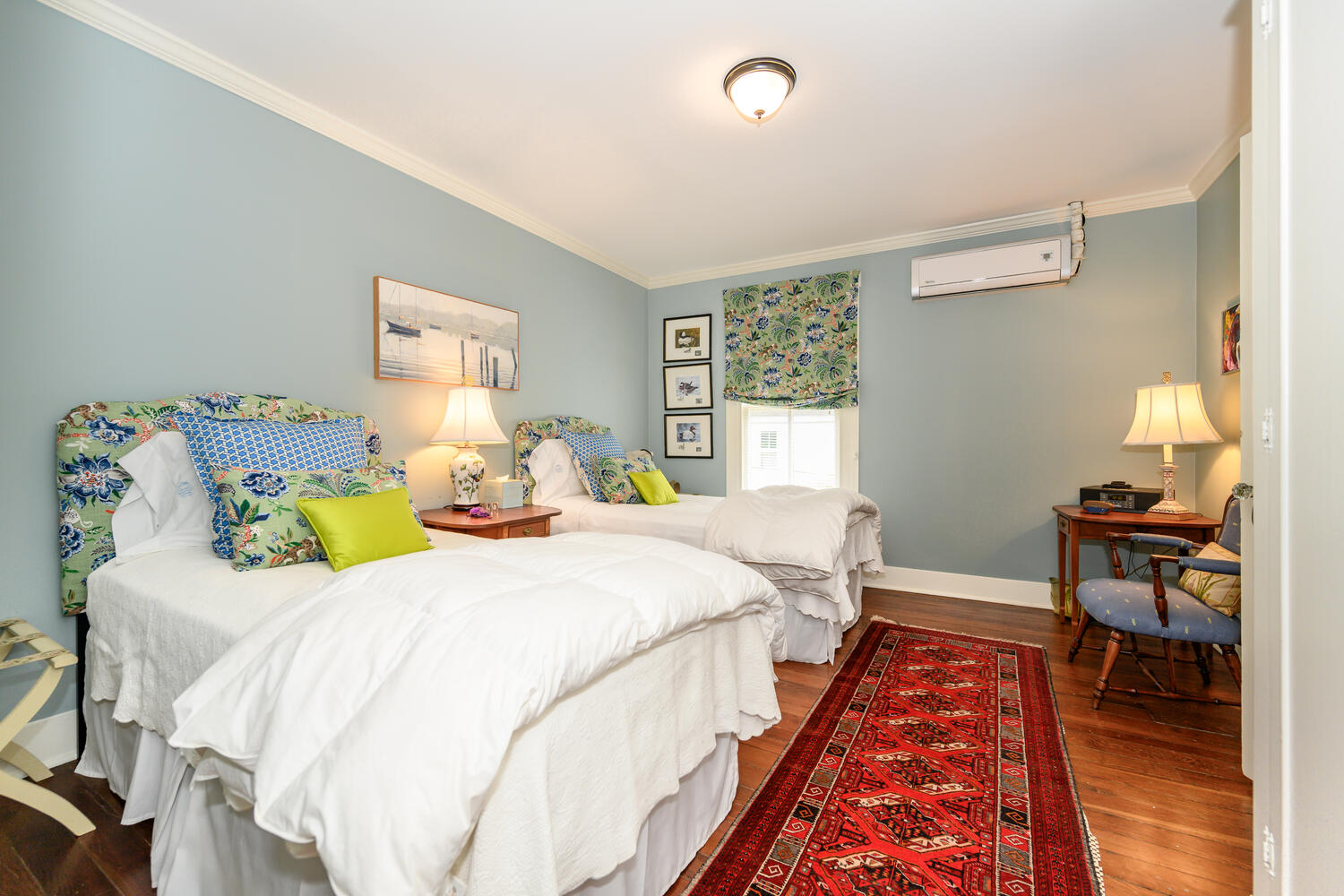
Soft hues and layered patterns enhance the cozy charm of this room for two
The other guest bedroom is equally charming with the pale blue walls, fabric headboard and accent pillows in different colors and patterns (also the handiwork of the wife). The window shade matches the headboard and the white bedding make the room seem larger than it is. The runner in shades of red is a perfect finishing touch.
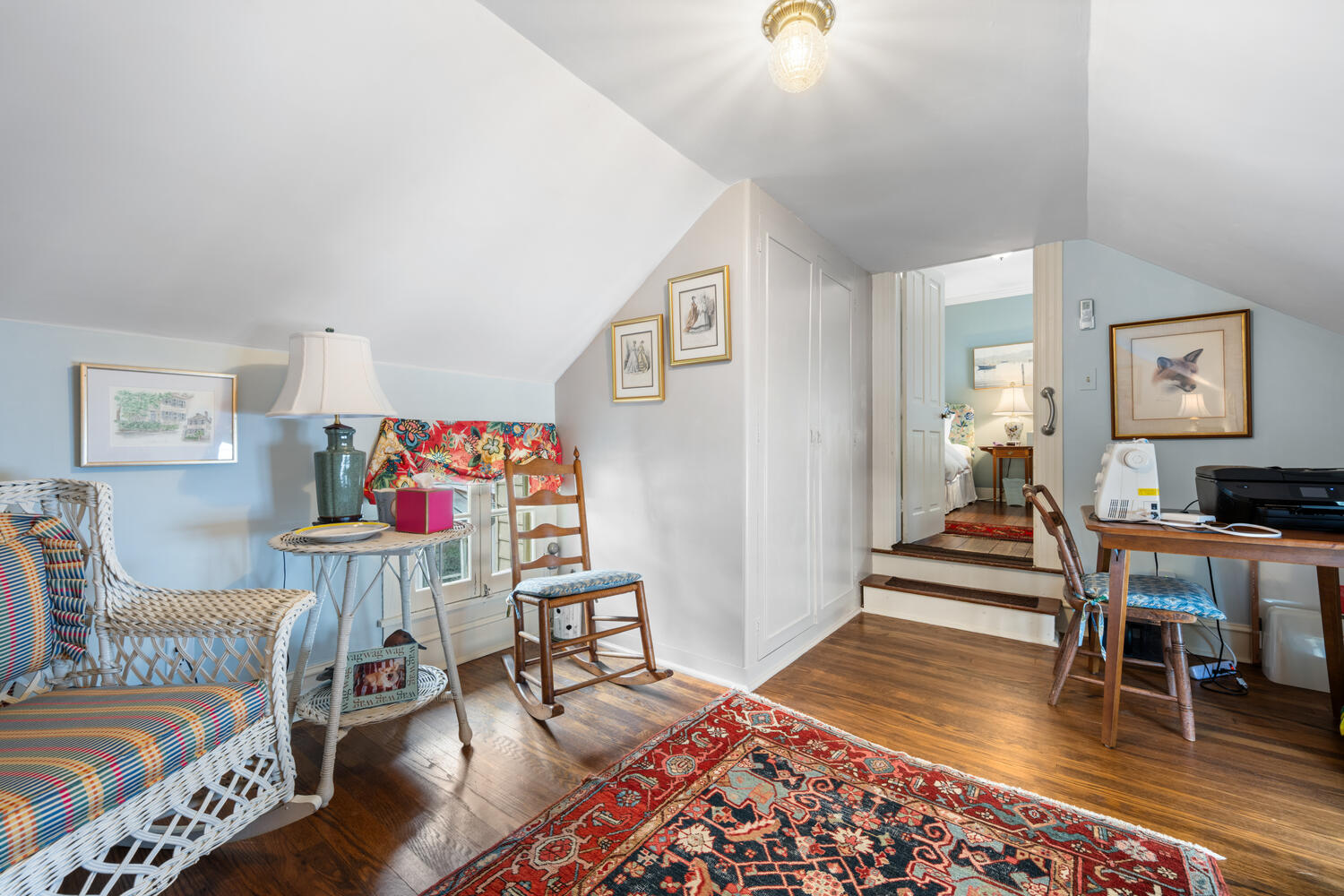
The second-floor sitting room is a perfect tucked-away nook with character-filled architectural details.
Steps lead down from the twin beds guest bedroom to this charming sitting/workspace with delightful interior architecture from the high knee walls and sloped ceiling. On the other side of this room is the primary ensuite.
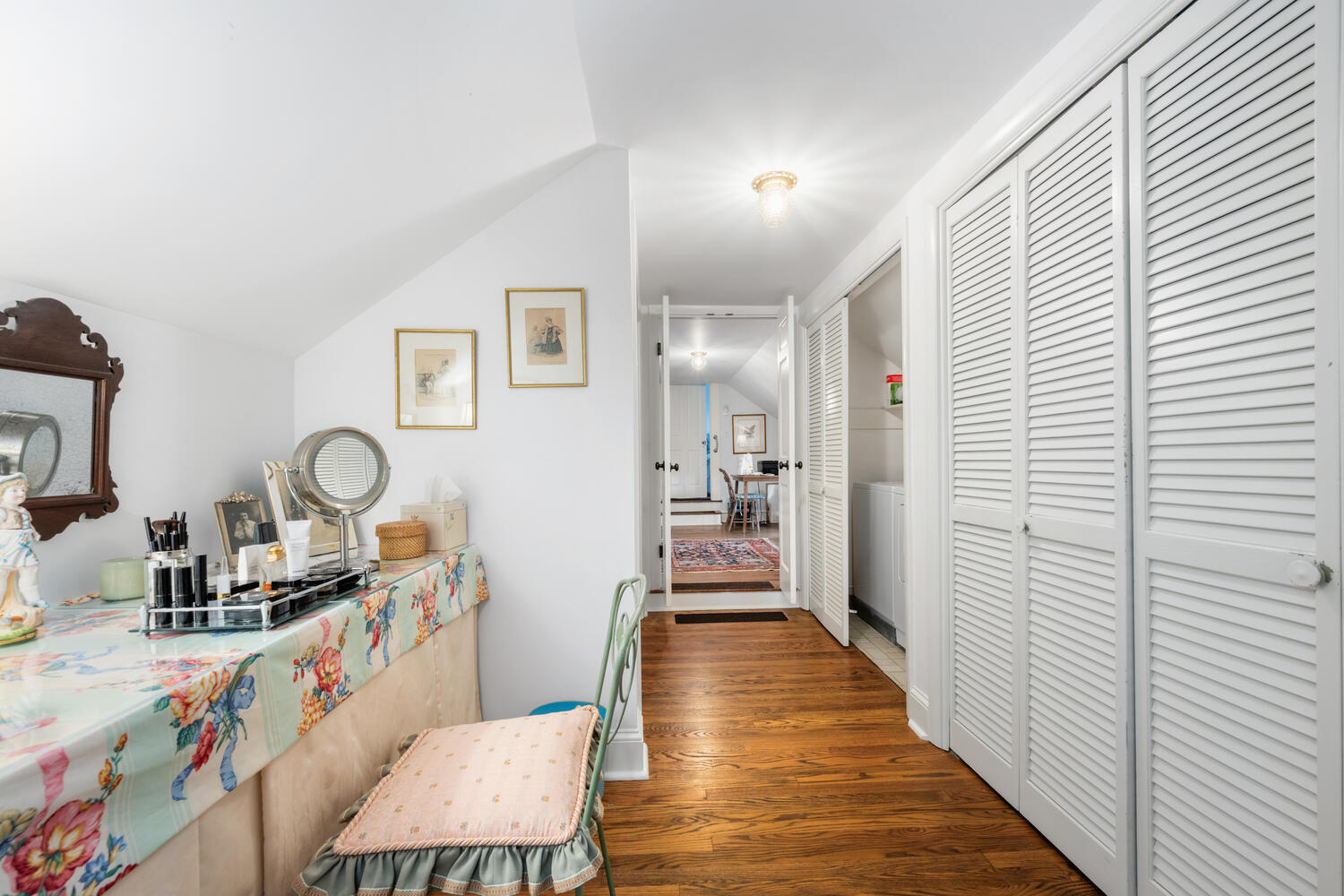
Thoughtful design merges storage and style in this tailored dressing room.
The door from the sitting room opens into a short hall past the washer/dryer closet and two clothes closets. I have always wanted a dressing table and this long table with a glass top over fabric has all the space one needs for getting ready for the day.
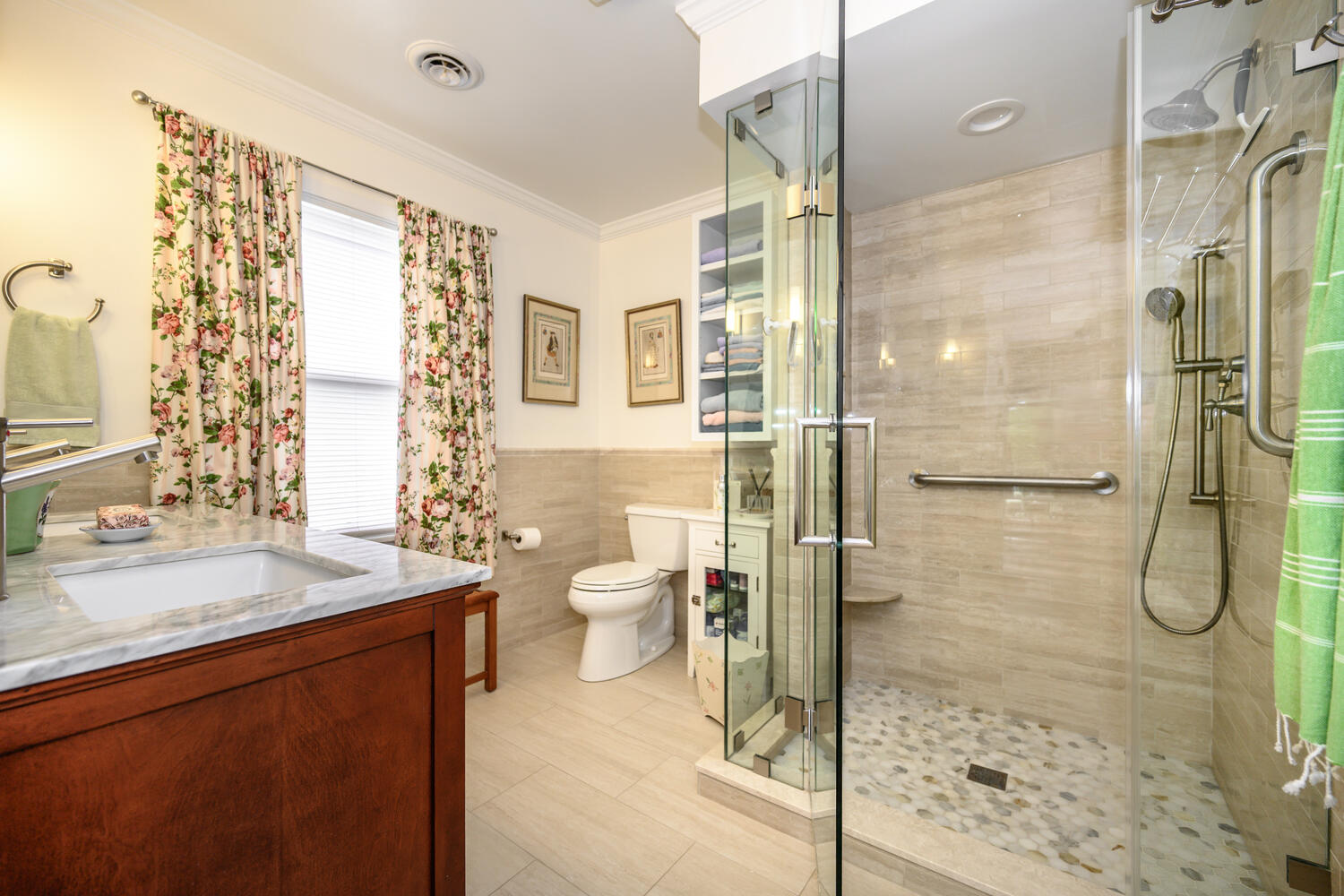
Marble and wood details combined with neautral wlls create a timeless and sophisticated restroom area.
Past the dressing room is the hall to the stairs down to the family room and to the primary suite. Previous Owners had located the door to the primary bath on the hall. The current Owners relocated the door to opens up into the primary bedroom and the spacious four-piece bath’s layout works so much better. The finishes of the wood lavatory with dual recessed sinks, the glass walled shower with flooring of “Calacatta Gold” marble hexagon mosaic tile, tile flooring and wainscot create an elegant bath.
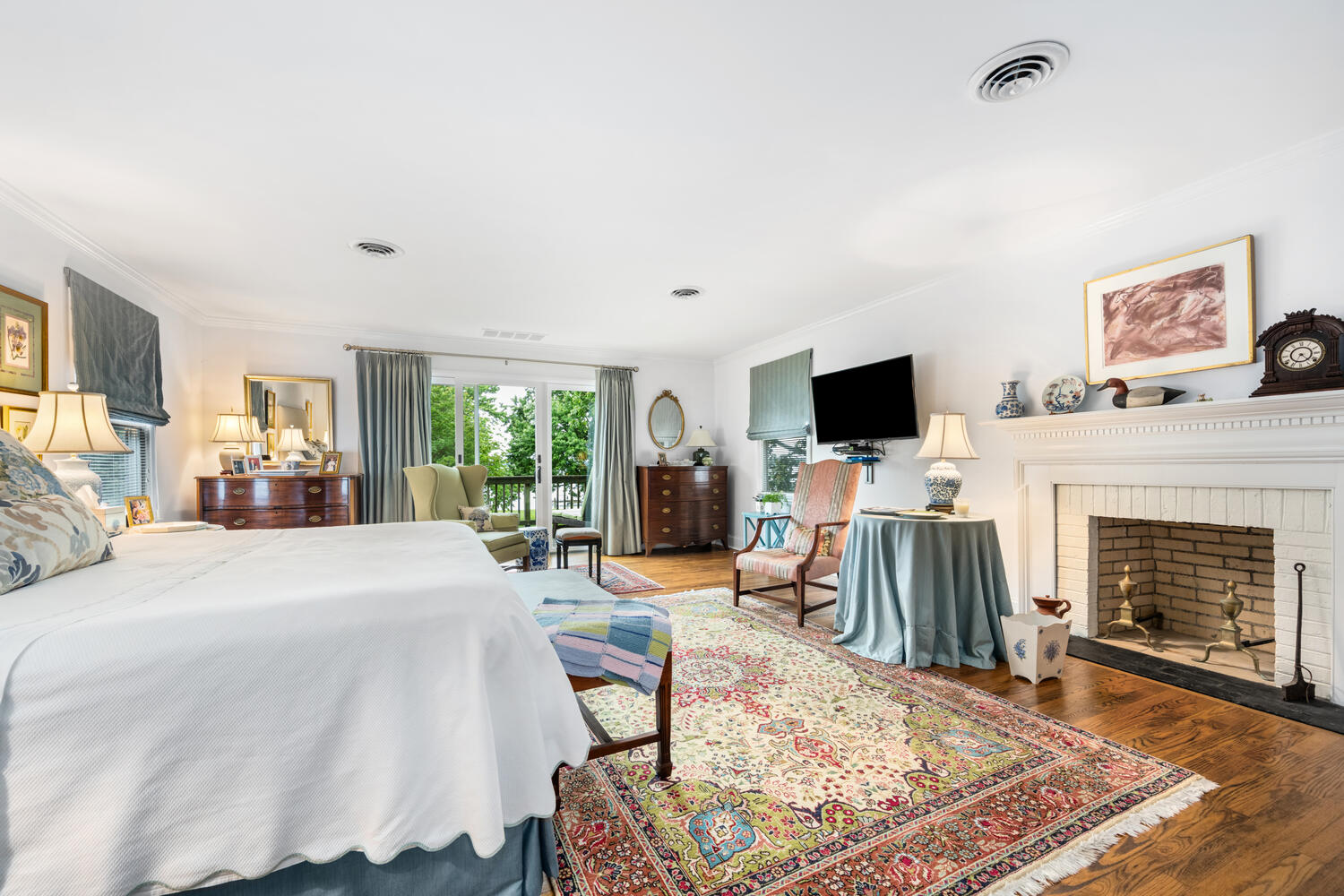
The primary offers timeless elegance and modern comfort as well as plenty of space to sit by the fire.
The primary bedroom is located at the quiet rear corners of the house. The spacious room has both sleeping and sitting spaces with a fireplace, making this a true haven. Dual chests of drawers flank the sliding doors to the deck and with the two side windows, there is plenty of sunlight and views of the landscape.
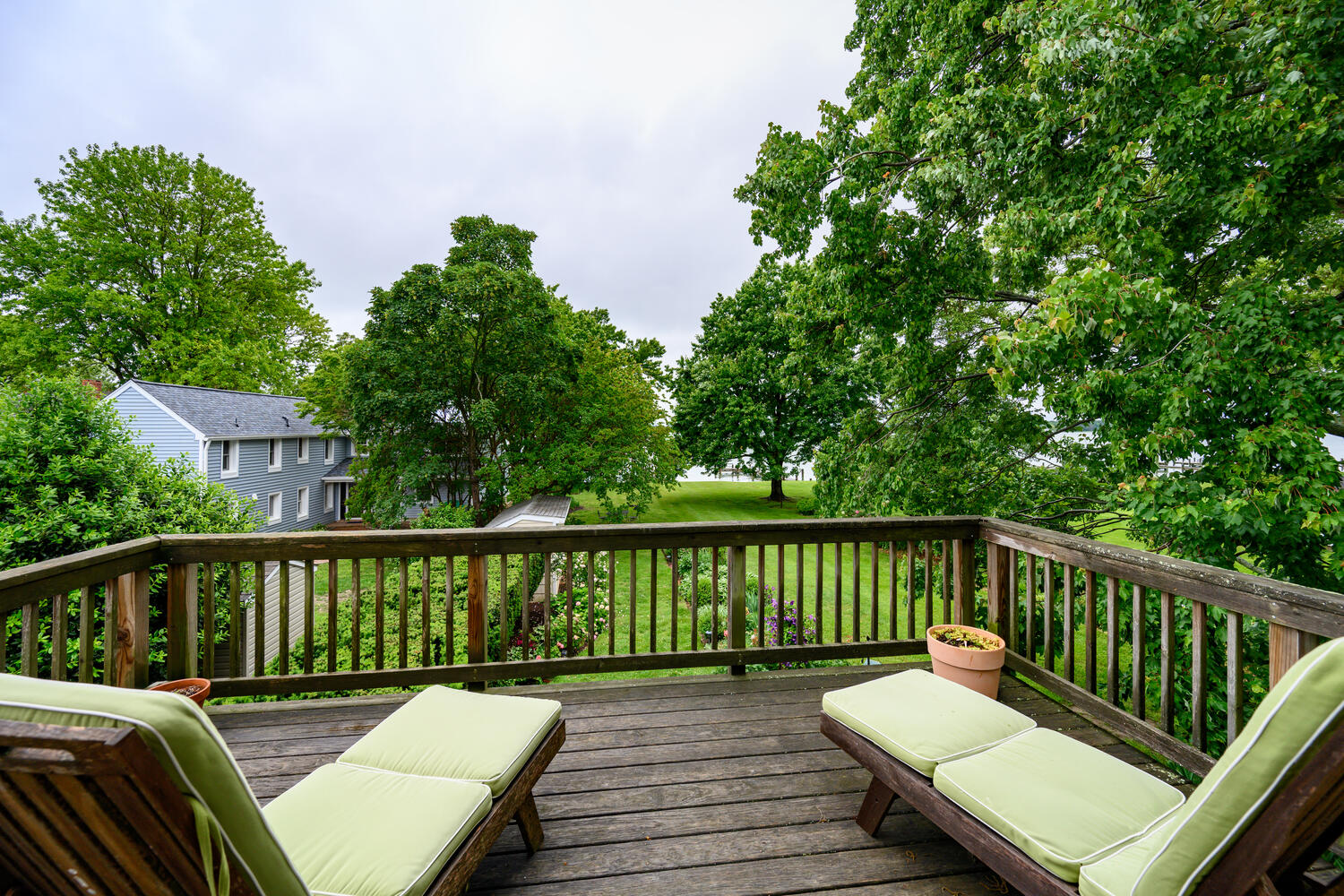
Step out of bed and out into elevated tranquility with panoramic views of the water and gardens.
The “bonus room” is the private deck off the primary bedroom, sized to easily accommodate the length of the chaise lounges. The long view over the gardens and lawn ends at the shoreline of the Tred Avon River. The summer view is quite private from the surrounding deciduous trees but the winter sunset view must be even more spectacular, given the location of the house on the water.
This charming house on the Tred Avon River in Oxford’s Historic District has many original elements including the front door, sidelights and transom; moldings, wood floors, high ceilings and tall windows, that harmoniously exist with the updated kitchen and bathrooms and modern touches of millwork, stair railing, sleek hardware and two-panel doors to create this unique home. Small design choices can have big impacts. The Owners’ clever repurposing the location of the existing powder room replaced the awkward circulation through the house with a hall that offers clear vistas from both the front door and the rear sliding doors overlooking the gardens and the Tred Avon River. Outdoor rooms of the main floor’s brick waterside terrace off the family room and the private deck off the second floor primary bedroom provide views of the gardens and magnificent sunsets over the Tred Avon River. For boating enthusiasts, the long dock provides access for an afternoon on the water. From its curb appeal to its classic architecture, charming interiors and lovely gardens, this house in the heart of Oxford’s Historic District is a AAA gem!
For more information about this property, contact Ray Stevens with Benson & Mangold Real Estate at 410-226-0111 (o), 410-310-6060 (c) or [email protected]. For more photographs and pricing, visit www.raystevens.bensonandmangold.com, Equal Housing Opportunity”.
Photography by Janelle Stroop, Thru the Lens Photography, 410-310-6838, [email protected]
Contributor Jennifer Martella has pursued dual careers in architecture and real estate since she moved to the Eastern Shore in 2004. She has reestablished her architectural practice for residential and commercial projects and is a real estate agent for Meredith Fine Properties. She especially enjoys using her architectural expertise to help buyers envision how they could modify a potential property. Her Italian heritage led her to Piazza Italian Market, where she hosts wine tastings every Friday and Saturday afternoons.
The Spy Newspapers may periodically employ the assistance of artificial intelligence (AI) to enhance the clarity and accuracy of our content.
Jacques-Joseph Tissot (1836-1902) was a successful painter and printmaker in the 19th Century. Born in Nantes, a port city in France, he would continue throughout his life to be interested in painting images with ships. His parents Marcel Tissot, a successful drapery merchant, and milliner Marie Durand influenced his interest in fashion and art. He decided by age 17 to become an artist, and by age 20 he was in Paris studying at the Ecole des Beaux-Arts. He learned to paint in the classical style. Hippolyte Flandrin, a well-respected Academic painter, was his major instructor. Tissot met life-long friends in Paris, among them Whistler, Manet, Oscar Wilde, and Degas, who became his mentor. He had success at the Paris Salon in 1859 with his paintings based on the popular story of Faust. Gounod’s opera Faust and Carre’s play Faust and Marguerite influenced the works. Tissot’s earlier works featuring medieval stories were considered by critics to be of the old style. Critic Paul de Saint-Victor wrote, “It is sad to see an intelligent and gifted artist betraying his talent with pedantic imitations.”
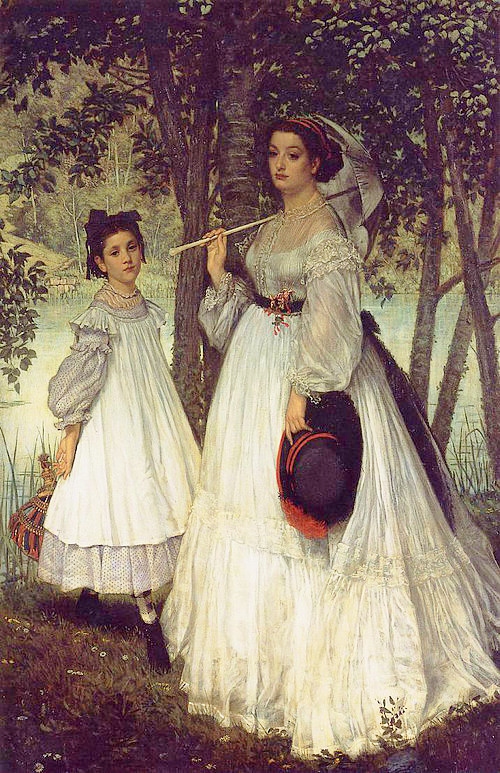
“Two Sisters” (1863)
“Two Sisters” (1863) (83’’x54’’) is characteristic of Tissot’s meticulous attention to detail. The two sisters stand on a grassy lawn beneath the trees. The older sister’s white gown has a sheer layer of fabric decorated with laces draped over the well-fitted gown. Her red hair ribbon, red flowers tucked into her black ribbon belt, and black hat with red feathers are well matched. The younger sister’s white pinafore, appropriate for her age, has just the right amount of ruffles and lace. The younger sister carries a round fancy basket that repeats the shape and colors of the hat. Fashion seems to be the subject of the painting. The sisters appear to be posing, revealing little of themselves.
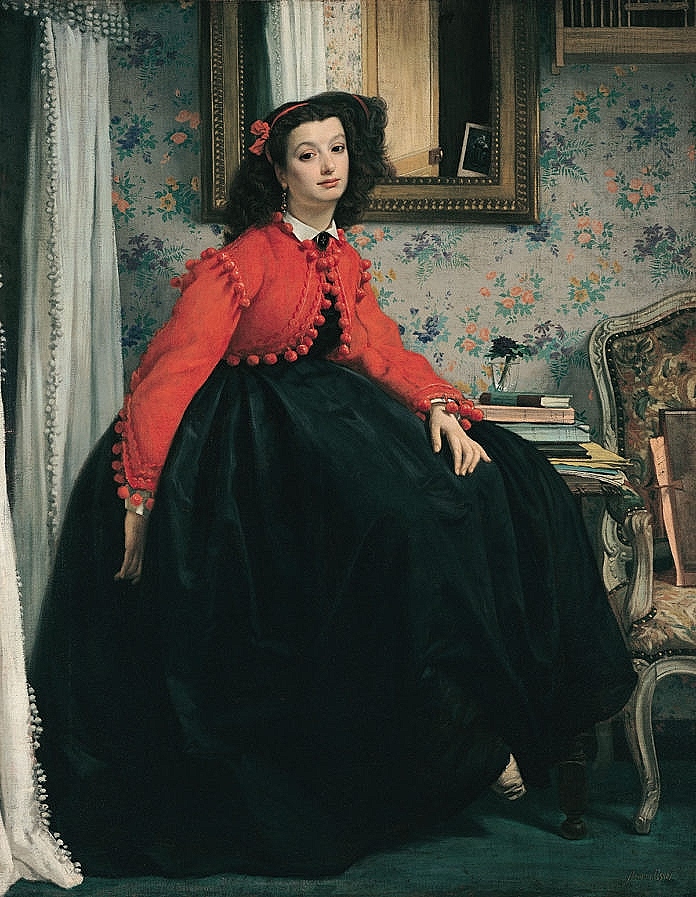
“Mlle L.L. in Red” (1864)
Tissot showed “Two Sisters” and “Mlle L.L. in Red” (1864) (49”x39”) for the first time at the Paris Salon of 1864 to illustrate his competency in depicting contemporary images. “Mlle L.L. in Red” is a mystery. The subject remains unidentified. Her red jacket was worn by the Zouaves, a French corps of soldiers formed in Algeria, who continued to wear their North African style uniform. The rows of bright red pom poms caught attention. Her lap and legs are merely suggested under the voluminous black skirt. Complementing her red jacket are the dark green color of the carpet and the red and green colors played out in the wall paper and the fabric covering of the chair. The subject appears to be a reader; she has books and loose papers in her room. The mirror behind her reflects an open door, and a card or photograph is tucked into the frame of the mirror. Charming and mysterious, she engages the viewer in a nonchalant manner.
However, in 1864, another critic commented that Tissot created “genuine paintings…whose greatest merit consists in the sincerity of their modern feeling.” In Le Grande Journal, Jules Castagnay wrote, “Mr. Tissot, the crazy primitive of the most recent Salons, has suddenly changed his manner and moved closer to Mr. Courbet, a good mark for Mr. Tissot.”
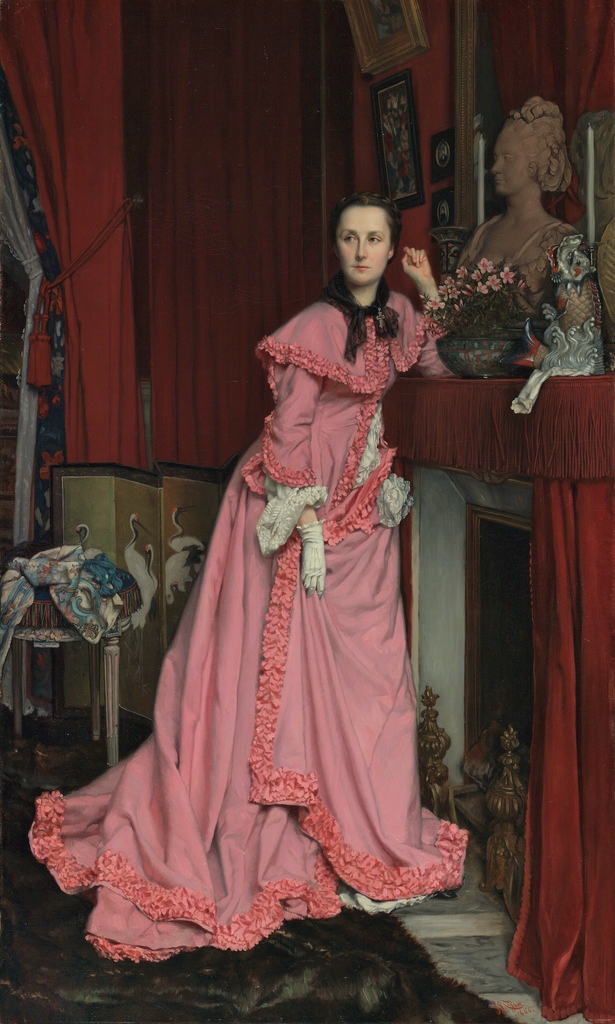
“Portrait of the Marquise de Maramon” (1866)
“Portrait of the Marquise de Maramon” (1866) (50”x38’’) is one of many portrait commissions received by Tissot. This portrait of the wealthy Marquise is more intimate than the group portrait of the family (1865). The setting is in their Chateau du Paulhac in Auvergne, France. Dressed in a deep pink peignoir, with rows of ruffles, the Marquise stands on a dark fur rug and leans on the fireplace mantle. She turns her head as if to recognize someone in the room. A black scarf with a small silver cross is tied around her neck. The cross is a small item, certainly placed there by her choice for a personal reason.
The room is lush. Red velvet drapery hangs from the fireplace and the window. It is evening. The candles on the mantle do not cast much light. The color of the bowl of flowers on the mantle, the same color as her gown, is designed to repeat the color of the gown. The portrait bust calls attention to the family’s nobility. A ceramic Japanese dragon rising from waves sits on a white glove, the mate to the glove that the Marquise is wearing, another touch that adds a mystery. The Louis XVI stool with needlework placed on top indicates she is a lady of leisure. Tissot borrowed this painting from the Marquis to show it at the 1867 Universal Exhibition in Paris.
Tissot, like many Parisians, was fascinated with Japanese art and artifacts, and he was among the great collectors of them. He included a Japanese folding screen and a Japanese ceramic in the painting. English Pre-Raphaelite artist Dante Gabriel Rossetti, visiting Paris in November 1864, wrote to his mother that he had purchased four Japanese books and on visiting Madame Desoye’s shop on the Rue de Rivoli “found all the costumes there were being snapped up by a French artist, Tissot, who it seems is doing three Japanese pictures, which the mistress of the shop described to me as the three wonders of the world, evidently in her opinion quite throwing Whistler into the shade.” In 1869, French art critic and novelist Champfleury wrote about Tissot’s passion: “The latest original event of note is the opening of a Japanese studio by a young painter with sufficient means to afford a small townhouse on the Champs-Élysées.” Tissot also was the drawing master for Prince Tokugawa Akitake, the brother of the last Shogun and leader of the Japanese delegation to Paris in 1867-68.
Tissot served on the French side in the Franco-Prussian War and later with the Paris Commune during the resistance. After the war in 1871, he traveled to London, where he remained for the next eleven years. He learned etching and drew cartoons and caricatures. He was employed by Thomas Bowles, the editor of Vanity Fair magazine. His work was shown at the Royal Academy in London under his pseudonym Coide. Tissot purchased a house in St John’s Wood, popular with British artists. The writer and art critic Edmond de Goncourt described it as “a studio with a waiting room where, at all times, there is iced champagne at the disposal of visitors.”
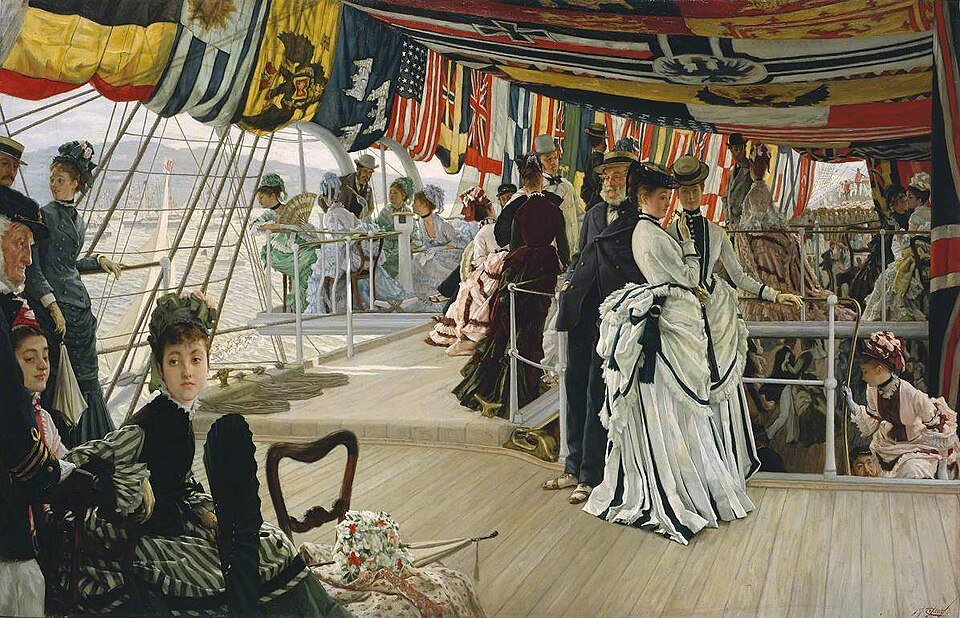
“The Ball on Shipboard” (1874)
Tissot believed London would be a source of patrons with money. He became a member of the Art Club in 1873. The member artists were popular with the wealthy industrialists of the day. The Industrial Revolution was changing the economy from hand-made to machine-made. From 1760 to 1830, iron and steel production, trains and ships powered by steam, use of electricity, use of machines in the production of goods, and advances in communication changed Britain and Europe. Tissot’s love of the sea, which he shared with Whistler, his interest in fashion, and his talent for storytelling communicated through his paintings appealed to numerous patrons.
“The Ball on Shipboard” (1874) (51”x33”) combines several of his interests. A variety of national flags are sewn together as an awning. People are enjoying a sunny day. Many of them are beautiful young women dressed fashionably. Some walk about the deck, some sit in mixed company groups, and others go below deck. It is interesting to note that most of the men are older.
Tissot continued to paint images of society, and the sale of his paintings added to his wealth. However, critiques were mixed. John Ruskin described Tissot’s paintings as “mere painted photographs of vulgar society.” The writer of an article in The Athenaeum said there were “no pretty women, but a set of showy rather than elegant costumes, some few graceful, but more ungraceful attitudes, and not a lady in a score of female figures.” Another critic found the piece “garish and almost repellent.” Despite the British Victorian prudishness, prominent art dealer William Agnew, purchased “The Ball on Shipboard” and easily sold it for a nice profit.
Degas invited Tissot to show his work in the first Impressionist exhibition in 1874. Tissot refused, but remained friends with Degas and Manet and others of the Impressionist group
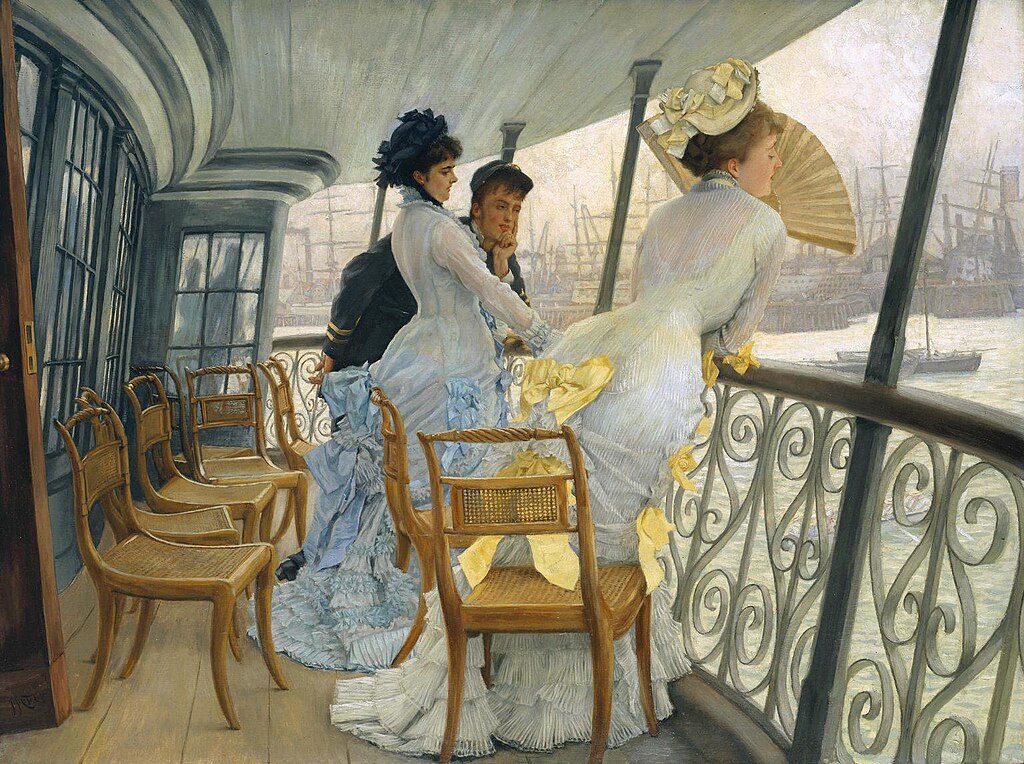
“The Gallery of the HMS Calcutta, Portsmouth” (1876)
Victorian society was gender-segregated, which resulted in social and sexual tensions. Tissot represented this tension in “The Gallery of the HMS Calcutta, Portsmouth” (1876) Both women are dressed in white, a popular color choice at the time, and their dresses are decorated with bows and ribbons. The hourglass figure is achieved with a tight bodice over a corset. The woman with yellow bows holds a large fan in front of her face, not looking at the junior naval officer and the woman next to him. Fans were used for secret messages. An open fan at the left ear meant “do not betray our secret.”
Curves are plentiful in Tissot’s composition, from the curves of the ladies to the curves of the wicker chairs on deck. Even the shape of ship’s gallery, a type of balcony at the back of a ship that houses the officers’ quarters, is curved. Questions about motives and relationships abound.
American-British writer Henry James, whose novels often told the story of marital situations between English and Europeans, described the painting as “hard, vulgar and banal.” Another critic suggested Tissot chose to name the ship Calcutta because it was a play on words from the French “Quel cul tu as” (What an arse you have). The painting was exhibited in 1877 and was sold to Johon Robertson Reid, a Scots painter who became president of the Society of British Artists in 1886.
There may be another reason the ship was named Calcutta. It was a second-rate British ship of the line with 84 guns. Built in Bombay in 1831, it was recommissioned to serve in the Crimean War in the Baltic. It also served from 1856 until 1858 in the second opium war in the Far East. In 1858, Calcutta was the first ship of the line to visit Japan.
Tissot met the Irish beauty Kathleen Newton in 1875, and the couple formed a strong relationship until her death from tuberculosis in 1880. Since she was a divorced Irish Catholic, they could not marry. However, they lived together openly and had a son, Cecil George Newton (b.1878). Kathleen was Tissot’s lover, companion, and muse. She was frequently a female figure in his paintings. After her death, Tissot sold the London house and moved back to Paris. He became interested in spiritualism, popular at the time, and even held a séance.
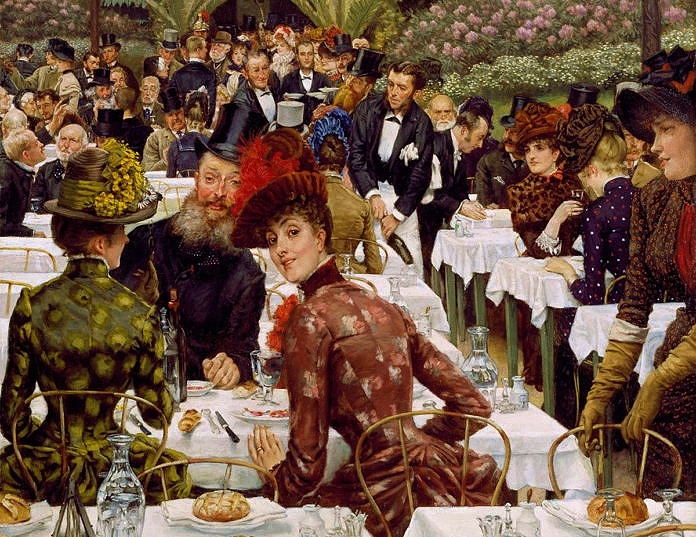
“Artists and their Wives” (1885)
“Artists and their Wives” (1885) (58’’x40’’) is a depiction of well-known painters and sculptors attending the celebratory lunch on Varnishing Day at the restaurant Le Doyen in Paris. Varnishing day was the day before the opening of the Paris Salon when artists put the final coat of varnish onto their paintings. The artists and their friends could then view the exhibition privately before it was opened to the public the next day. The painting was exhibited at two solo exhibitions, in Paris in 1885 and in London in 1886.
After the death of Kathleen, Tissot painted a series of 15 paintings titled “The Women of Paris” (1885). A Roman Catholic, he also turned his attention to religion. He began a series of paintings that he believed told the truth of the Bible stories of the life of Christ. He traveled to the Holy Land several times between 1886 and 1896. He produced 365 watercolor images, of which 270 were published in a book that became a bestseller. After finishing the project, he began a series of pictures based on Old Testament stories. He died before he could finish the project.
After 11 years in London, Tissot never surrendered his French citizenship. One of his biographers described him “the most English of all French painters.”
The writer of an article in the journal L’Artiste (1869) concluded, “While our industrial and artistic creations may perish, and our customs and our costumes may fall into oblivion, a painting by Mr. Tissot will be enough for archaeologists of the future to reconstruct our era.”
Beverly Hall Smith was a professor of art history for 40 years. Since retiring to Chestertown with her husband Kurt in 2014, she has taught art history classes at WC-ALL and the Institute of Adult Learning, Centreville. An artist, she sometimes exhibits work at River Arts. She also paints sets for the Garfield Theater in Chestertown.
The Spy Newspapers may periodically employ the assistance of artificial intelligence (AI) to enhance the clarity and accuracy of our content.
The Spy Newspapers may periodically employ the assistance of artificial intelligence (AI) to enhance the clarity and accuracy of our content.
Italian artist Giuseppe De Nettis (1846-1884) was born into a wealthy family in Barletta, Italy. He trained for a short time in the Italian classical style of painting. At the age of 21, he moved to Paris, the heart of the art world at the time. He was engaged by Adolphe Goupil, founder of Goupil & Cie (1850), the leading art dealer and publisher in Paris in the 19th Century, to create saleable genre paintings. His works were exhibited in the Salons, and he received a Gold Medal and was made a member of the Legion of Honor. He became a success and his work was in demand.
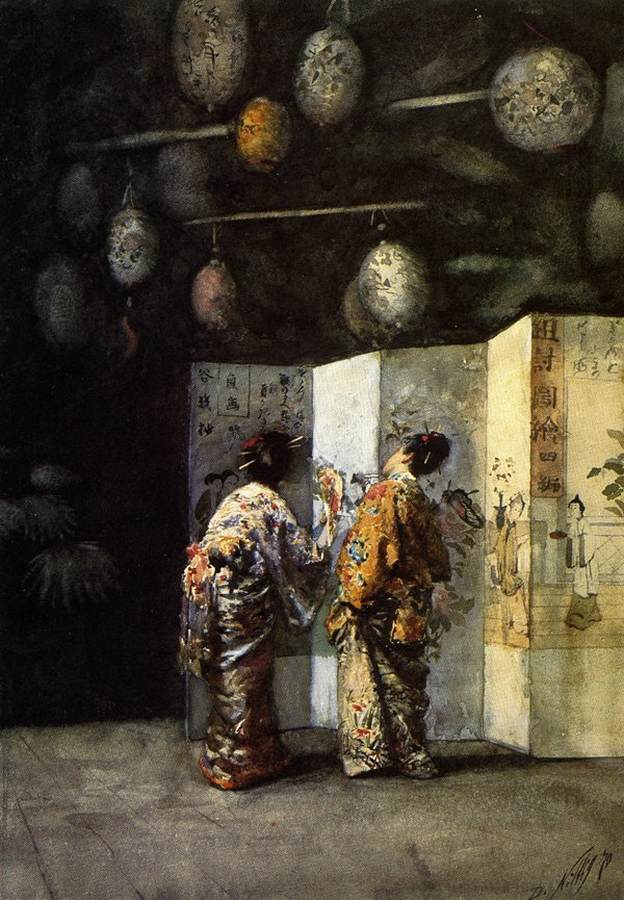
“Japanese Ladies Admiring a Screen” (1870)
“Japanese Ladies Admiring a Screen” (1870) (watercolor and pencil) (14’’x11’’) responded to the interest in Japanese ukiyo-e prints that were introduced to France in the 1860s. The prints were among De Nettis’s early purchases of art. The patterns of Japanese silk kimono fabrics and the lanterns and screens fascinated French patrons and artists alike. Van Gogh amassed one of the largest collections of ukiyo-e prints. The classical style of painting that De Nettis learned is obvious in his use of traditional techniques of color and light. The composition is pleasing, and a prospective buyer would have enjoyed the lavish kimonos and the patterns on the lanterns and folding screens. The small scale would have appealed to buyers with moderate funds and normal size houses.
In 1869, De Nettis married Leontine Lucille Gruvelle (1842-1913), an accomplished and beautiful woman, who often served as his model. De Nettis fled Paris for London in 1870 to avoid the Franco-Prussian War and the siege of Paris from September 1870 until January 1871. Monet, Pissarro, and Sisley were among the artists who went to London, and Degas visited his family in New Orleans. On his return to Paris, De Nettis stopped in Italy and was the first artist to depict the eruption of the Mt Vesuvius volcano.
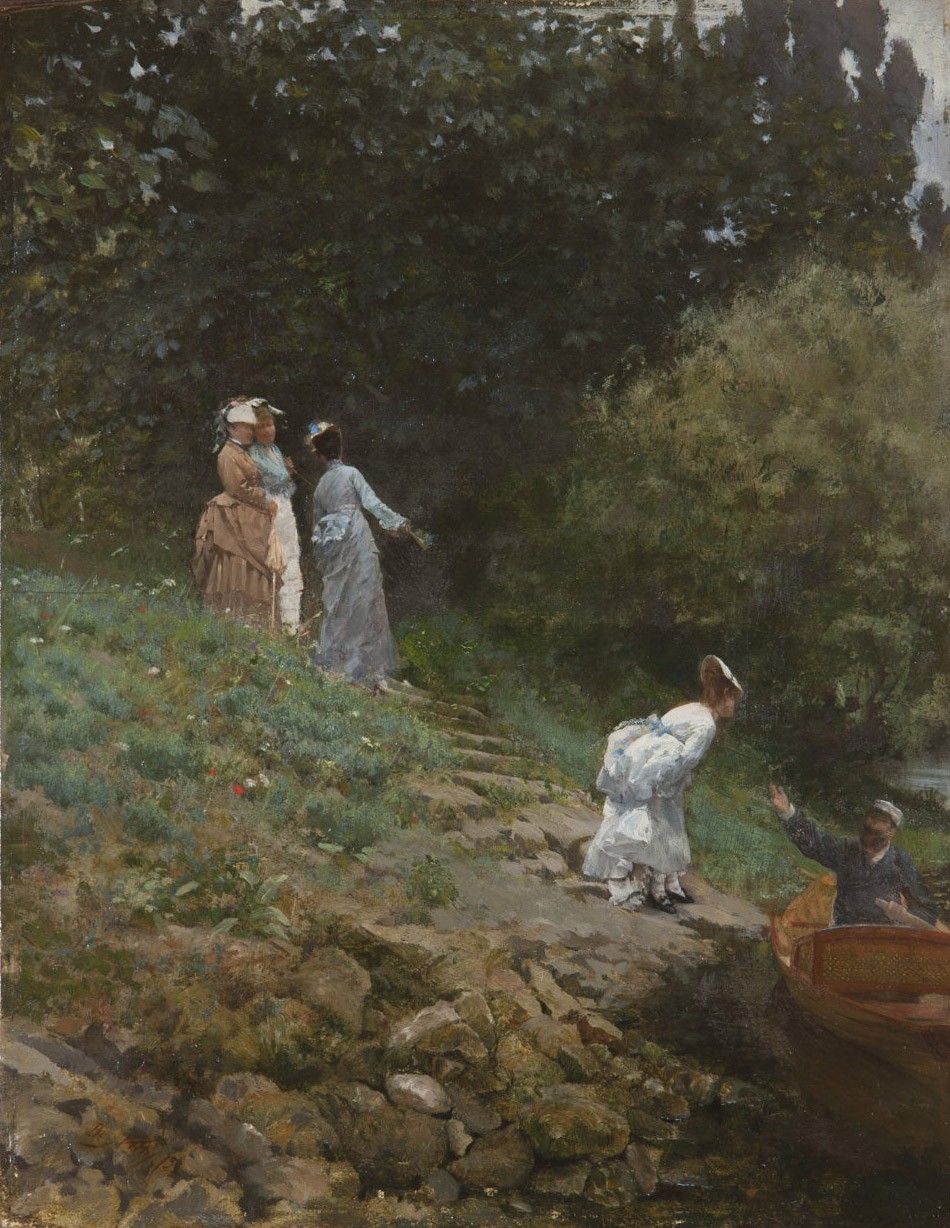
”La Grenouillere”
When De Nettis returned to Paris in 1872, he began painting cityscapes and the people of Paris. La Grenouillere was a floating restaurant on the Seine at Croissy-sur-Seine. It was a popular gathering place for Monet, Renoir, and other Impressionists. “La Grenouillere” (1873-74) (14”x11”) is a depiction of four fashionably dressed women, walking down a stone stairway to engage a boatman to row them across to the restaurant. The day is sunny and the flowers are popping out on the hill. The women perhaps anticipate a pleasant boat ride.
Having met several of the Impressionists, De Nettis began exploring some of their techniques: painting outdoors, exploring suggestive brushstrokes, and using the colors of sunlight to create shadows. For example, the shadows on the white dress of the woman engaged with the boatman are painted blue, not gray.
Degas invited De Nettis to show his work in the first Impressionist Exhibition in 1874. His five paintings, not well liked by some of the Impressionists, were hung in a dark spot. He did not show with them again. His work continued to combine elements of both Realism and Impressionism. De Nettis’s Paris home became a popular salon for artists, poets, writers, musicians and others, including Oscar Wilde, Alexander Dumas, and Emile Zola. De Nettis often cooked “lasagne alla Barlettana,” an Italian dish that received cheers from the guests, “Viva De Nettis.”
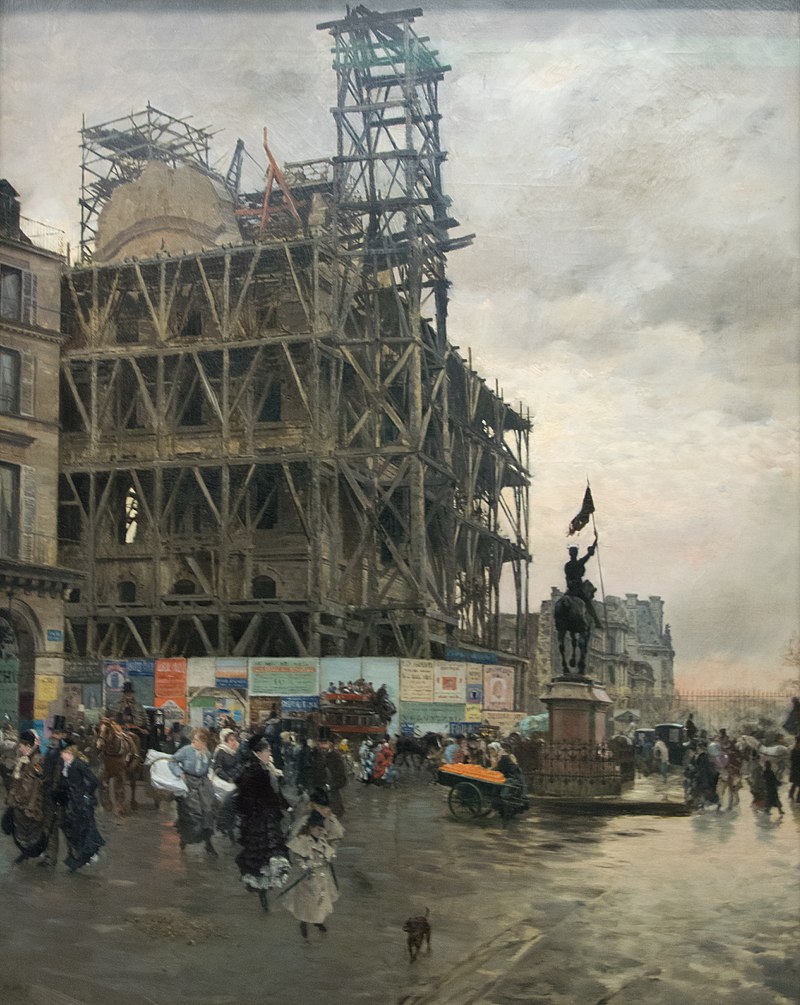
“Le Place du Pyramids” (1875)
De Nettis also chose to paint images of the reconstruction of famous landmarks that were damaged during the Franco-Prussian War. “Le Place du Pyramids” (1875) (36”x30”) is a depiction of an iconic Parisian location. It was named in honor of Napoleon’s victory in Egypt in 1789. The statue of Joan of Arc is prominent at the center. Advertisements cover the scaffolding around the building. Parisiens going about their daily business walk through the busy square, passing by market carts, carriages, and a horse drawn bus. The sky is gray and the pavement wet. Le Place du Pyramids is in the middle of Rue de Rivoli, near the eastern end of the Tuileries Gardens.

“Arc de Triomphe” (1875)
“Arc de Triomphe” (1875) (21”x16’’) is a depiction of another well-known Paris landmark, under scaffolding for repair of damage during the Franco-Prussian War. The painting represents the resilience of the Parisiennes. It is autumn, and the tree leaves have turned orange. A wealthy couple on horseback enjoy a ride along the Champs-Elysees. They have passed under the Arc de Triomphe. De Nettis was adept at painting horses, and like Degas, he often painted the races at Longchamp. People are about to cross the road, among them a red-haired woman in a bright plaid coat, a well-dressed woman in black, and a young girl wearing red socks. The trio is probably an upper-class mother, her daughter, and a maid or nanny.
The figures are painted realistically. The avenue is created with casual brushstrokes of a variety of beiges and browns, but also blues. Across the Champs-Elysees, the horse drawn carriage, people, trees, and distant buildings are more Impressionistic. De Nettis’s use of black paint throughout the painting distinguishes him from the Impressionists.
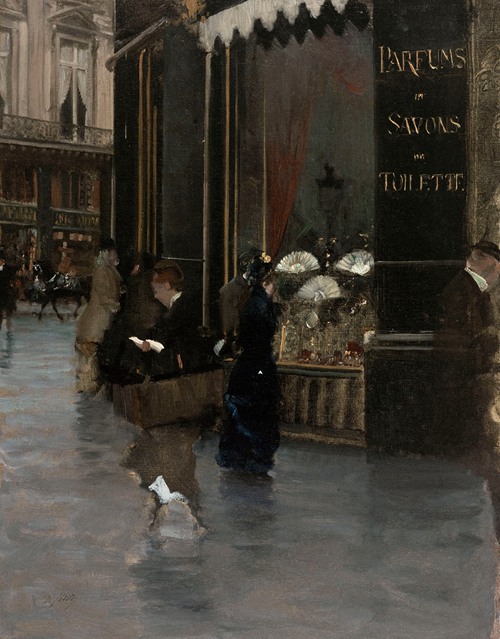
“La parfumerie Violet, on the Boulevard des Capucines” (1880)
“La parfumerie Violet, on the Boulevard des Capucines” (1880) is a depiction of what was one of the most elegant boulevards in Paris. The Maison Violet was opened in 1827 by Francois-Etienne Violet. Famous for its fragrances, its perfumes received a great many awards and patents for their scents. The studio of the famous French photographer Felix Nadar (1820-1910) was located at 35 Boulevard des Capucines. The rich and famous came there to have their photographs taken. The studio also was the location of the first Impressionist exhibition in 1874.
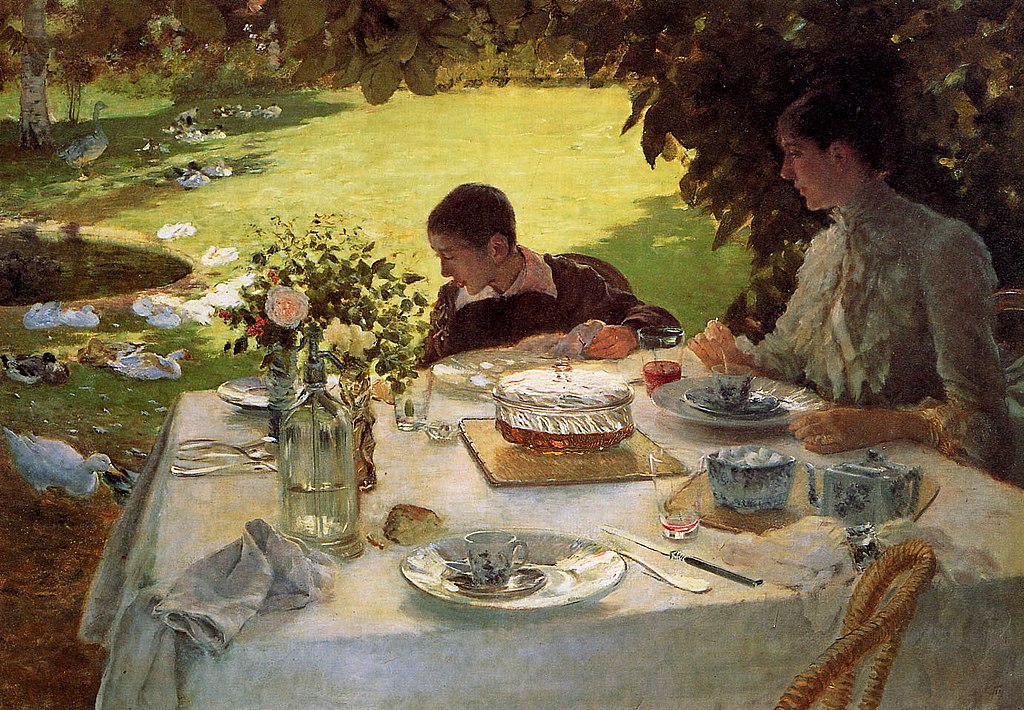
“Breakfast in the Garden” (1884)
“Breakfast in the Garden” (1884) (34”x46’’) is one of De Nettis’s last works. His beloved wife Leontine and their son Jacques sit at a table in the shade of overhanging trees, and they enjoy breakfast in the sunny garden. The table is set with coffee cups, silverware, a China cream and sugar set, a vase of spring flowers, and a white tablecloth with napkins. In front of the table is an empty wicker chair where De Nettis had sat. Leontine and Jacques concentrate on a curious duck that has come close. Other ducks are on the lawn and under the shade of nearby trees. De Nettis painted a happy time with his family. His skill at painting in the Impressionist style, when he wanted to, is fully visible.
During his short career, De Nettis painted in Paris, on yearly trips to London, and while visiting Italy. He was named Knight of the Order of the Crown of Italy in 1875.
De Nettis died in 1884 at the young age of 38 from a stroke. He was honored in 1886 with a memorial exhibition at The Galerie Bernheim Jeune in Paris. Other exhibitions followed. In1984, he was honored with a 300 lire postage stamp. Since De Nettis chose to go his own way at a time when the popularity of Impressionism was on the rise, his works became eclipsed for a time. Today, his work is considered among the best of his time.
Beverly Hall Smith was a professor of art history for 40 years. Since retiring to Chestertown with her husband Kurt in 2014, she has taught art history classes at WC-ALL and the Institute of Adult Learning, Centreville. An artist, she sometimes exhibits work at River Arts. She also paints sets for the Garfield Theater in Chestertown.
The Spy Newspapers may periodically employ the assistance of artificial intelligence (AI) to enhance the clarity and accuracy of our content.

Modern geometric design harmonizes with pristine waterside surroundings.
It’s not often that I find a contemporary house to feature, so I when I went online and saw this unique contemporary house near Cambridge, I immediately contacted the listing agent to arrange a visit. On the day of my tour, I drove along the gravel entry drive between walls of tall phragmites and towering Loblolly pines to discover this contemporary waterfront estate on 11.88 private acres with 1,500 feet of shoreline along serene Brooks Creek.
Built in 2007, the “Y” shaped house has a coastal layout with a compact footprint for minimal disturbance of the site. Its geometric “Y” shape reaches out to maximize water views and its turret peeks through the blue metal roof at the intersection of the three wings of the house for bird’s eye views of the surrounding landscape and water.
Since the temperature on the day of my visit was in the mid 90’s, I was very grateful to park my car at the ground level under the shade of the second floor. In addition to parking, there is a deck and a low ramp to a one-car garage next to the house. Two sets of stairs lead up to the second floor; at the front of the house, one set goes up to the main entry’s covered porch with its blue metal roof.
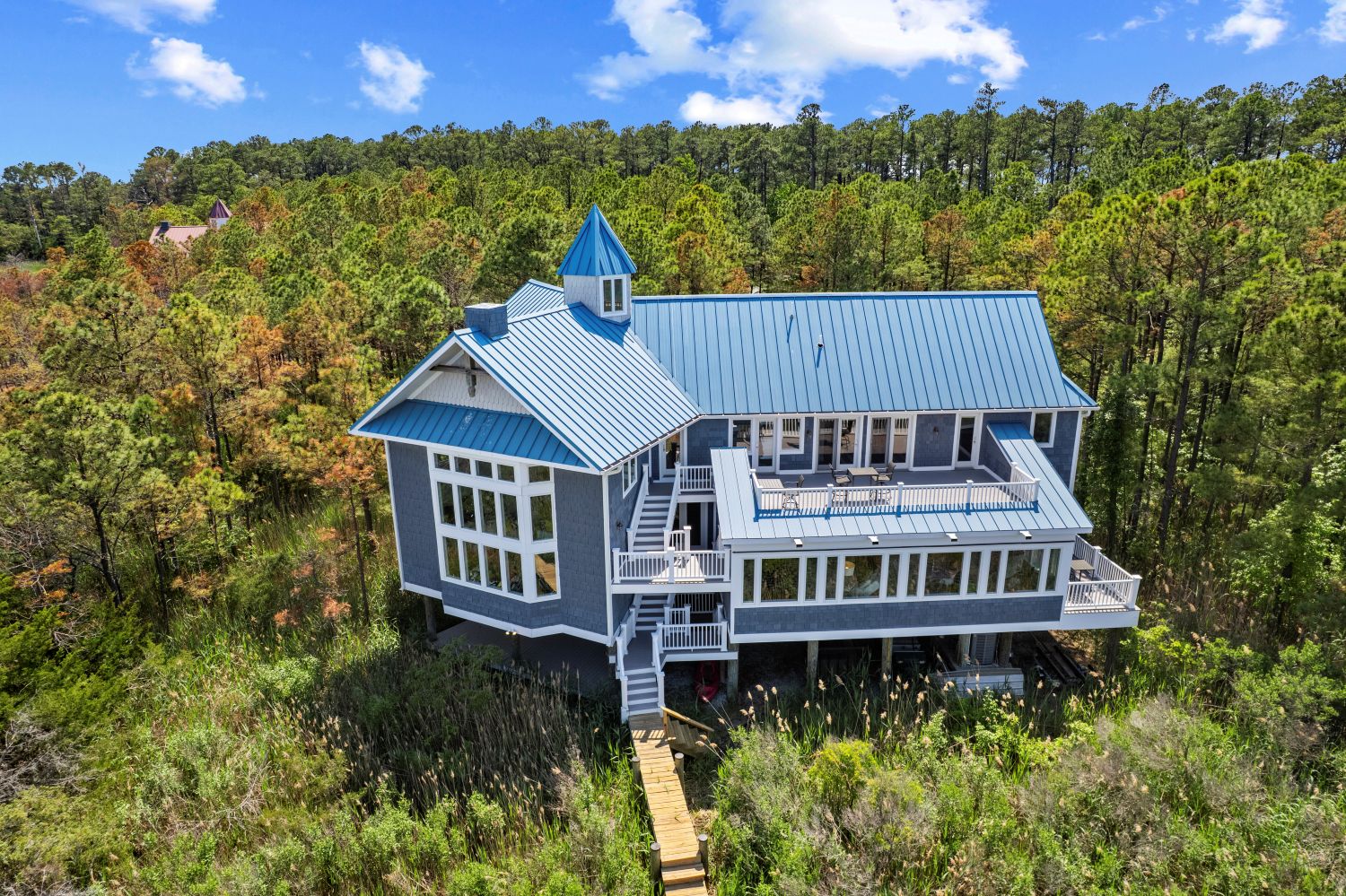
Elevated structure connects effortlessly with expansive shoreline views.
At the rear of the house, a half flight of steps leads from the parking level to the landing of the second set of stairs for access to both the long elevated walkway to the pier and also to the third floor deck. The house floats above the site and the multiple windows from the two-story bay wall projection, the wrap-around windows at the second floor and the windows and doors at the third floor offer unobstructed panoramic views of Brooks Creek. I walked to the end of the long pier and turned back to admire the massing of the house with its blue and white color scheme that stands out against its green surroundings.
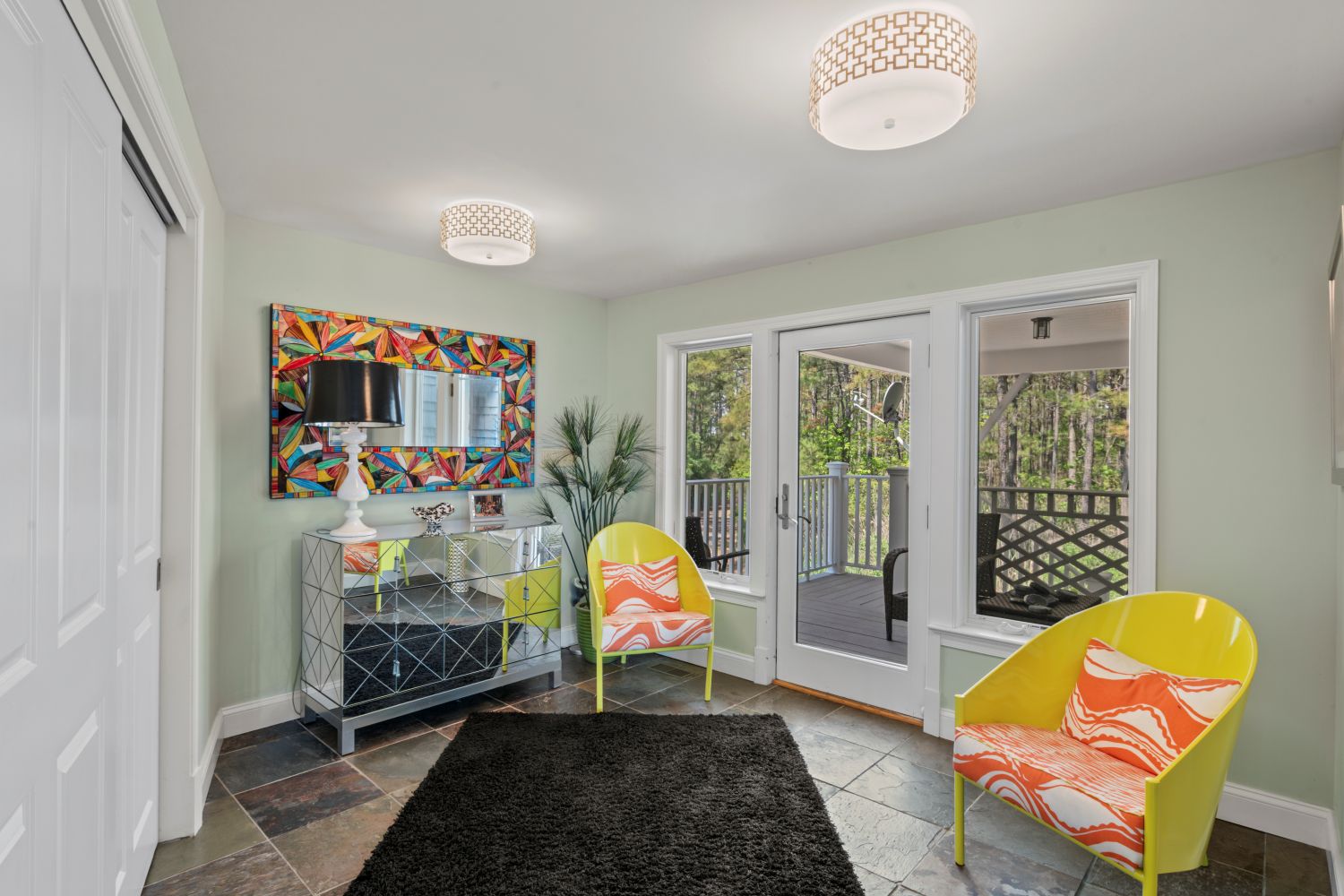
Flagstone flooring and vivid accents warmly transition to sleek interiors.
The large front porch furnished with a group of rattan seating leads to the foyer with flagstone flooring and neutral wall color. The splashes of color in the bright yellow chairs, red and white cushions and the multicolored mirror frame introduce the contemporary interior design. As I walked through the foyer, the vista opened up to the reveal the open plan dining room-living room.
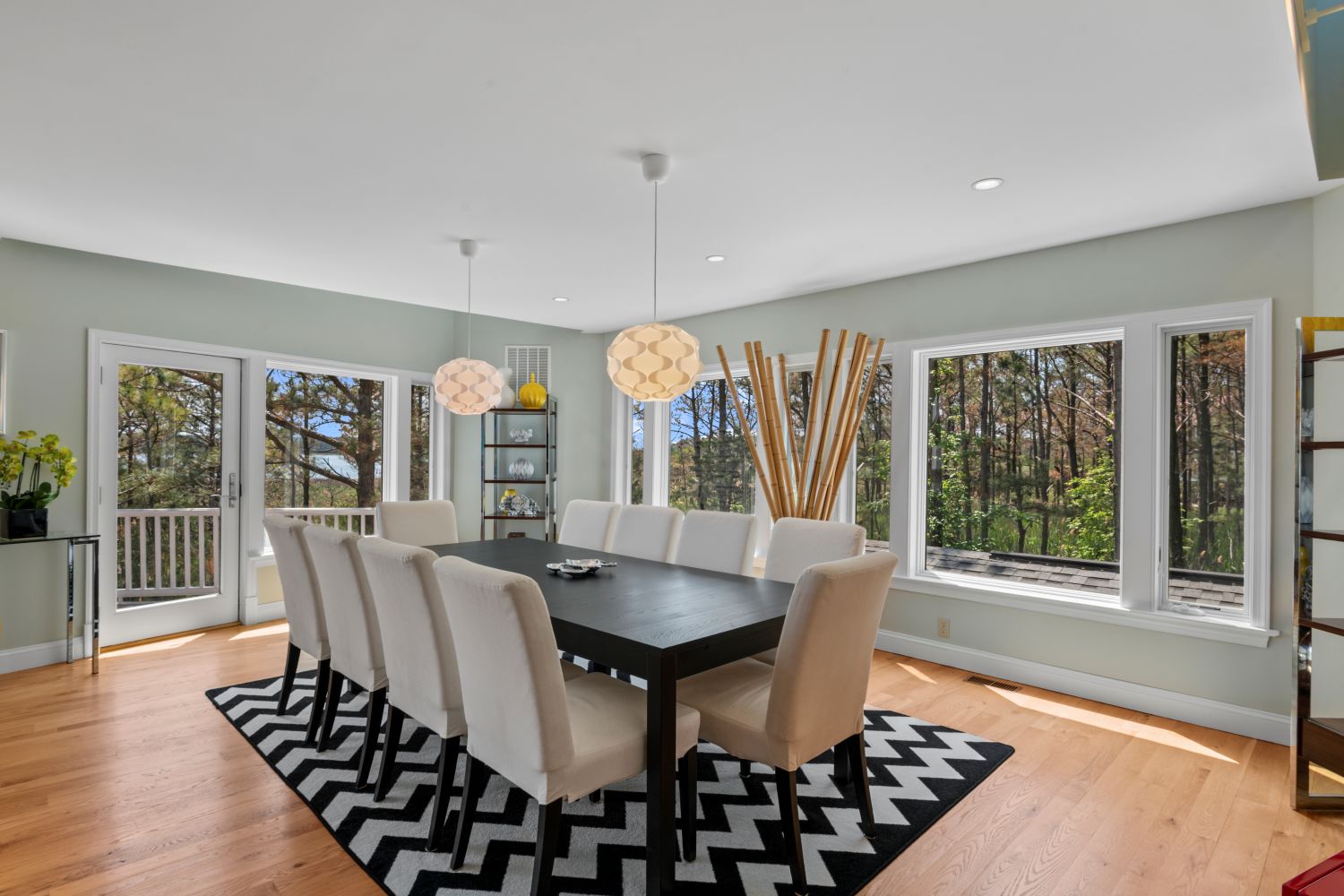
Contemporary lines and bold textures invite seamless entertaining.
The spacious dining room accommodates the long black table with its sleek lines and ten chairs, anchored by the rug with its kinetic black and white design. The beautiful wood floors flow into the living room and family room. The side wall of two pairs of wide picture plane windows with operable units open up the space to the landscape. The other wall with a glass door, picture plane window and another operable unit leads to the adjacent deck for water views. The deck is the perfect spot to set up one’s grille for summer entertaining.
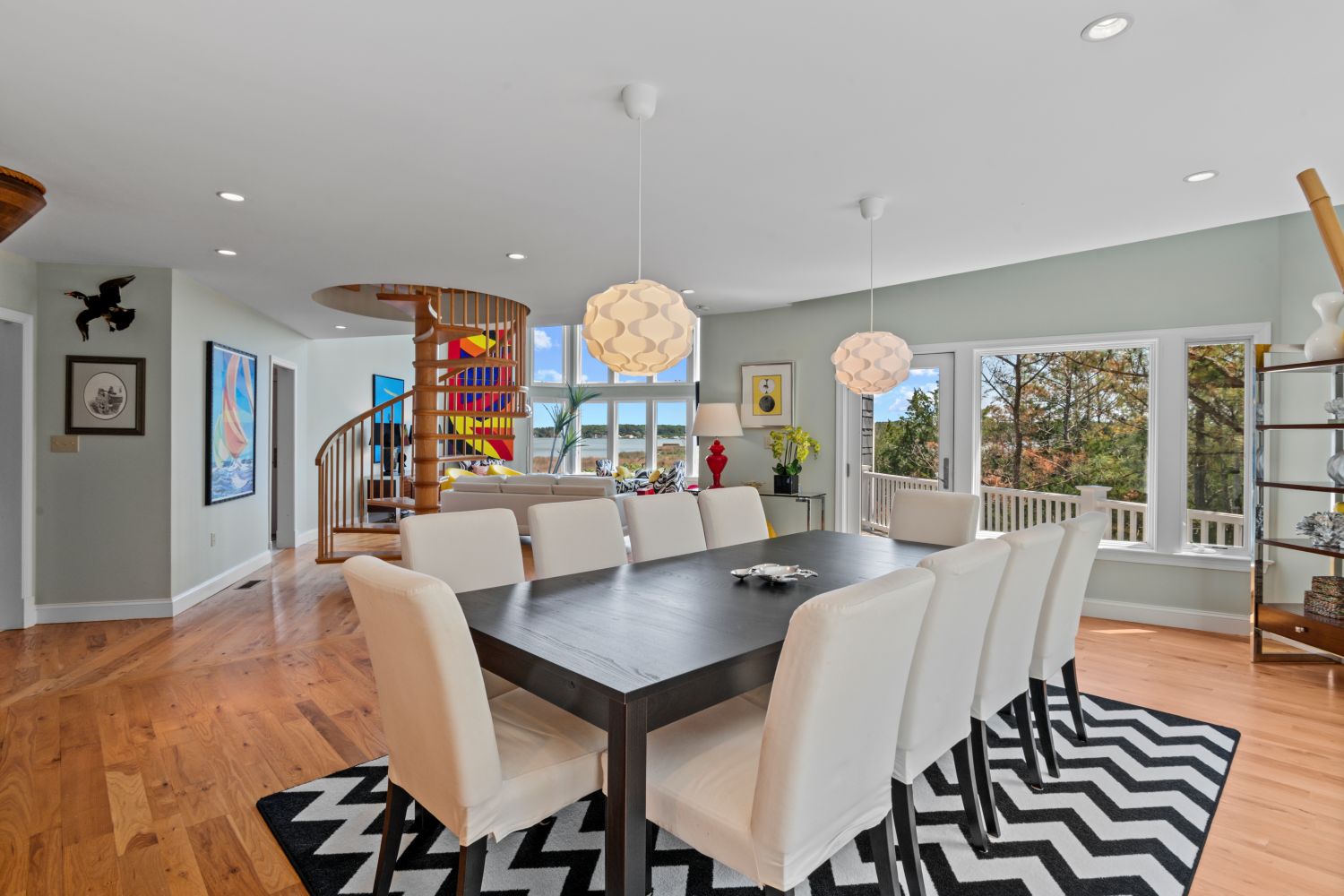
The oak spiral stair serves as a sculptural anchor amidst open vistas.
From the dining room, the focal point is the solid oak circular stair that connects the second and third floors. The stairs then penetrate the second floor ceiling to the turret above with windows on two walls for fantastic bird’s eye views of the landscape and Brooks Creek. From the table, the angled vista through the living room’s bay wall projection infilled with windows offers views of Brooks Creek.
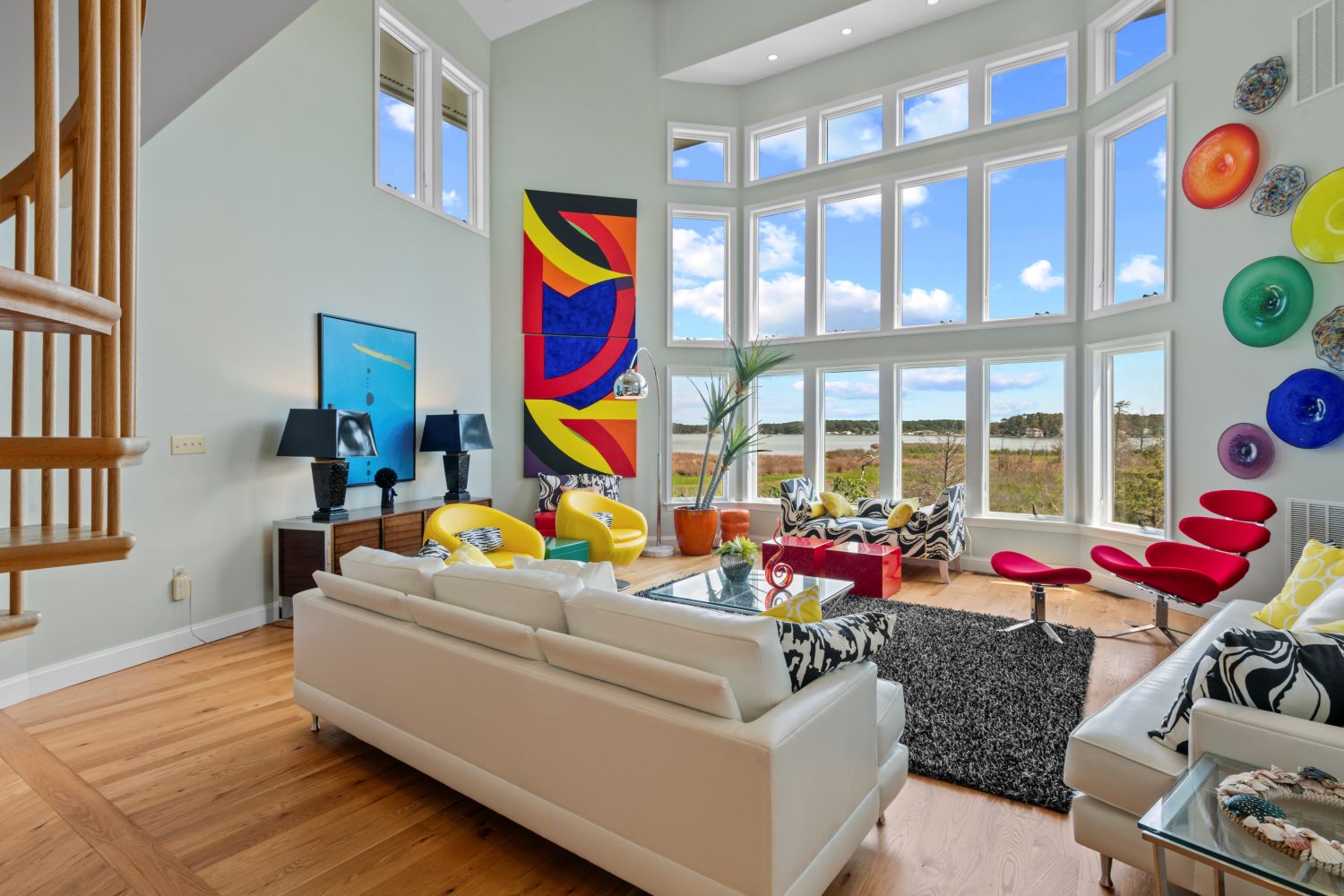
Two-story bay windows frame endless landscapes and shimmering waters.
The living room’s two-story high bay wall of windows offers long views of the landscape and water and I imagine a starry night filled with stars is even more spectacular. The high windows at the side wall bring in additional light to keep this room sunny all day. I loved the colorful art accents, especially the abstract panels on the angled wall that reminded me of Frank Stella’s work.
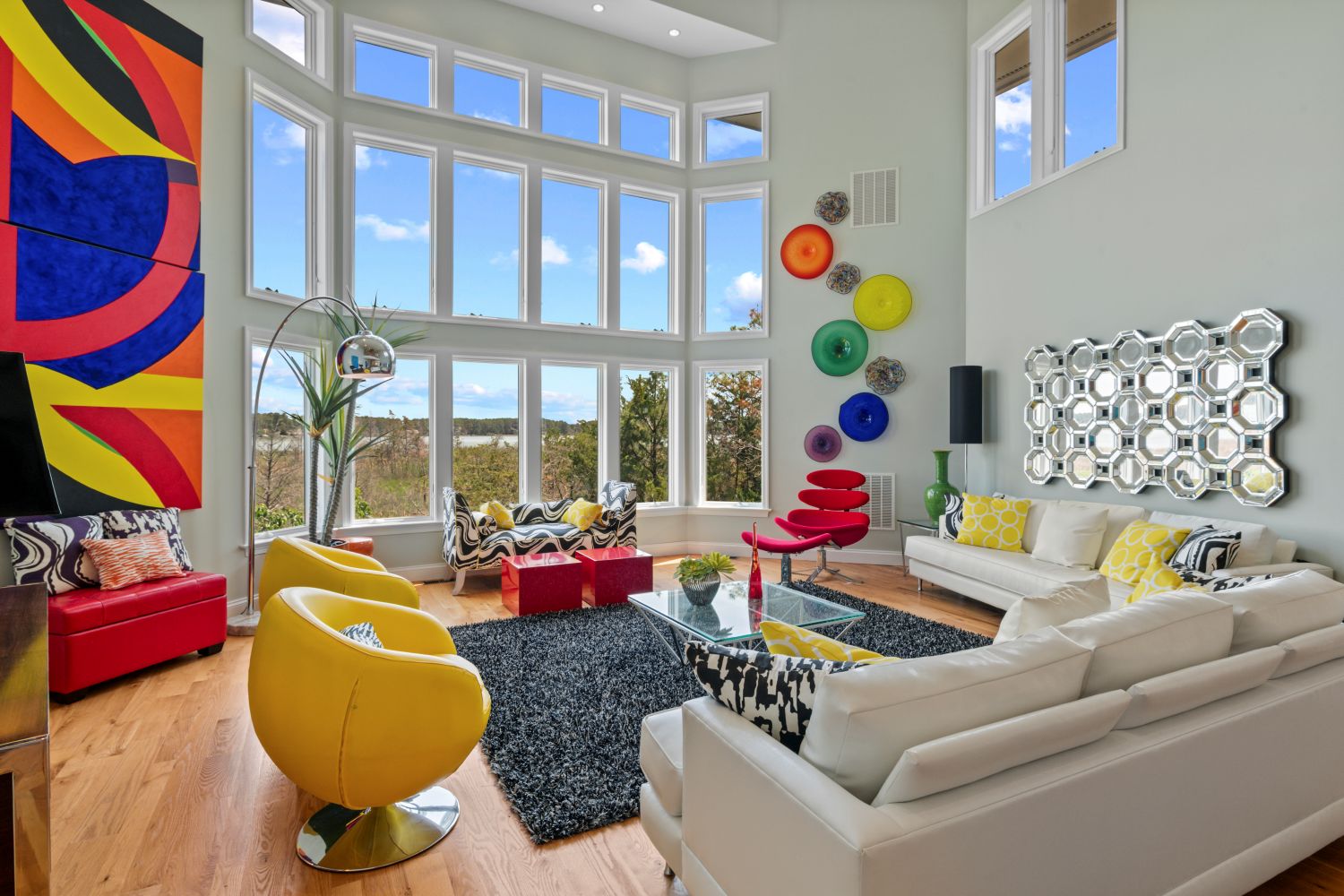
Sunlit accents and bold artwork create a cozy respite by the window. The home’s soft gray walls and neutral floors provide an opportunity for personalization throughout.
At the other side wall, another pair of high windows continues the sun’s daily path across the room. The mix of the two full length sofas’ neutral upholstery with accents of bright primary colors creates a fun space for relaxing with family and friends. I especially liked how the bench in front of the window wall is strategically placed for the family pet to doze in the warmth of the sun.

Sweeping angles and textured finishes unite functional spaces beautifully.
The overlook at the third floor above the sofa define the edge of the Living Room. The oak circular stair becomes a sculptural element and I admired how the railing at the overlook matches the spindles of the stair. The sweeping, angled vista from the living room to the dining room, foyer and kitchen gives depth to the spatial volume.
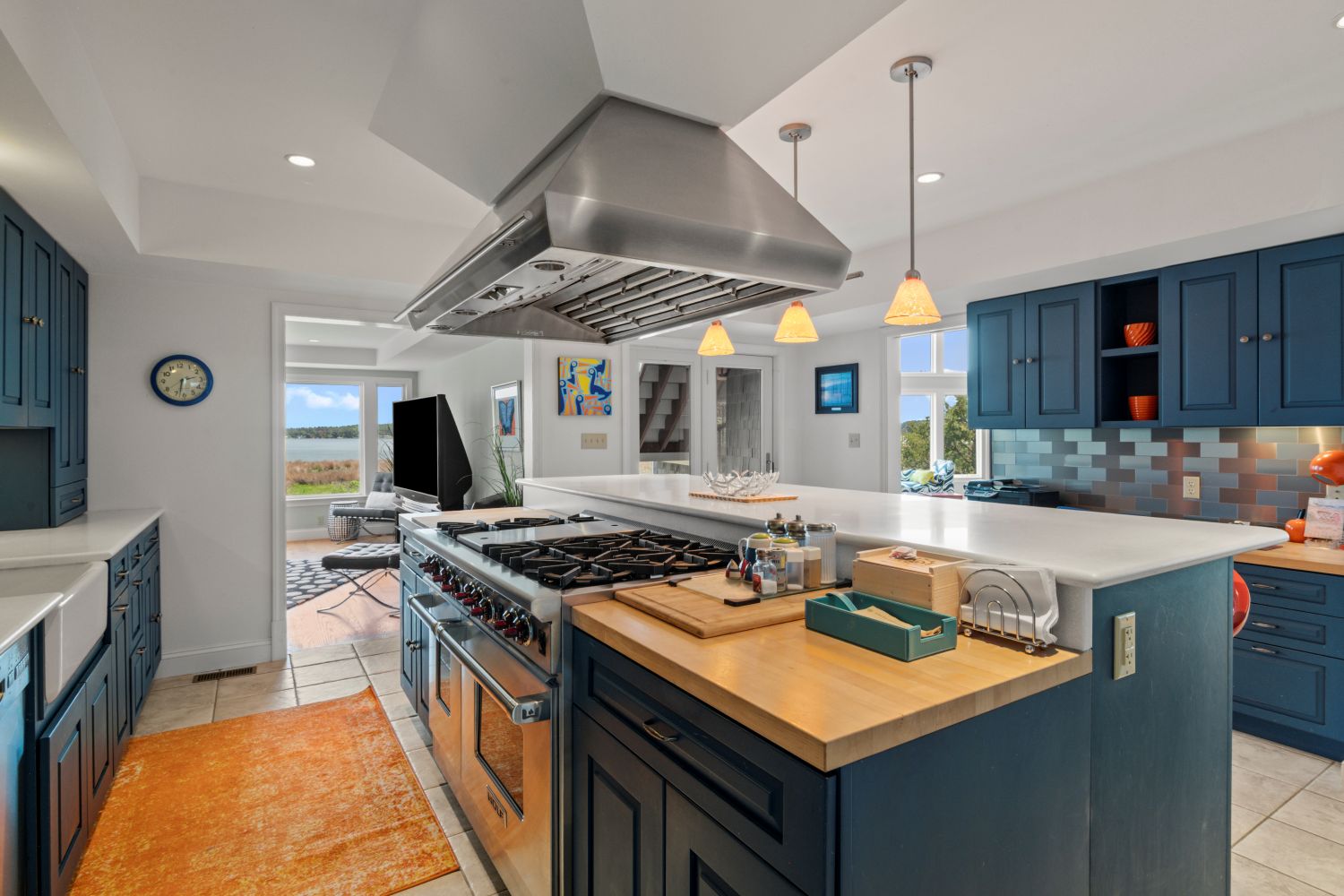
Elegant details shine in the gourmet kitchen, which boasts rich blues and panoramic water views.
The blue theme of the exterior siding and roof continues into the gourmet kitchen whose top tier appliances including a Subzero Wolf R/F would please any chef. The ceiling is detailed with a soffit above the upper cabinets for ambient lighting and the stainless steel hood for the Wolf stove is connected to the upper ceiling by sloped planes of drywall. The marble countertops stand out against the deep blue cabinets and the backsplash’s interlocking two-toned colors adds a playful touch. The wide wall opening between the kitchen and the adjacent family room gives the cook a water view. Behind the kitchen is a hall that leads past the laundry closet to the primary ensuite.
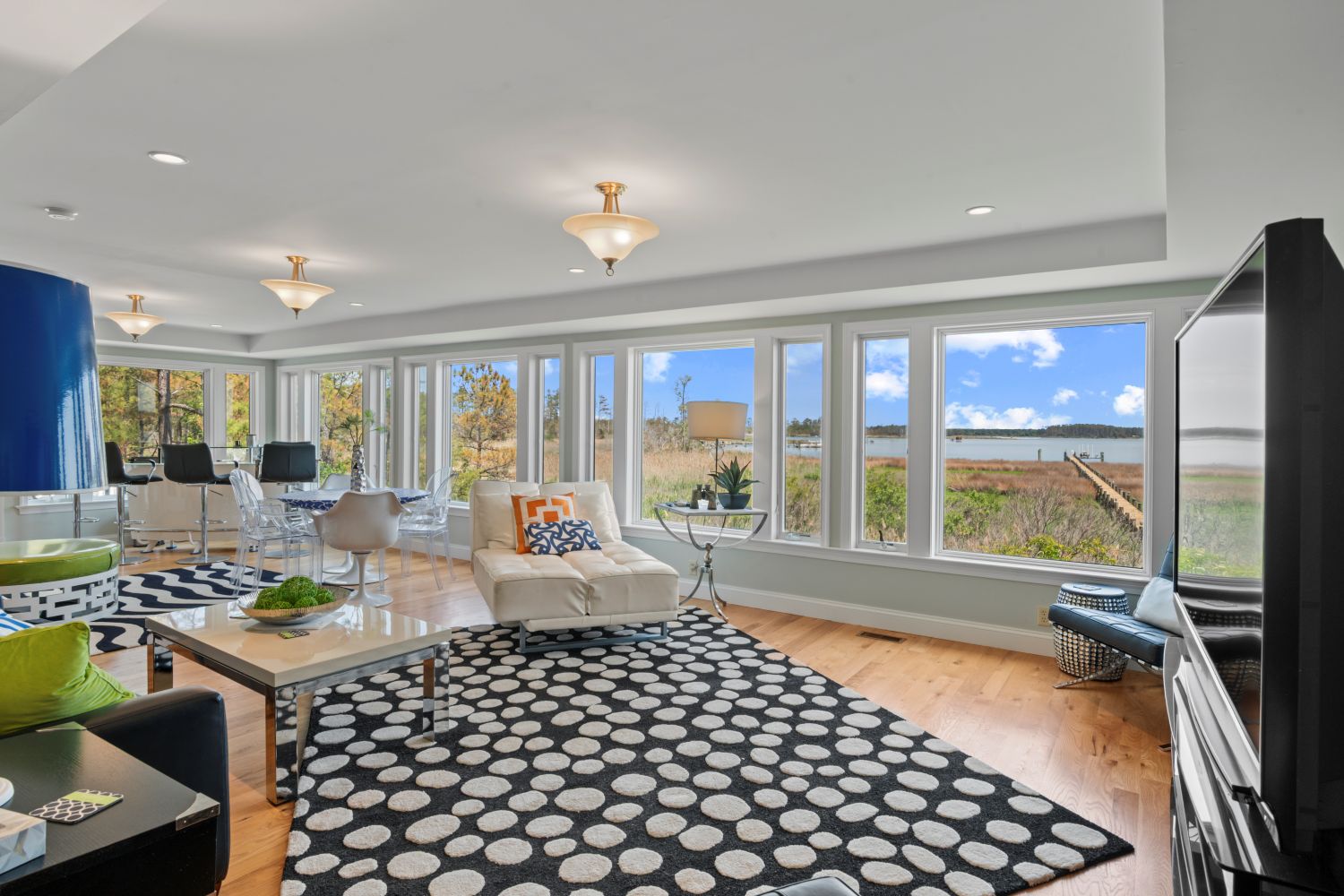
Wrap-around windows immerse guests in tranquil Brooks Creek scenery.
The family room extends across the length of the long leg of the “Y” floor plan. Like the dining room, the mix of the windows’ tall picture planes and operable units wrap around the corner of the room to the side deck to offer panoramic views of the serene landscape to Brooks Creek and the opposite shoreline.
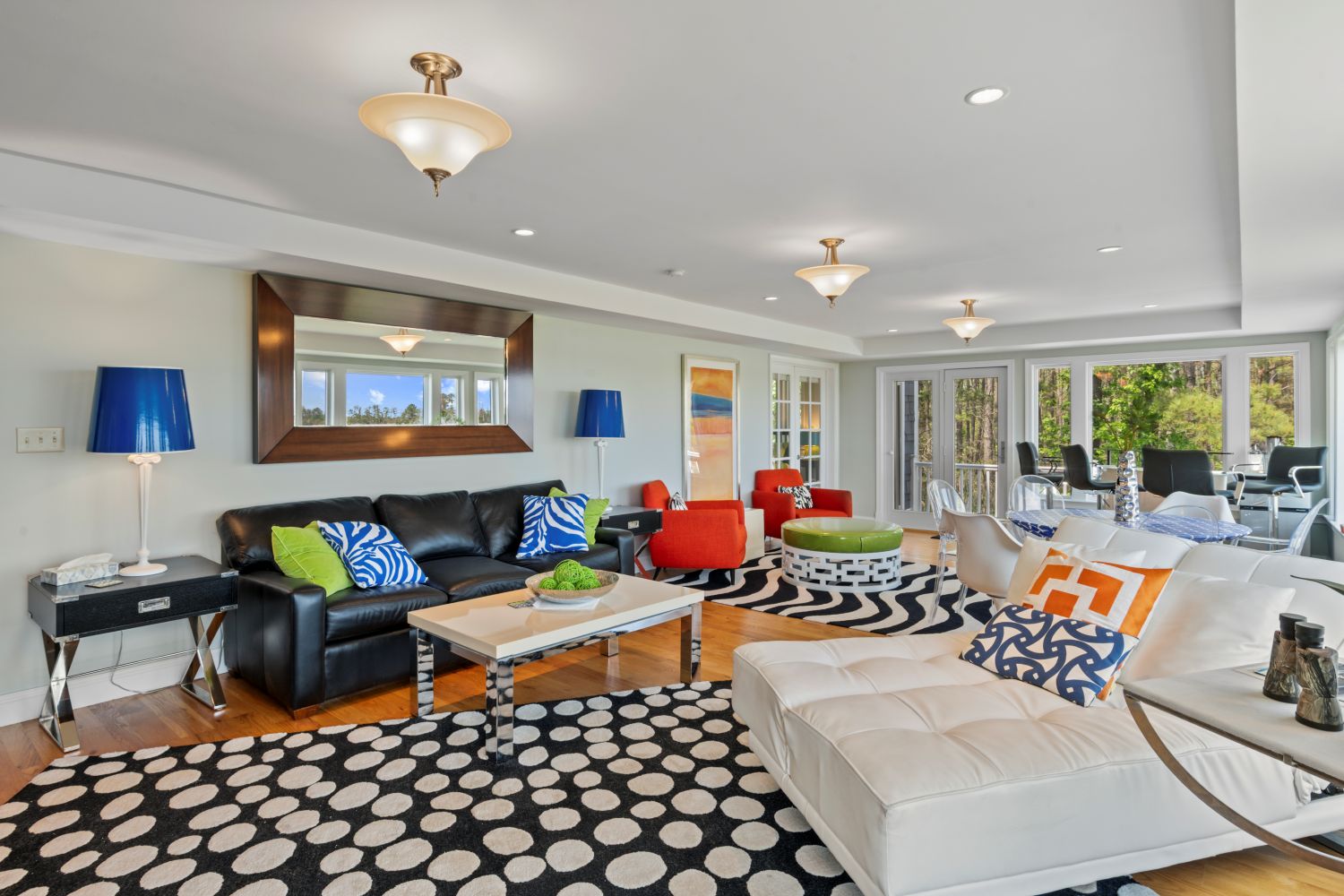
Laid-back comfort meets functionality with easy access to decks, and ensuite.
The spacious family room is a great space for relaxing with family and friends since it offers a range of seating groups from the two sofas for watching TV, the red chairs with a large ottoman for relaxing with a book or quiet conversation and the bar stools at the corner bar area. Double doors lead from the bar area to a deck and the pair of French doors at the corner lead to the primary ensuite.
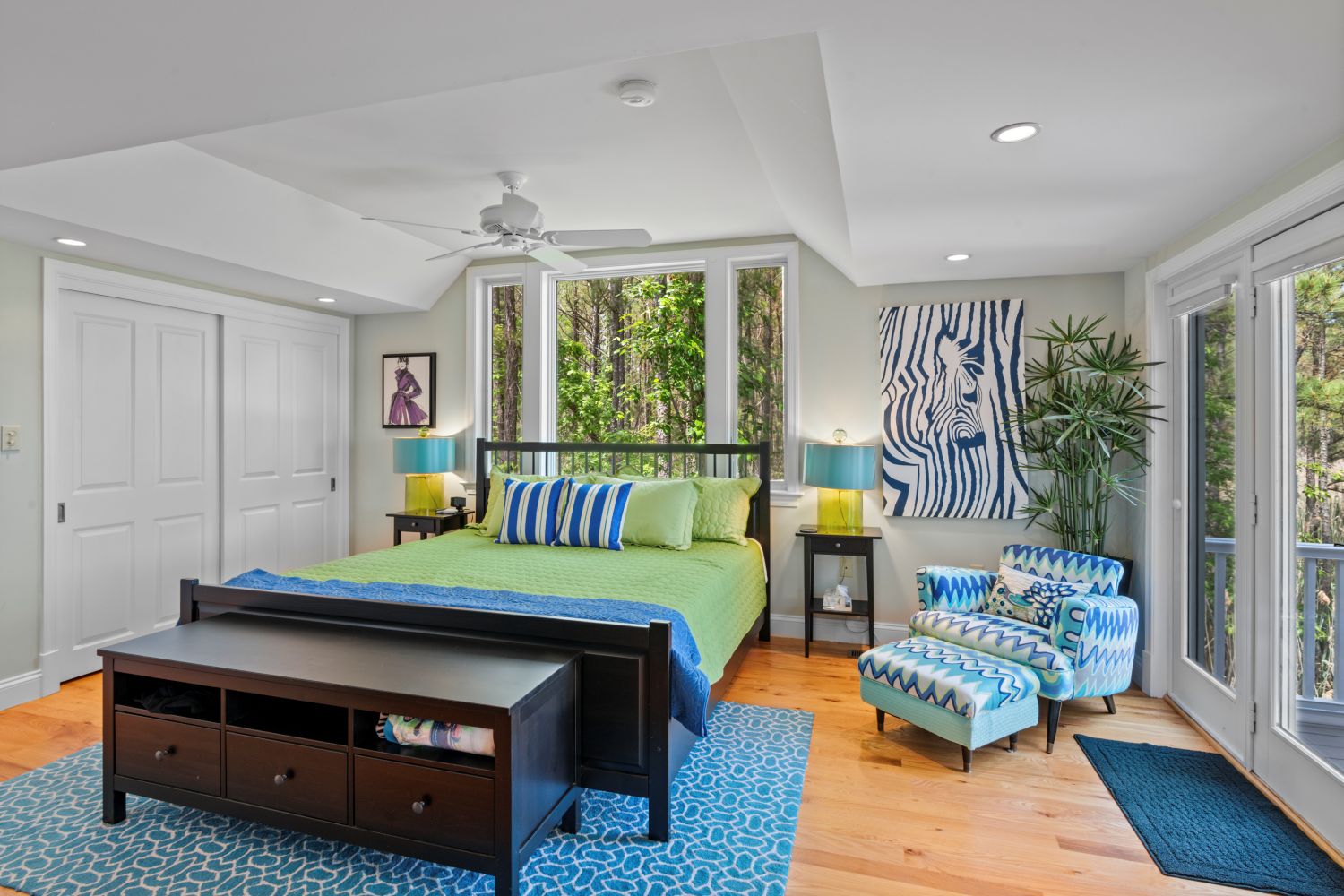
Playful ceiling slopes reflect the serene outdoor hues in a peaceful bedroom retreat.
The primary bedroom is located at the quiet corner of the house. Sloped ceiling planes break up the flat areas for added height and the wide window and the doors to the deck offer abundant sunlight and views of the landscape and water. I loved the hues of this delightful room’s blue and green color scheme and I especially liked how the wavy designs of both the art, the chair and ottoman add a touch of whimsy.

From morning’s first light to day’s end dusk, uninterrupted water views give you an outside-in vibe.
From the bed, one has long views of the water from both the deck and the family room’s windows. The deep soffits contain the HVAC and downlights and the tray portion of the ceiling easily accommodates a ceiling fan at the top of the ceiling.
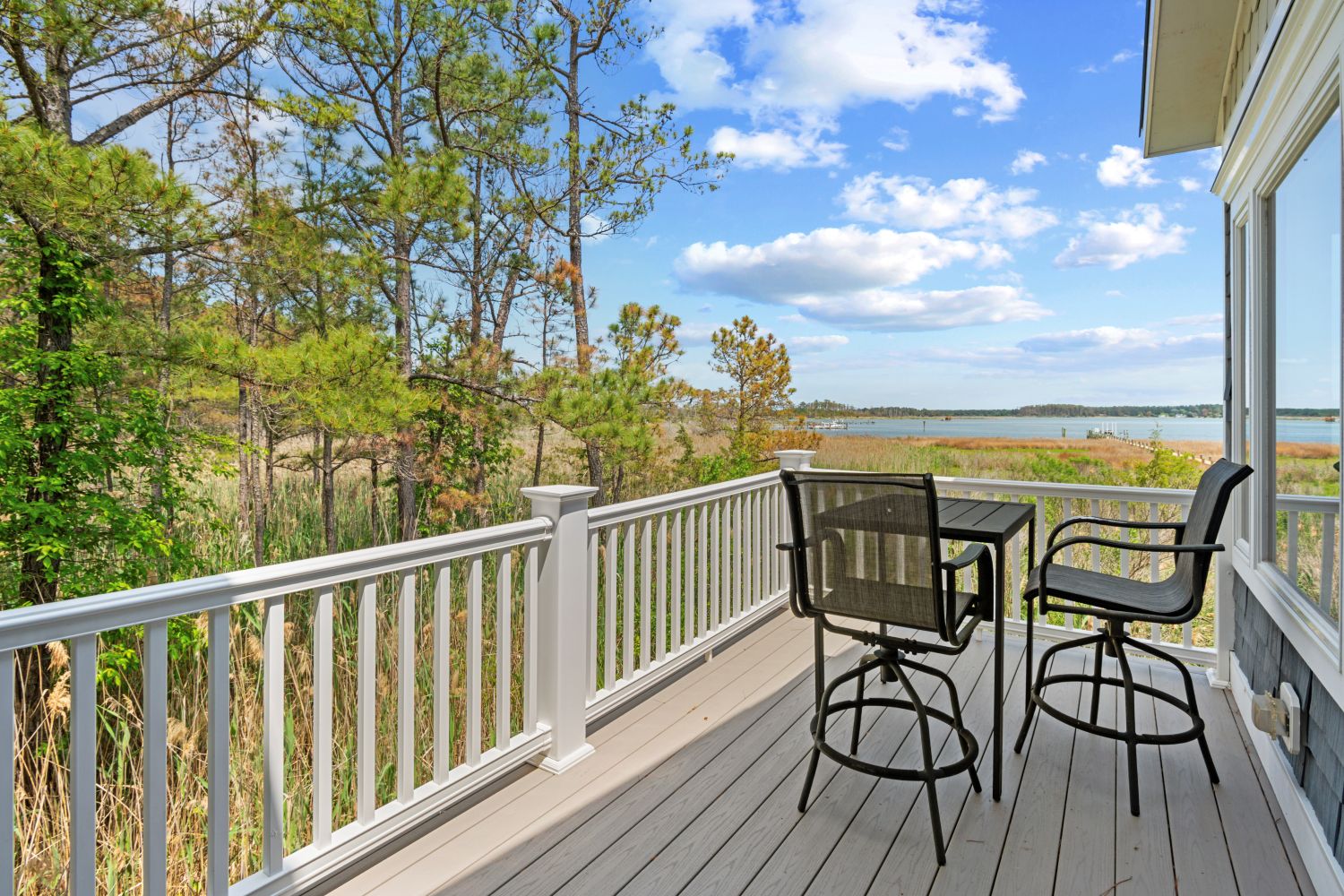
A serene spot for sunrise contemplations or twilight relaxation.
This cozy deck off the primary bedroom and the family room’s bar area is the perfect spot for watching the sun rise over the far horizon or a quiet spot to relax at the end of the day.
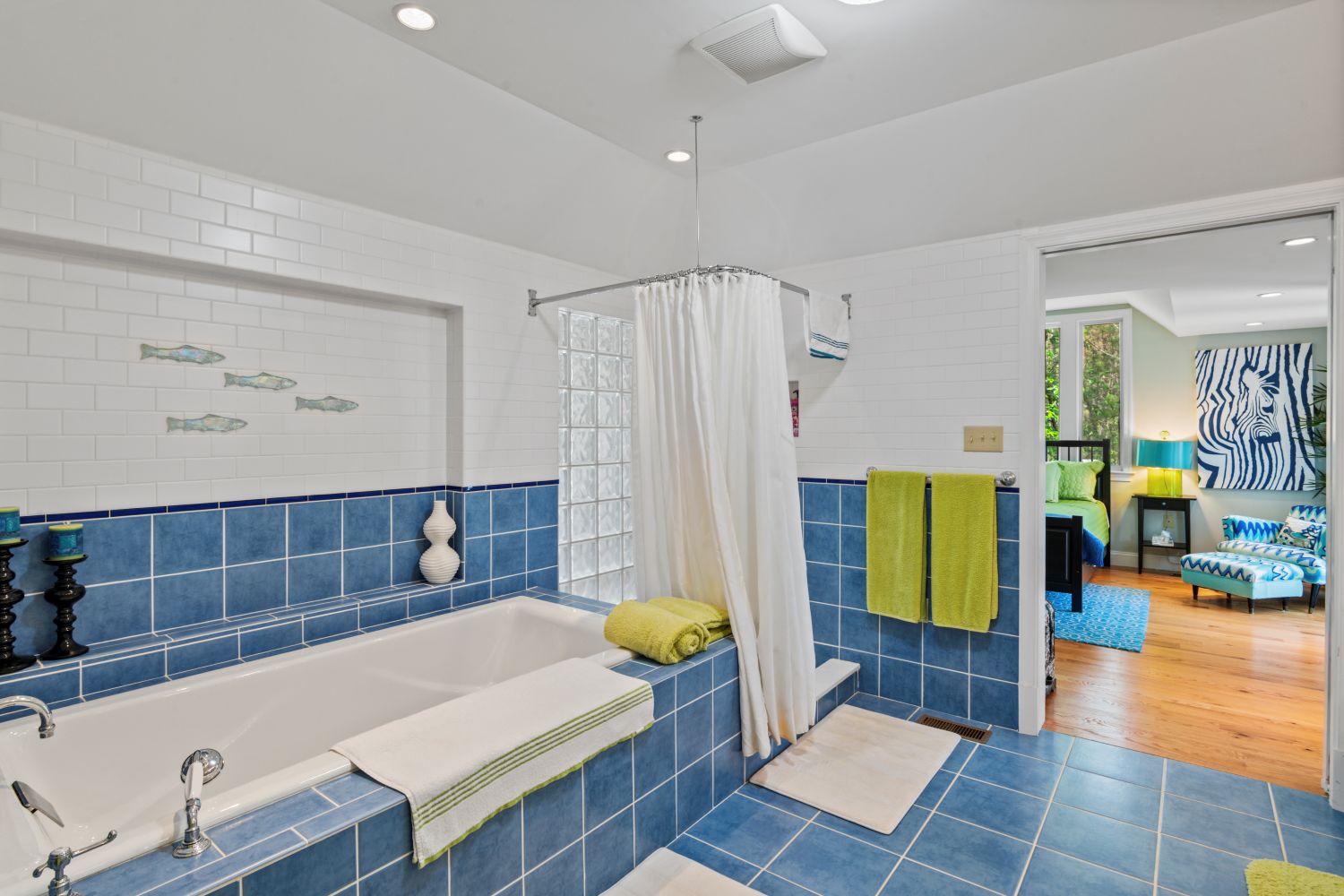
Innovative use of glass blocks channels light beautifully into the room.
The five-piece primary bath is located between the family room and the hall to the primary bedroom so it has no exterior window. I admired the Owner’s clever solution of installing glass block at the full height and depth of the shower wall so light filters into the bath from the adjacent hall’s exterior window.
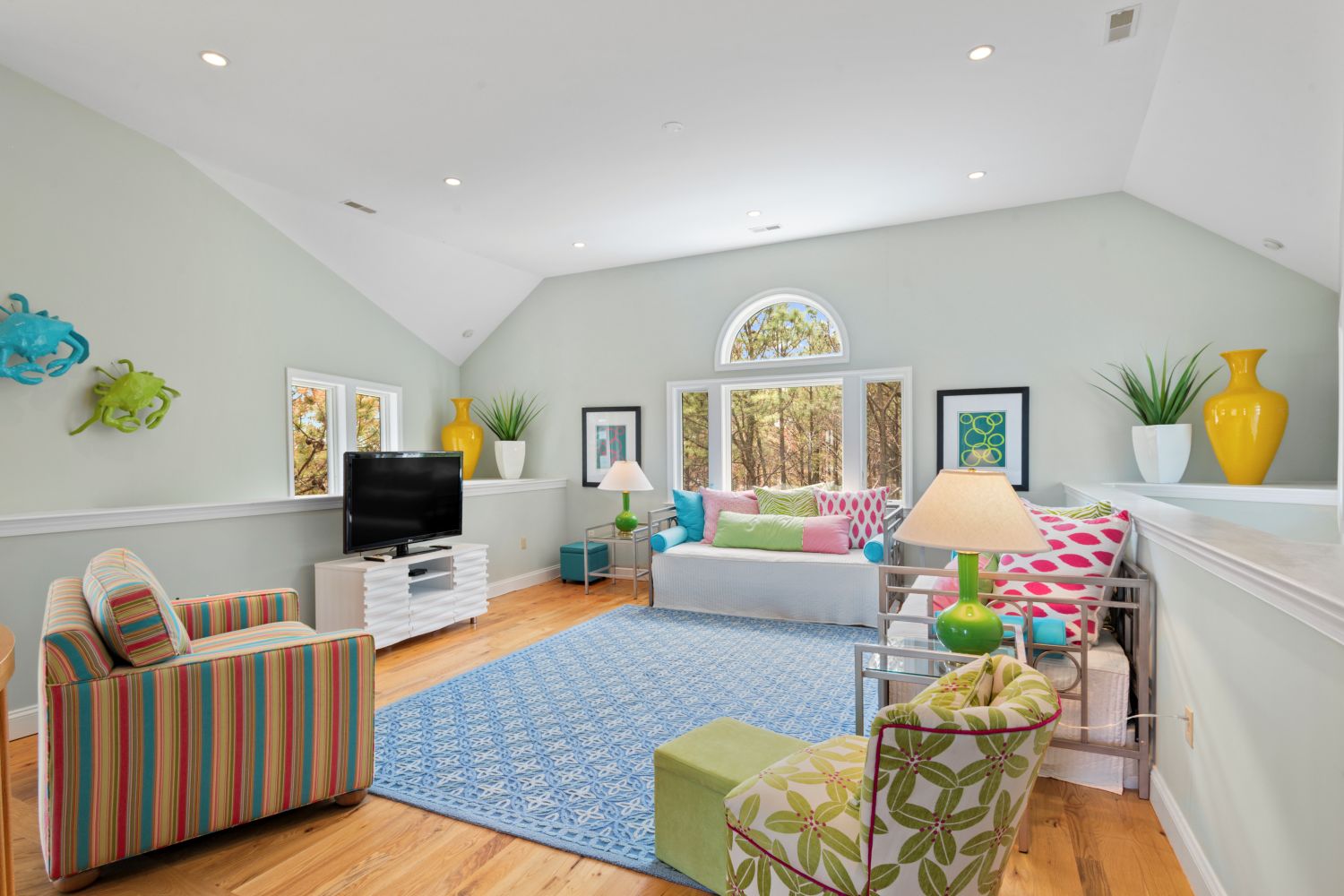
A brightly lit space marries architectural charm with spatial versatility.
The stairs to the second floor open next to a sitting room with delightful interior architecture from the roof’s gambrel shape and clever floor openings. Partial walls surround these openings that become light wells to filter sunlight down to the dining room below. Daybeds provide extra sleeping space for guests.
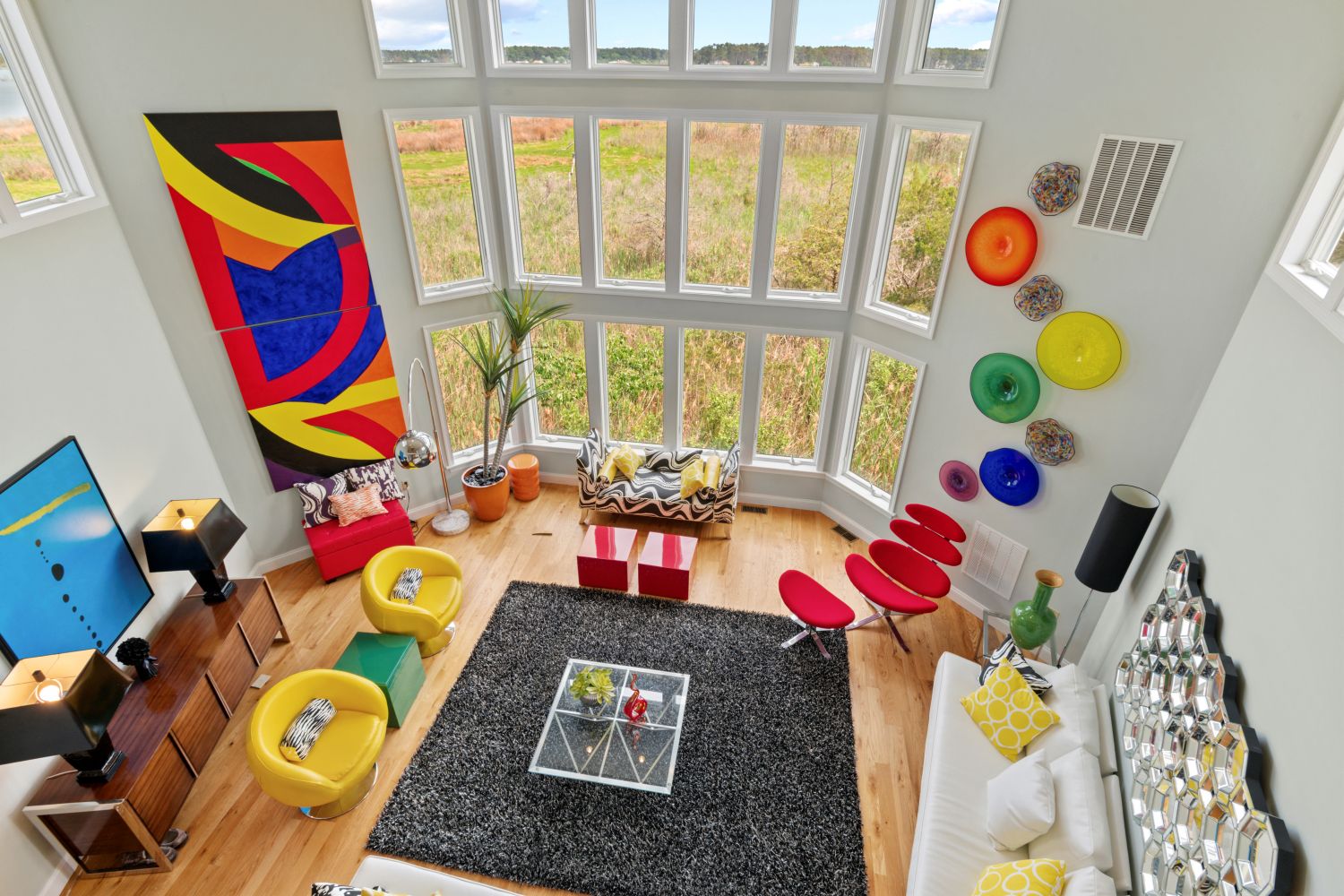
Bird’s eye views extend to Brooks Creek’s untouched beauty and beyond.
My fave part of the house was this view both from the overlook railing down to the living room and also across the upper panes of glass to the undisturbed landscape to Brooks Creek beyond and the expanse of the sky.
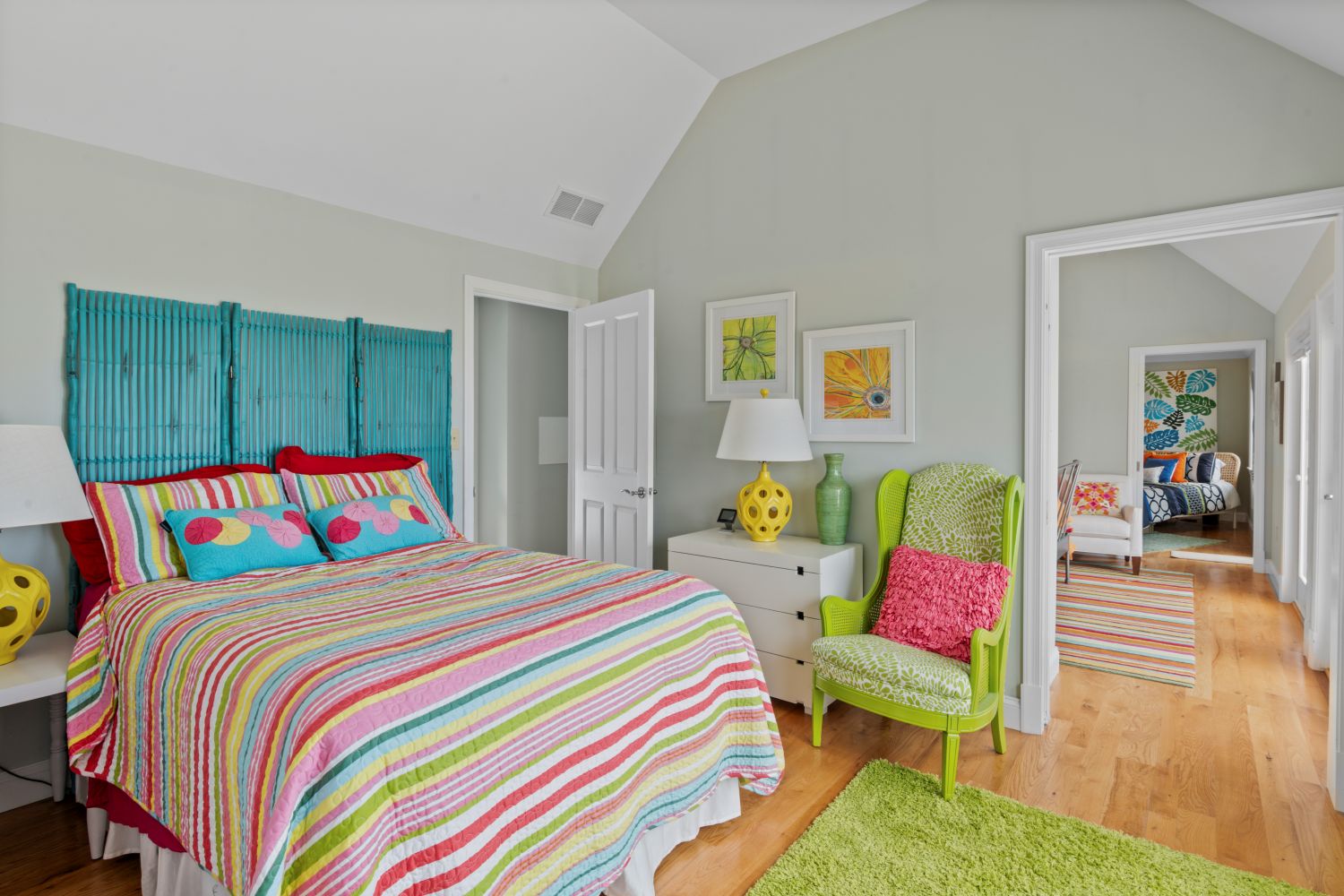
Colorful layers and texture make this space playful yet inviting.
Three guest bedrooms are connected both by the interior hall past two half baths and also by doors between the bedrooms. Each room has a gambrel shaped ceiling for added height and colorful interior design that gives each room its own unique personality. This room’s multi-colored striped bedspread inspired the accents of the textured headboard, rug and chair to creates a delightful space.
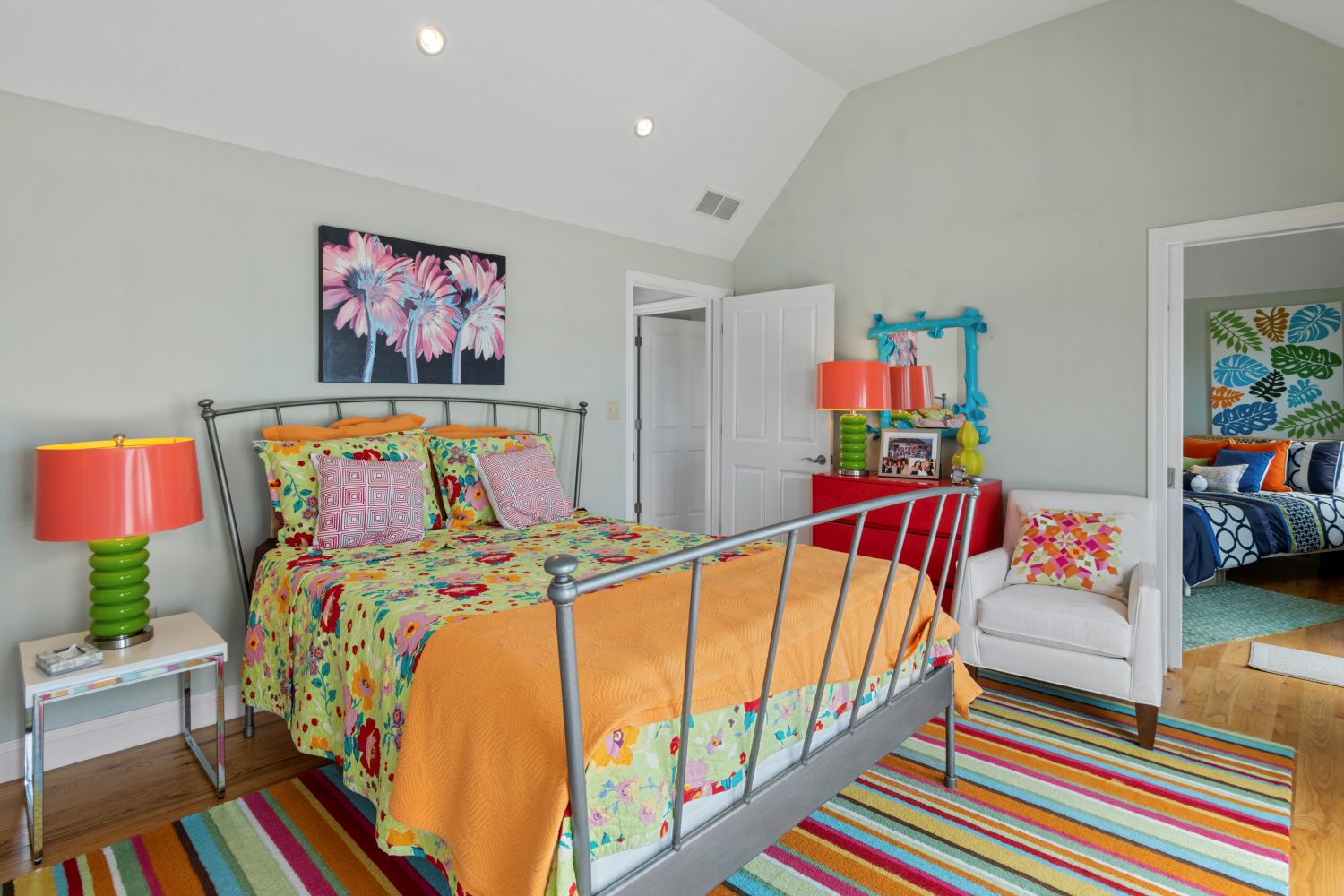
Bright accents and unique design elements enliven another cheerful guest space.
The middle bedroom’s playful flared metal bedframe, multi-colored stiped rug and bedspread with accents of orange in the coverlet and lampshades gives it its unique charm.
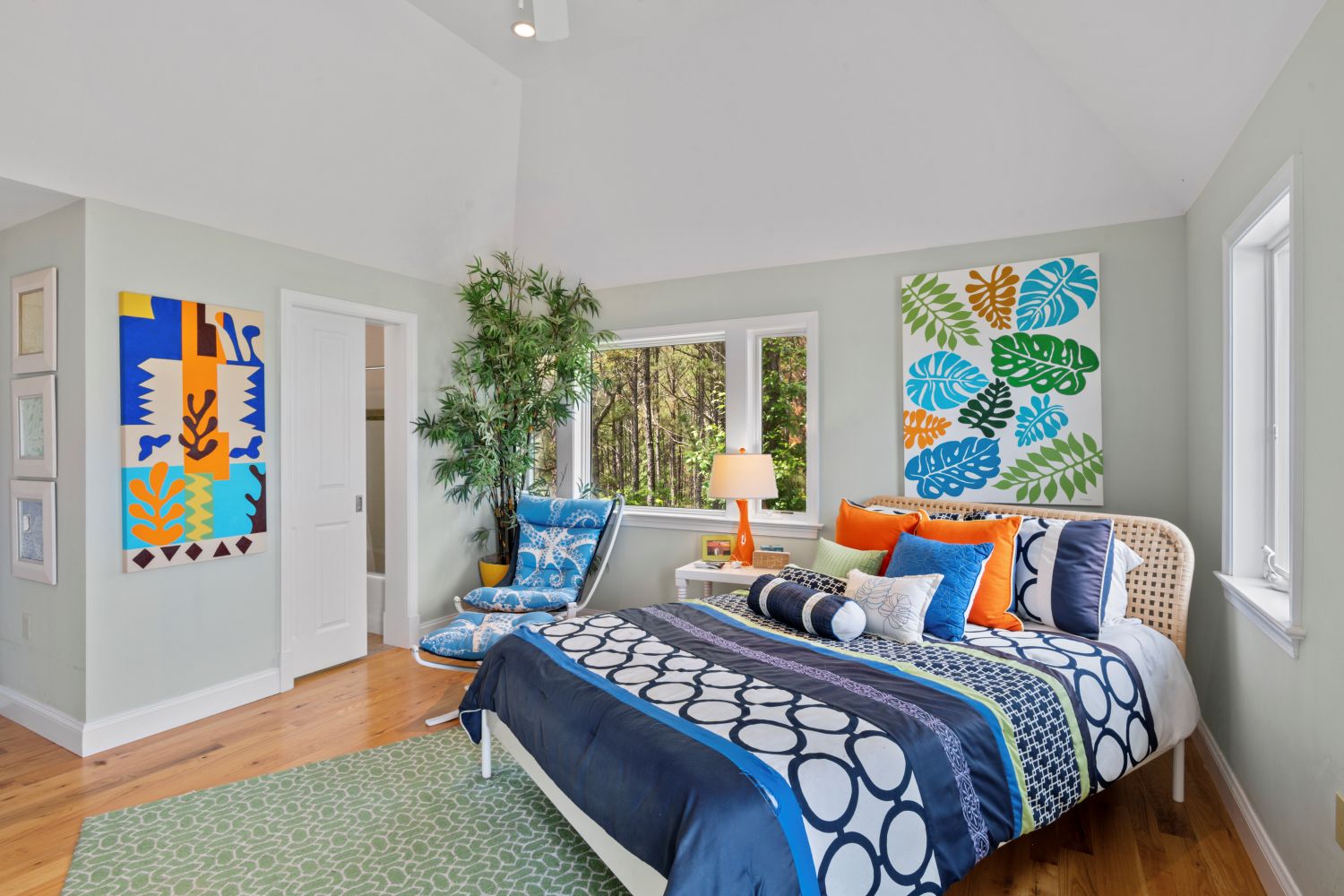
A third guest bedroom provides an artistic retreat thanks to sunlight-filled walls and vibrant patterns.
The corner bedroom, with an ensuite bath, has windows on both exterior walls for additional sunlight. Since I am a Matisse fan, this room would probably be my first choice as a guest for the colorful Matisse frameless art and the geometric patterns of the bed linens in blue, white and orange.
The coastal design of this two story house with the main living level above parking and storage areas at grade provides both covered parking and also nestles the footprint of the house into its 11.8 acre site. The only disturbance to the site were the columns to support the two stories of the house above the ground level. Built in 2007 on its point of land, the house’s compact “Y” shaped floor plan created angled walls in the living and dining Rooms that are parallel to the incredible 1,500 linear feet of shoreline for direct views.
The house is zoned very well with the interconnected living-dining-kitchen-family room area and the primary ensuite at the second floor and a sitting room, and the sitting room, three guest bedrooms and baths at the third floor. The living room’s stunning two-story bay window, wrap around windows at the dining room and family room and the wall of windows and doors at the third floor guest bedrooms open the house to the breathtaking views of the landscape and water. The house’s decks and long vistas from the interior rooms offer sweeping, panoramic views of Brooks Creek.
Outdoor amenities also include a private pier with approximately 3 feet MLW (mean low water), complete with water, electric, and a 12,000 lb boat lift that would please boating or fishing enthusiasts. Hunters would appreciate the duck blind on the property and the abundant wildlife that make this site a rare hunting paradise.
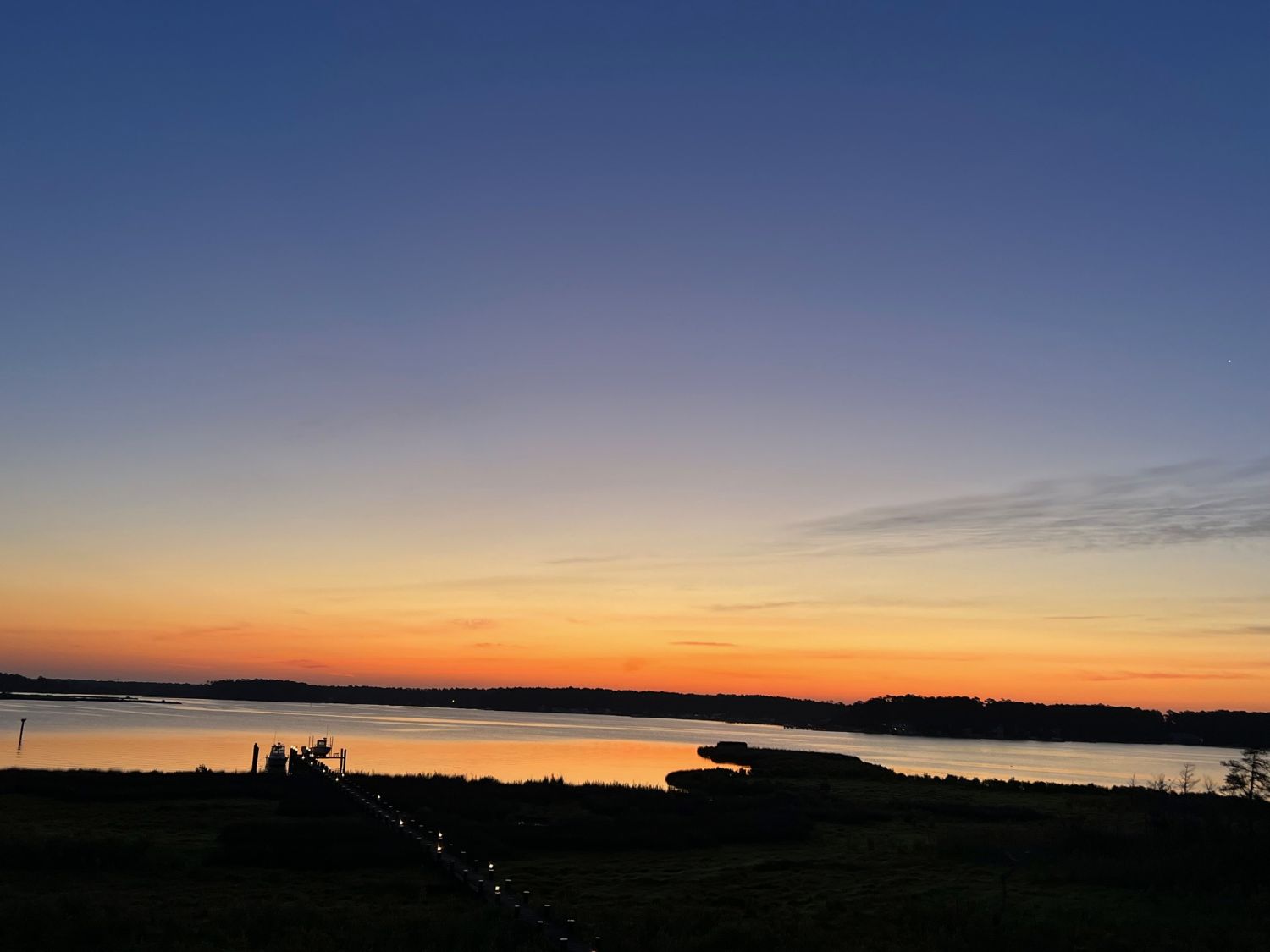
Tranquility blankets Brooks Creek from sunrise to sunset.
From watching the sunrise over Brooks Creek to nocturnal star gazing from the second and third floor decks, this quintessential property offers peace and privacy, only an hour from the Atlantic Ocean beaches and close proximity to Cambridge’s shops and restaurants. All this, and the furnishings are included too!
For more information about this property, contact Coldwell Banker Real Estate agent Gwen Eskridge at 410-822-9000 (o), or [email protected]. For more photographs and pricing, visit www.cbchesapeake.com , “Equal Housing Opportunity”.
Open House: Saturday, July 12th, from noon to 3:00 pm
Photography by Rolfe Wood, 630-222-3098
Contributor Jennifer Martella has pursued dual careers in architecture and real estate since she moved to the Eastern Shore in 2004. She has reestablished her architectural practice for residential and commercial projects and is a real estate agent for Meredith Fine Properties. She especially enjoys using her architectural expertise to help buyers envision how they could modify a potential property. Her Italian heritage led her to Piazza Italian Market, where she hosts wine tastings every Friday and Saturday afternoons.
The Spy Newspapers may periodically employ the assistance of artificial intelligence (AI) to enhance the clarity and accuracy of our content.
The Spy Newspapers may periodically employ the assistance of artificial intelligence (AI) to enhance the clarity and accuracy of our content.
Tom Deininger was born in Boston in 1970. He is a sculptor who works in the style known as assemblage: unrelated, found objects brought together to form a work of art. His sculptures are created with discarded objects that are not biodegradable or recyclable. His work is collected world-wide
He is dyslexic and suffers from ADHD. School was difficult, but he was able to express himself through drawing and making things. Deininger describes himself as “very outdoorsy. I grew up in Norwell, Massachusetts, and I lived in a wooded area with ponds and a river.” He attended Salve Regina University in Newton, Rhode Island, graduating with honors in art. After college he traveled through Europe, Central America, and the South Pacific. He surfed, and he made and sold his art. On this trip to the remote and beautiful beaches of the South Pacific, he saw piles of American plastic trash. He became acutely aware of the damage to the environment created by our consumerist society. Deininger returned to Rhode Island in 1999. He set up a studio in Fall River, Massachusetts. A visit to the Nantucket landfill gave him the idea to make his work three-dimensional, using the thrown-away waste of society.
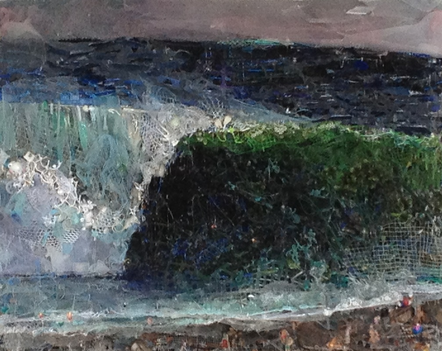
“Wave 1” (2012)
“Wave 1” (2012) (3’x4’x2.5’) was inspired by Deininger’s love of surfing. Made entirely of found plastic objects, it depicts a large white wave, curling, and pounding the beach–a surfer’s wave. Bits of plastic webbing are visible. This work is small in scale. “Wave 3” (2012) (not shown) (6’x8’x3’) and other works are even larger. He chose to depict what he loved in nature and the destructive effect of consumerism on the environment. He contributes 50% of the sale of his sculptures to the organization Narragansett, Rhode Island Save the Bay.
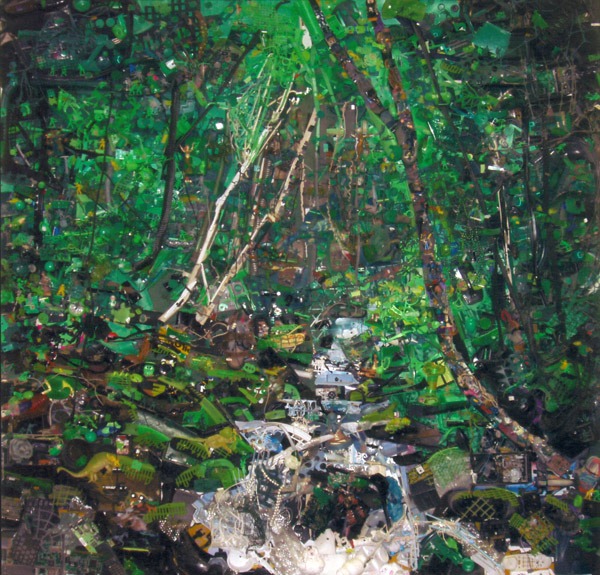
”Poland Springs” (12’x20’)
“Poland Springs” (12’x20’) (undated) was made from plastic water bottles the Maine corporation Poland Springs uses to contain its product. The waterfalls, plants, and trees of the region create a refreshing view of a heathy and pleasing environment. Pure, fresh, clean water is the product. It takes three liters of fresh water to make one liter of Poland Springs bottled water.
The organization Fortune Brainstorm Green has sponsored annual conferences beginning in 2008 to focus attention on issues of sustainability by bringing together leaders from government, business, and other organizations. Deininger was commissioned to create a 20’x10’ backdrop (not depicted) for one of the conferences. =

“Plastic Paradise”
Deininger once commented, “I go to the beach about four days a week, and I pick stuff up. It’s hunter-gatherer, to be honest. And now I’m getting donations from people on Instagram. They don’t like throwing this stuff away.”
“Plastic Paradise” (12’x20’) (undated) is a depiction of a flower-filled meadow, a tall green forest, a rocky mountain, all set under a clear blue sky. Perhaps Deininger hoped the ironic title would make people think. In a 2024 interview with Yahoo news, he stated, “I don’t think we’re alarmed enough. Everyone’s not alarmed enough, enough of the time, is my fear. We should all be petrified and willing to do whatever it takes.”
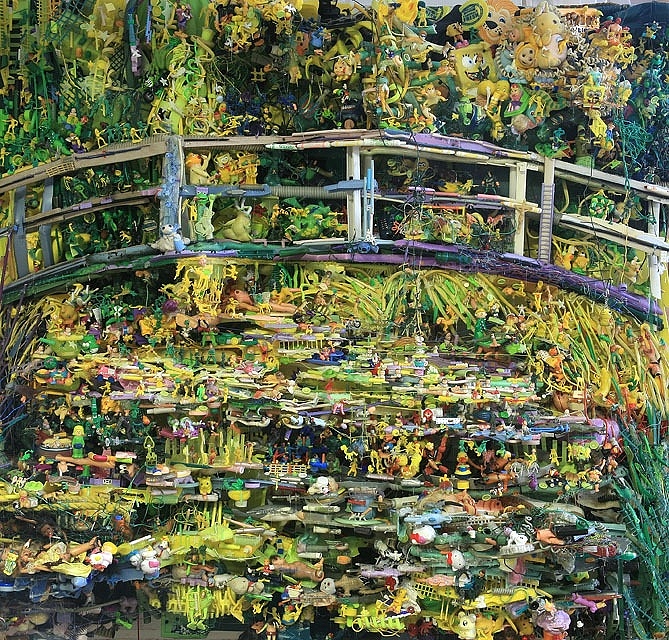
‘Stroking Monet” (2010s)
Deininger occasionally selects known works to recreate as assemblages. “Stroking Monet” (2010s) recalls Monet’s “Japanese Footbridge” (1899) in found plastic junk. Deininger dumpster dives, rummages through people’s garbage cans on trash day, and picks things up all the time.

‘Stroking Monet, detail” (2010s)
So, what is it all about? When viewers are able to look at his work up close, they experience a totally new reality. Plastic Sponge Bob Square Pants, Barbies and Barbie parts, Kermit the Frog, abandoned plastic toys, bottle caps, cassette tapes, wire, plastic syringes, plastic bags, and more, all come together to create an entirely different impression. The juxtaposition of parts is funny, sad, alarming, violent, bizarre, and sexual.
Deininger offers his point of view: “And so you’ve got one thing up close and it coalesces into something else all together from a distance. So, just the idea of what is reality, what is truth, has everything to do with perception…. It reminds me of how slippery it can be, what is real and what is true.”
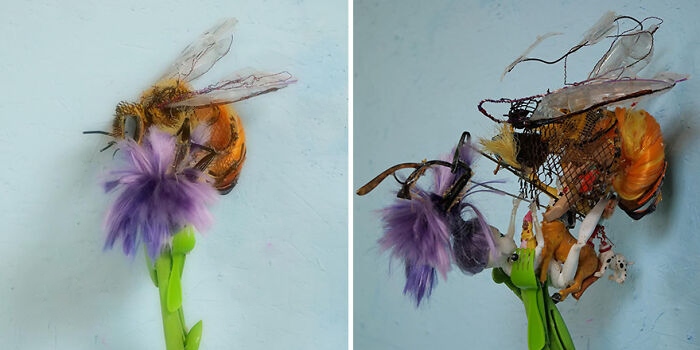
”Honeybee” (undated)
In more recent years, Deininger has begun to create his assemblages with images of birds, fish, and other animals. In his interviews he talks about his process. “Honeybee” (undated) was made from plastic bristles, netting, wire, toy figurines, a plastic German Shepherd, a little man holding a long stick, Shaggy and Scobey-Doo figures, a doll’s head, green plastic forks, and half a pair of sunglasses to represent the eye, among other things.
This double image captures both sides of the sculpture, similar to what a viewer would be able to see when the work is on display. Glueing, wiring, drilling, and pinning are among the processes used. Creating the basic sculpture takes about a week, with more time needed to refine the final image.
Deininger researches each animal: “To cull through hundreds of images of bees and find the one you want because you can clearly see the eye or the thorax—you get to understand the granular details of variation within a species.”
Deininger observes, “We tend to dismiss things that are inexpensive and don’t look at their beauty overall. But when you can take something out of context and put it together with a variety of other things, you can coax a new definition out of it and maybe a new purpose.”

”Osprey” (2023)
Deninger talks about birds: “I’m just really fascinated with them. Fascinated by the physical engineering and also there is a wonder about birds…. It’s often about things coming down from the heavens. Birds occupy this space that isn’t available for us to occupy. I think humans have always been attracted to birds in a spiritual way.”
The subject of the sculpture “Osprey” (2023) (18”x12”x39”) is well-known to those of us who live on the Mid-Shore. The retirement community Heron Point maintains an Osprey nest with a video camera set up so that residents can watch 24/7 during the season.
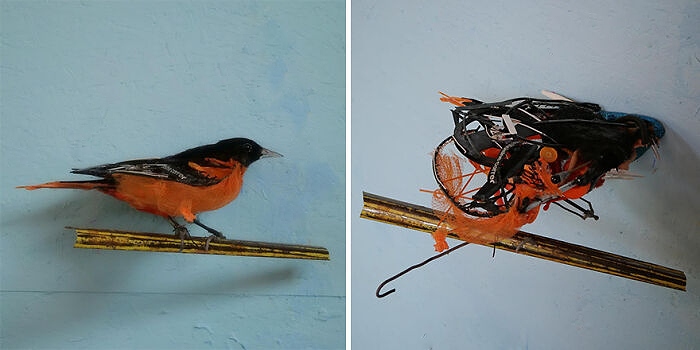
“Baltimore Oriole” (2023) (5”x11’’x17’’)
It is possible to see both sides of another of Deininger’s sculptures, Maryland’s State bird.
In 2025, Deininger started a permaculture farm, an agriculturally sustainable and self-sufficient ecosystem, to take care of rescued animals.
In several interviews over a period of time he offered his point of view;
“There’s so much junk around us that we can recreate the natural world.” (The Provincetown Independent, 3/212/25)
“Yes, we can call these objects masterpieces.” (Yalik Ak, 7/9/2014)
“You know, nothing changes if we do the same thing over and over again, and just walk into an ecological crisis that is irreversible. It’s about adopting a new perspective.” (Blue Dot Living, 2025)
Beverly Hall Smith was a professor of art history for 40 years. Since retiring to Chestertown with her husband Kurt in 2014, she has taught art history classes at WC-ALL and the Institute of Adult Learning, Centreville. An artist, she sometimes exhibits work at River Arts. She also paints sets for the Garfield Theater in Chestertown.
The Spy Newspapers may periodically employ the assistance of artificial intelligence (AI) to enhance the clarity and accuracy of our content.

A timeless symmetry of gabled roofs and Flemish brick bond greets visitors at the threshold of history.
Mt. Pleasant was built in the early 1800’s for the happiest of reasons-Daniel Cox Hopper built this brick, one room deep, three-story house so he could carry his new bride over the threshold of the double doors into the center hall of their new home. As befitting a man who was a prominent local attorney and planter, member of the Maryland House of Delegates and a Lieutenant in the Maryland Militia during the War of 1812, he built the house in style of the day, a transitional Georgian to Federal Manor house on its original 383 tract of land that dates back to the 1600’s.
Today the house sits on 2.7 acres, surrounded by farm fields and vistas of the landscape that has remained remarkably unchanged for over two hundred years. As I came to the end of the allee of trees along the entry drive, I paused to savor this house’s elegant simplicity of gabled roofs, the harmonious symmetry of windows and doors and how the massing telescopes down from the 2-1/2 story main wing to the 1-1/2 story wing.
As I walked up the steps to the entry double doors, I noticed the “put-log” holes in the brick headers that had supported scaffolding during construction and the lovely Flemish bond of the brick on the front façade.
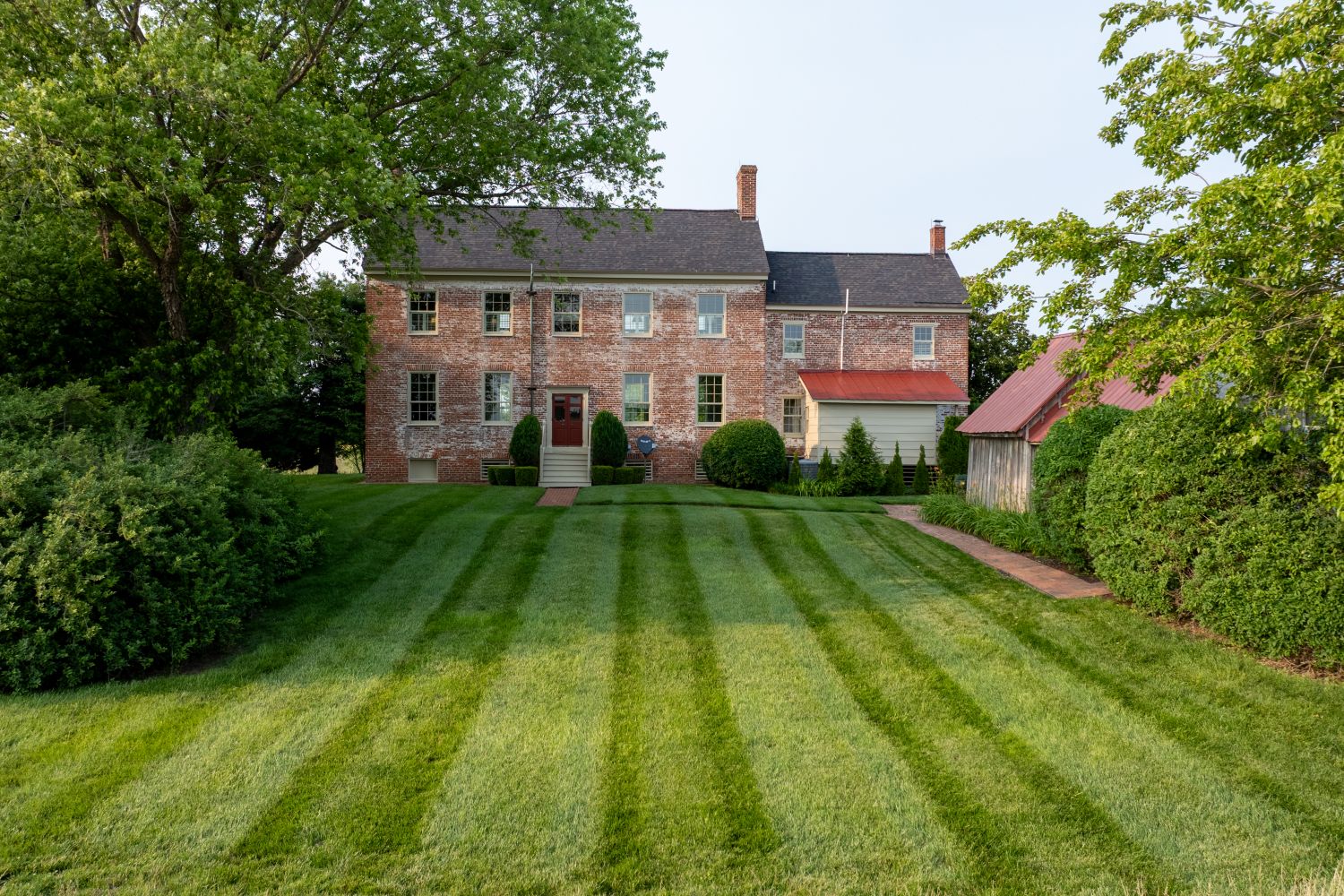
Subtle remnants of whitewashed brick highlight the preserved craftsmanship of centuries past.
One of my favorite courses of my architectural education was architectural history. The professor considered older houses to be living things that can convey clues about the styles or details of an earlier period, if one has the time and patience to seek them. This house was very lucky that in 1988, a young family moved in and their mantra became how best to preserve the history of the house, while adapting a two centuries old house to the needs and wants of a growing 20th century family.
As I walked around the house, the only later addition is the old tin-roofed porch that became the family’s mud room, pantry and powder room. The areas of white brick indicate that the house was once painted and I admired how it gave the facades a look more refreshing than a monolithic brick façade would have been.
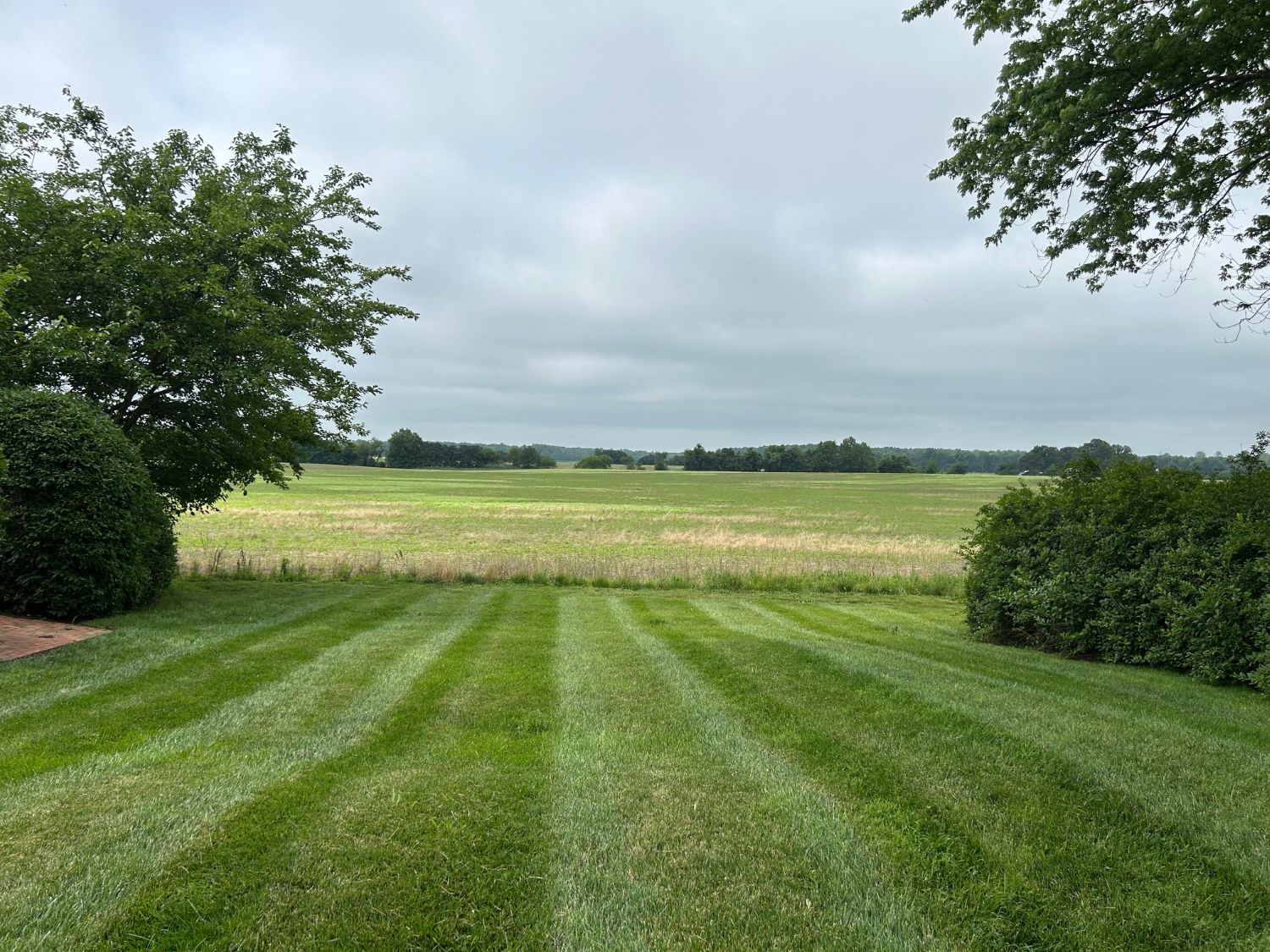
Fields radiate serenity, mirroring the unchanged landscape from the home’s storied past.
After studying the rear façade, I turned around to this serene endless vista of shades of green from the fields, still owned and farmed in stewardship by two generations of the Ward family, edged by mature trees. I marveled at how gorgeous the thick green grass was that seemed like a plush carpet with striations of deeper green. The vista reminded me of how the original acreage must have looked during the Hoppers’ tenure.
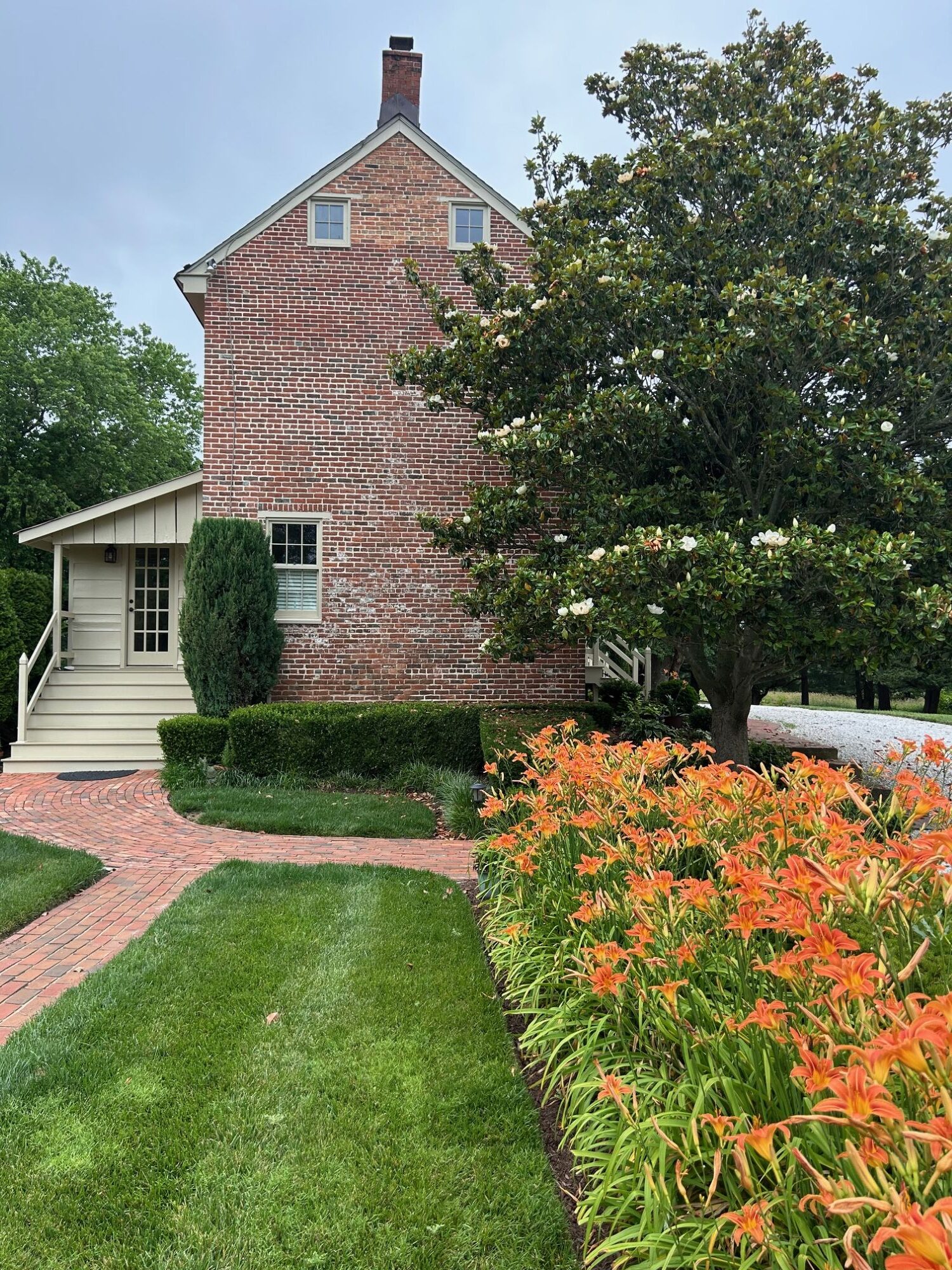
Textured brick meets the gentle sweep of garden pathways in a vivid interplay of color and form.
I could not resist taking this photo of the juxtaposition of the 1-1/2 story wing of textured brick against the wood cladding of the shed roofed porch, in its setting of the lighter colored brick path, thick green grass, tall orange day lilies gently swaying in the breeze rand the majestic Magnolia in bloom.
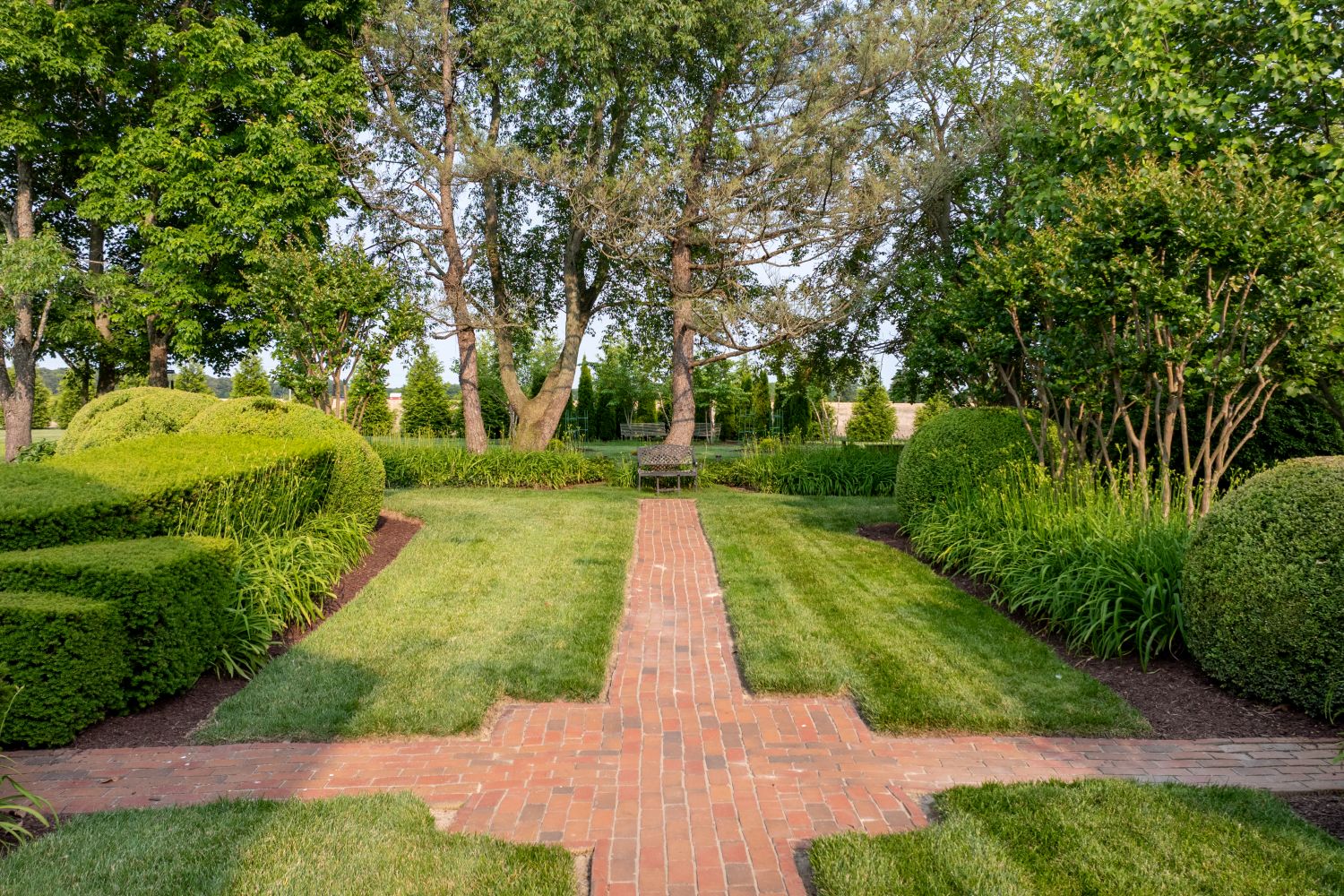
Historic flora connect guests to Jefferson’s Poplar Forest and Washington’s Mount Vernon within this tranquil haven.
The crossroads of the brick path illustrates how one can reach the gardens from both the parking area and the shed roofed addition to the house. The Listing Agent met me in the garden and pointed out the tall Tulip Poplar that once was a mere seedling in Thomas Jefferson’s Poplar Forest Plantation and the yews and boxwoods that were grown from cuttings from Mount Vernon, George Washington’s home.

A breezy pavilion offers alfresco dining and relaxation overlooking a garden steeped in heritage.
The current owners installed the pool and the spacious pavilion open to the breezes is a delightful outdoor room with its view of the garden. The pavilion’s size easily accommodates space for both relaxing on the wicker furnishings or dining al-fresco.

Precision-crafted panel doors frame vistas that once provided natural cooling to this architectural gem.
The current Owners wanted to preserve the original entry doors at both the front and rear of the center hall from extreme weather. They located a craftsman in Oregon who built another two sets of double mahogany raised panel doors whose dimensions were a perfect match to the original doors. At the time the house was built, having doors and windows directly opposite each other provided natural cooling
Over the front entry doors is the original transom, with its muntin profiles that were the prototype for the custom design of the thirty-two new Marvin “Ultimate” insulated windows that replaced the older leaky 1907 “replacement” windows on all the facades. The beautiful antique pieces in the foyer on the original pine flooring were harbingers of more treasures to come.
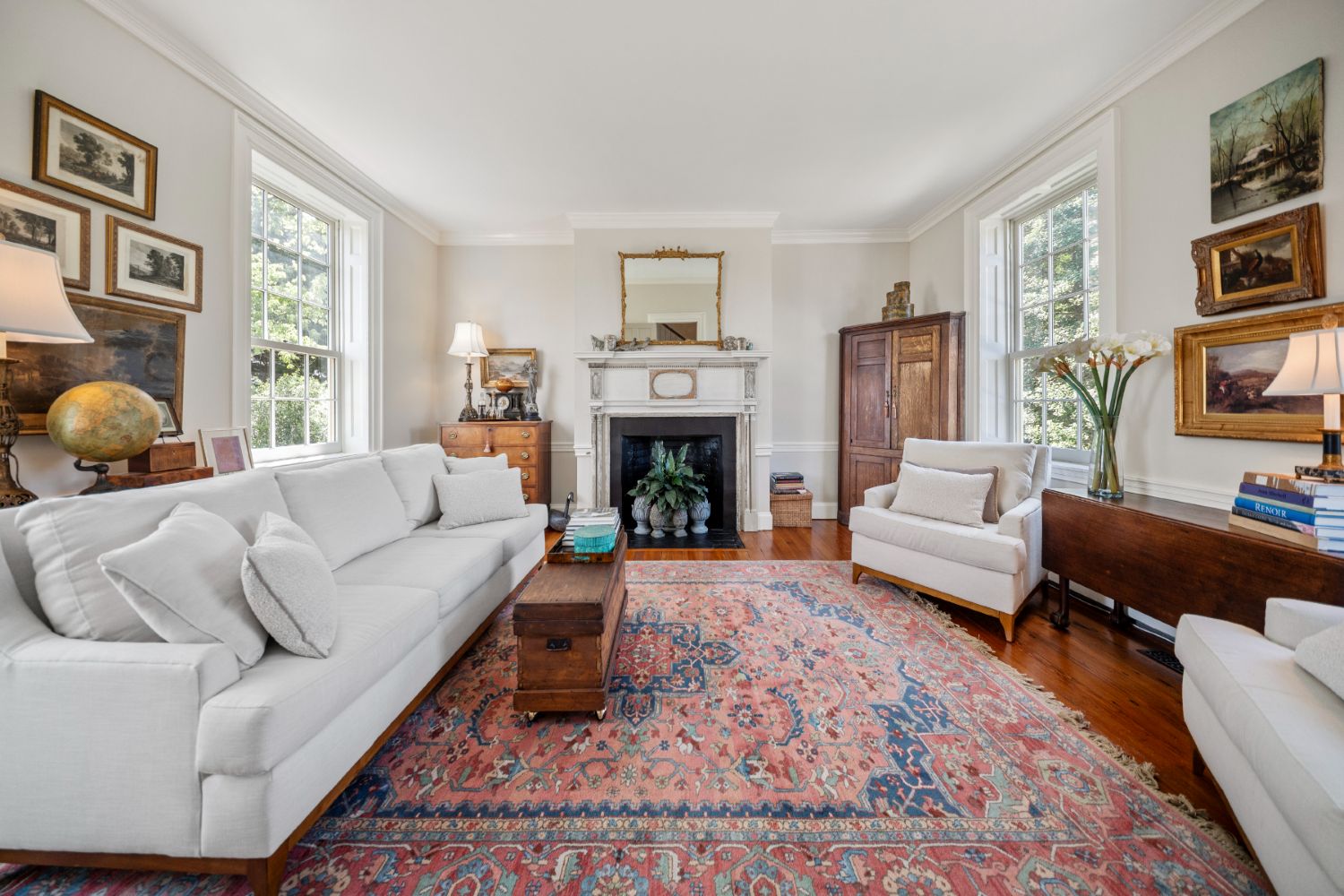
Panoramic windows and a stately fireplace anchor this room of elegance and light.
To the right of the center hall is the Drawing Room; in the hierarchy of the house’s rooms, it is the most prominent space and the primary entertaining space. The room’s details reflect its prominence such as the largest windows in the house, with angled side wood panels to reflect more light, the largest fireplace in the house with its surround and mantel embellished with columns, pilasters, and panels of reeding, and the chair rail around the room that blends into the center hall’s chair rail. After many, many layers of painstaking removal of paint, the nuances of the fireplace’s design take its pride of place as the focal point in this exquisite room. I admired the colors of the large Oriental rug, the neutral upholstered furnishings and the warmth that only wood antiques can bring to a space.
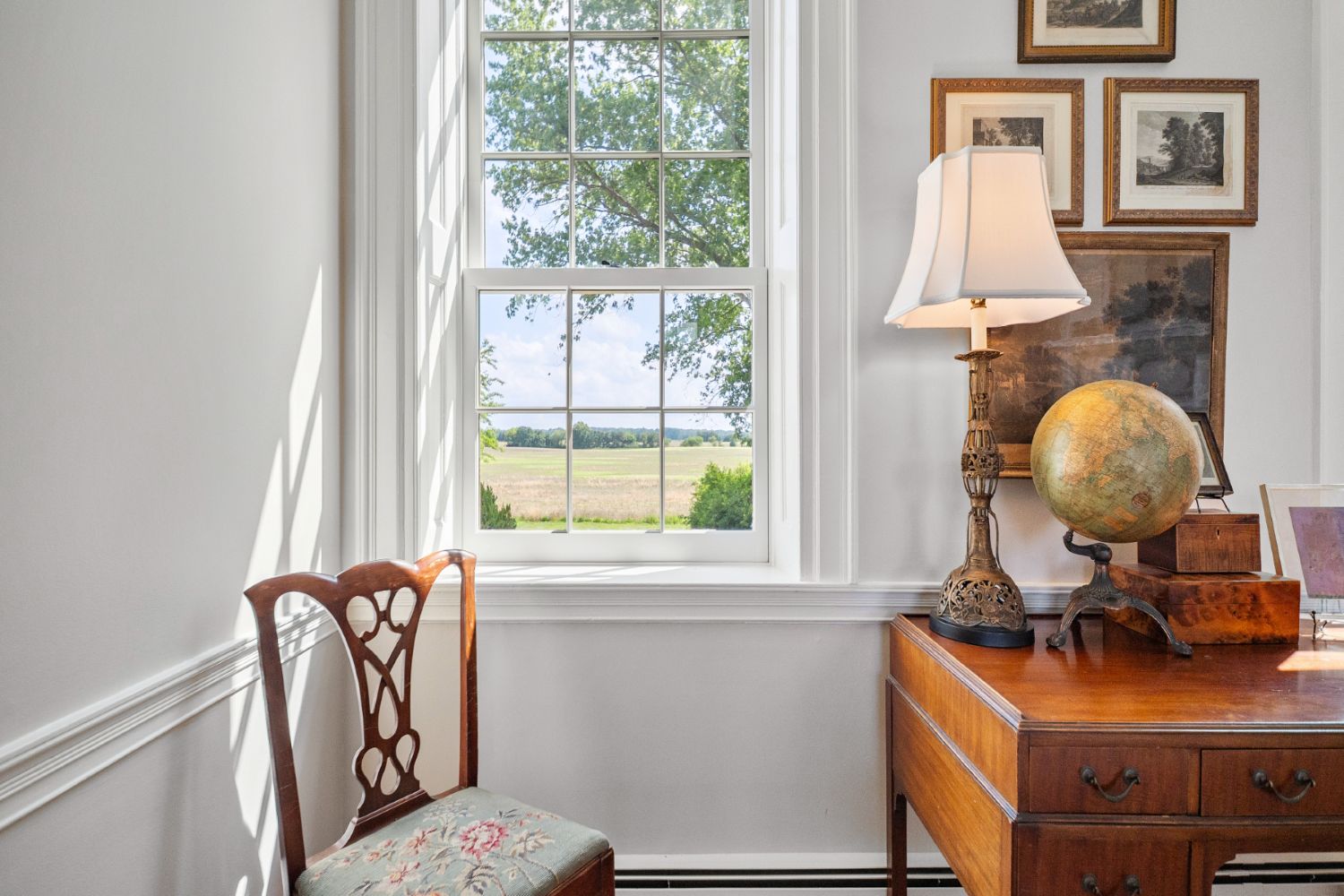
Graceful moldings and serene vistas unite interior artistry with exterior splendor.
Throughout the house, careful arrangements of furnishings and art give this house its distinctive personality. The large window at a rear corner of the Drawing Room offers a long vista over the farm fields to the woods beyond. I especially liked how the moldings around the windows gracefully meet the horizontal line of the chair rail and how the soft light gray walls and white trim become a serene backdrop to the interior design.

Georgian-inspired lighting and millwork elevate the understated refinement of this dining space.
Second in the hierarchy of the rooms is the Dining Room off the center hall. The windows are not as large as the Drawing Room, the fireplace is smaller and the chair rail is not as elaborate as the one in the Drawing Room. The rug is sized to accommodate the table and the extra chairs. I wondered if the pendant light was the work of the artisans at Deep Water Landing in Chestertown, as the Georgian design would be quite appropriate.
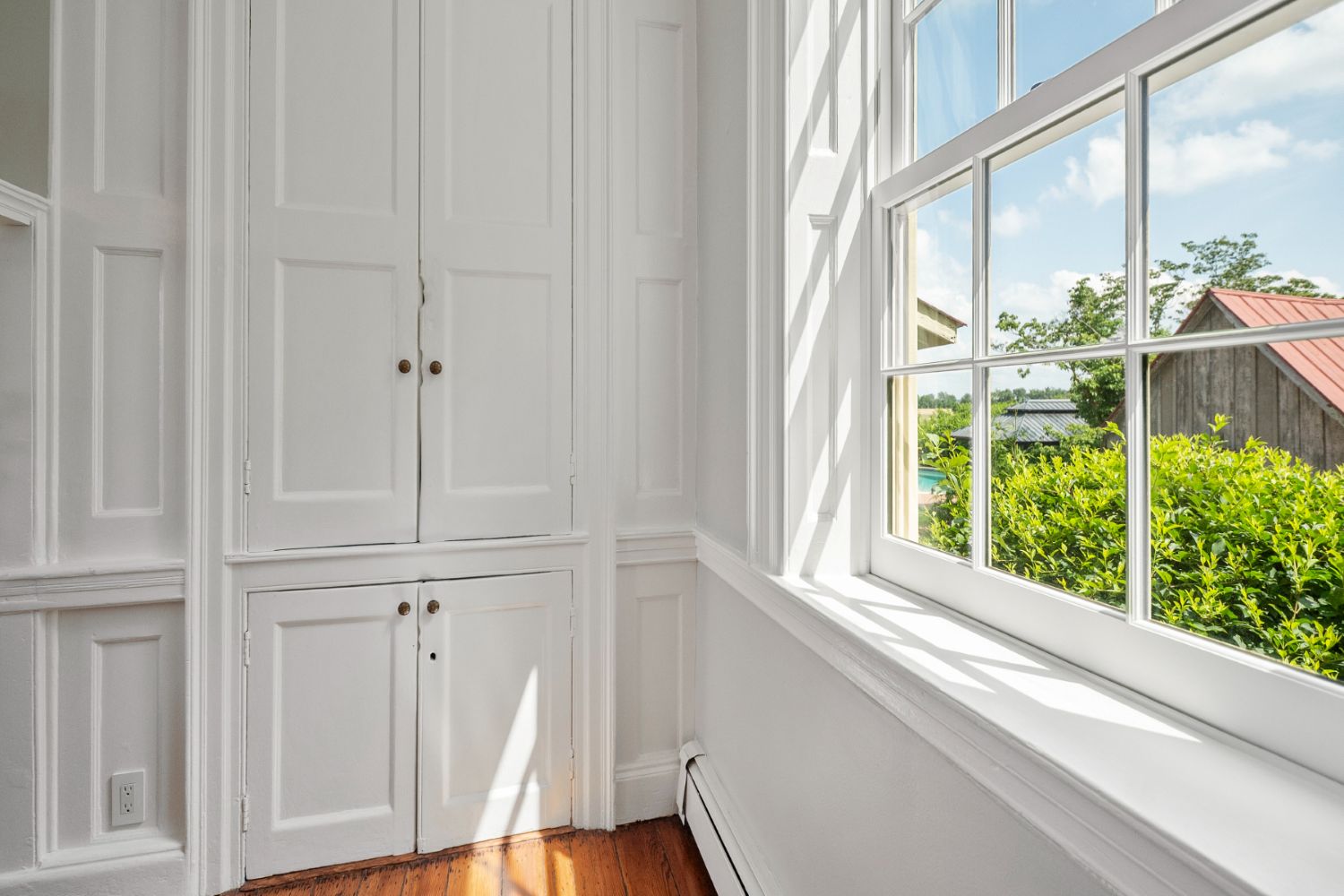
A cabinet’s wear tells tales of generations, blending bespoke craftsmanship with historical traces.
The bespoke cupboard in the space between the fireplace and the rear corner of the Dining Room was originally built to contain the china, crystal and silver, as well as wine and liquor. The cupboard’s hardware was lost many years before the current Owners moved in. The notched areas on one side of the doors are evidence of many hands in the past that opened and closed the paneled doors. Before I passed through the doorway leading to the kitchen, I noticed how the side wall of the fireplace has been peeled away to reveal the original plastered wall and remnants of wallpaper. This detail and several other elements throughout the house illustrate the original materials.
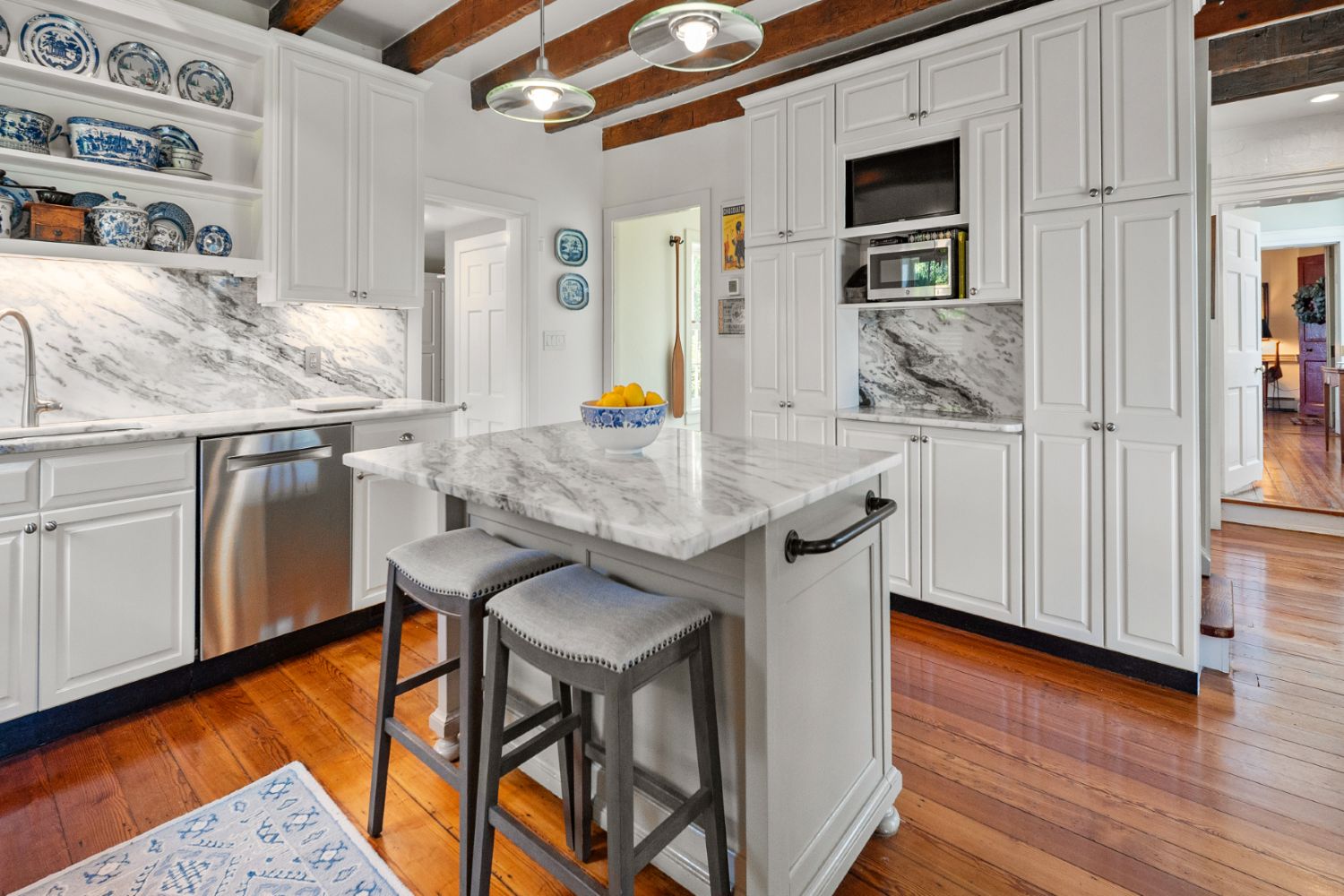
Reclaimed pine floors and exposed beams merge the past with modern functionality in this striking kitchen.
Past the Dining Room is the former pantry that is now a laundry/service room and a secondary stair to the upper part of the kitchen wing. Seeking insights about the original layout of the kitchen, the current Owners reached out to old family and friends who were well acquainted with the Robinson family, who lived at the house when it was dairy farm at the turn of the century. Over a thirty year period, the current Owners have transformed the space with painted maple cabinetry, Brazilian marble countertops and backsplash. The exposed beams were refinished and sealed and the brick chimney at the side wall was left exposed, then repointed and painted white to blend with the cabinetry. The beautiful pine floors were reclaimed from William Paca’s old farm house on the site of the Wye River Plantation, the home of the Maryland signer of the Declaration of Independence. I especially liked how well the white cabinetry highlighted the Owners’ beautiful collection of blue and white ceramics.
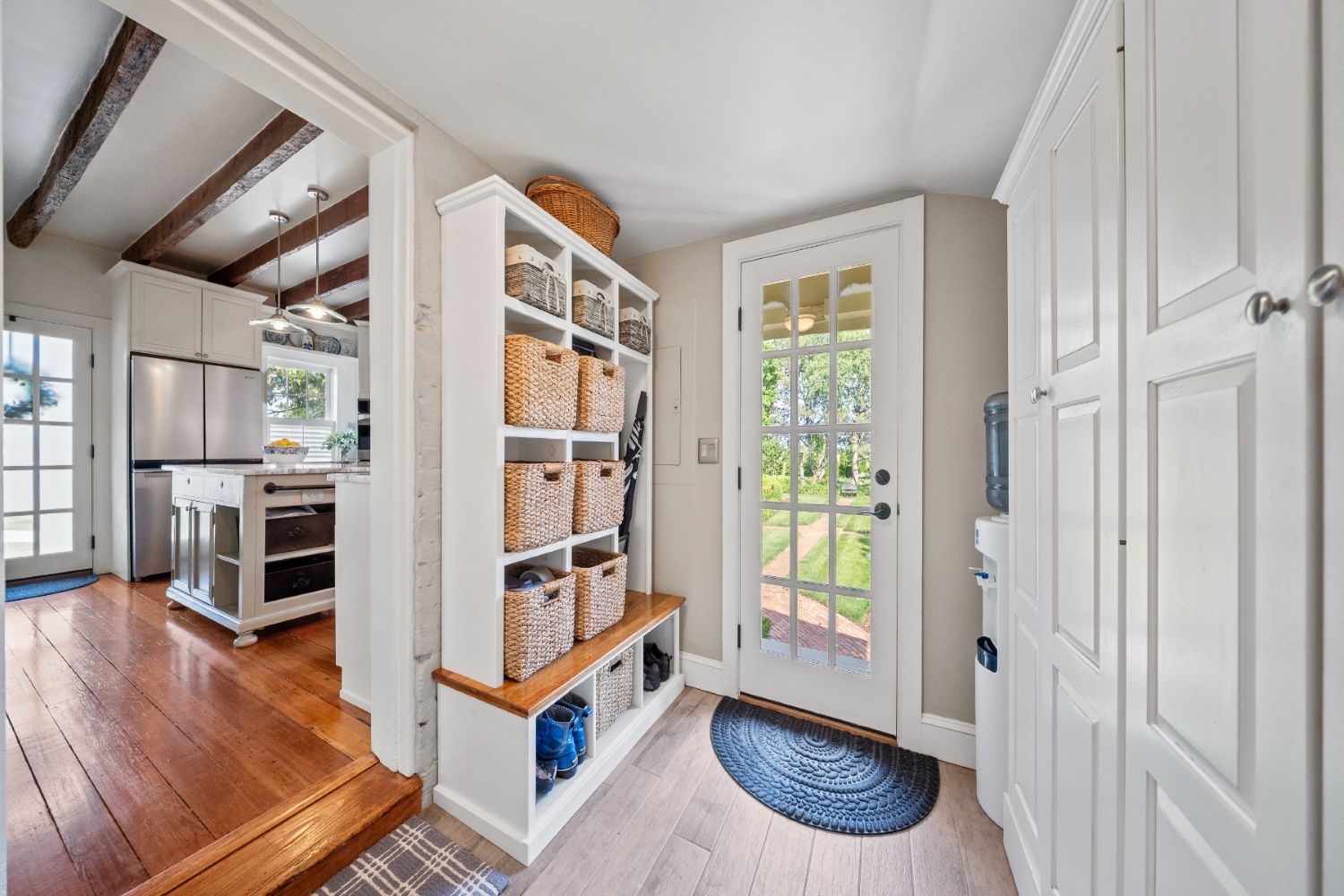
Custom cabinetry optimizes utility while retaining the architectural charm of the original tin-roofed porch.
The current Owners enclosed the old back porch with its original tin roof for a Mud Room/Pantry. A wall of bespoke cabinetry with a mix of paneled doors to access pantry items is opposite open shelves containing baskets of storage for each family member. The lowest cabinet is deeper so it can also be used for sitting while one takes off boots or wellies. The French door brings light into the room and offers a view of the garden. There is also a small powder room for convenient clean ups after gardening. The stairs to the cellar are also located here.
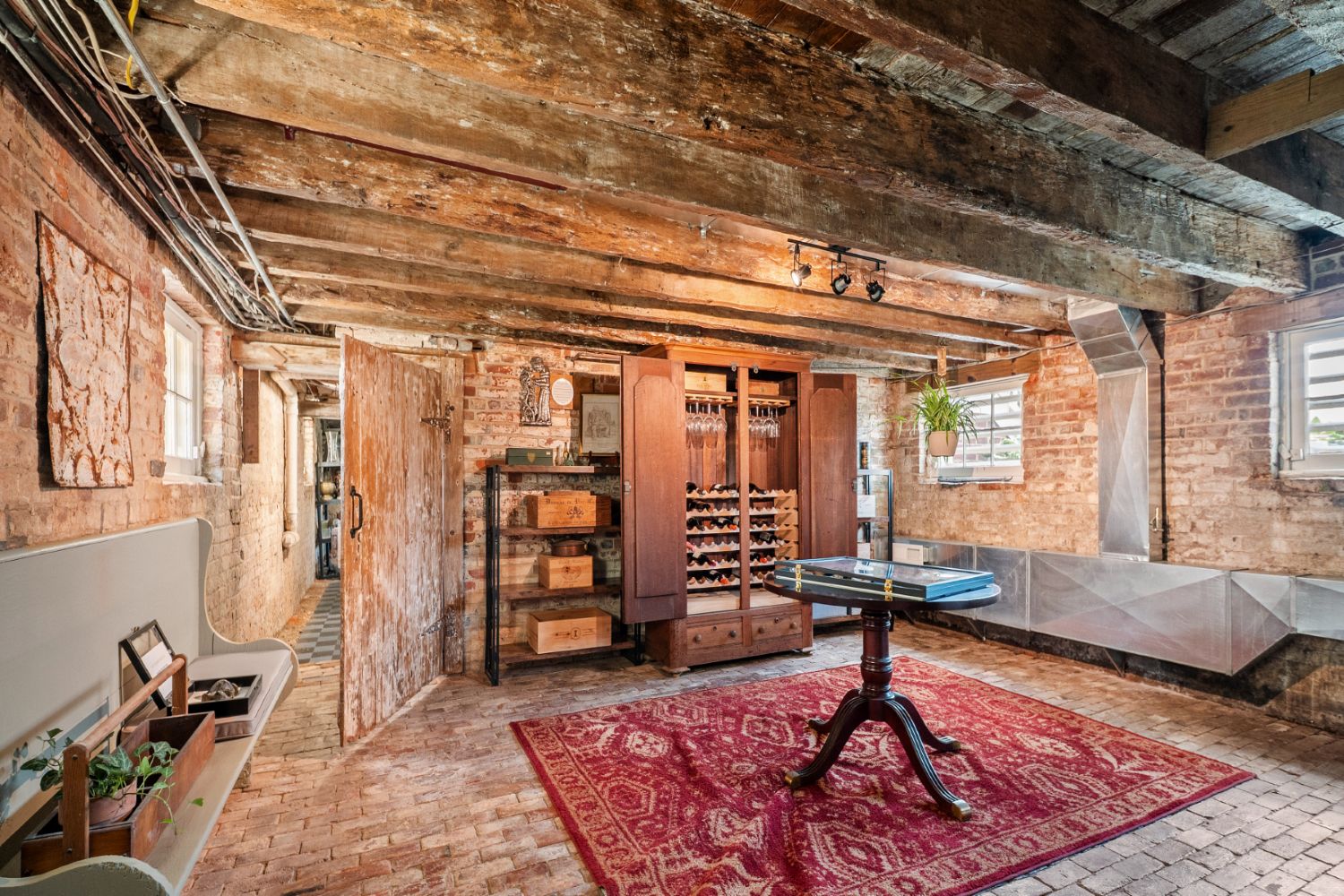
Vaulted arches and brick pilings craft a timeless space, perfect for storing the house’s cultural narrative.
On my tour of the grounds before I came into the house, I had noticed a large half moon shaped opening that had been bricked in at the side wall of the house. I learned that the opening had once been the only access to the cellar. The current Owners discovered a trap door with a folding stairway and remnants of old limed whitewash on each side of the stair. At each end of the cellar, I marveled at the foundation of massive brick pilings and the vaulted relieving arches at the chimneys’ exterior walls.
As the Weekend Wine Woman at Piazza Italian Market, I noted that the rows of wine were resting on racks in this underground space ‘s perfect temperature for storing fine wine. The cellar also originally contained a Larder where butchered meats and fowl awaited cooking or were larded in fat for preservation.
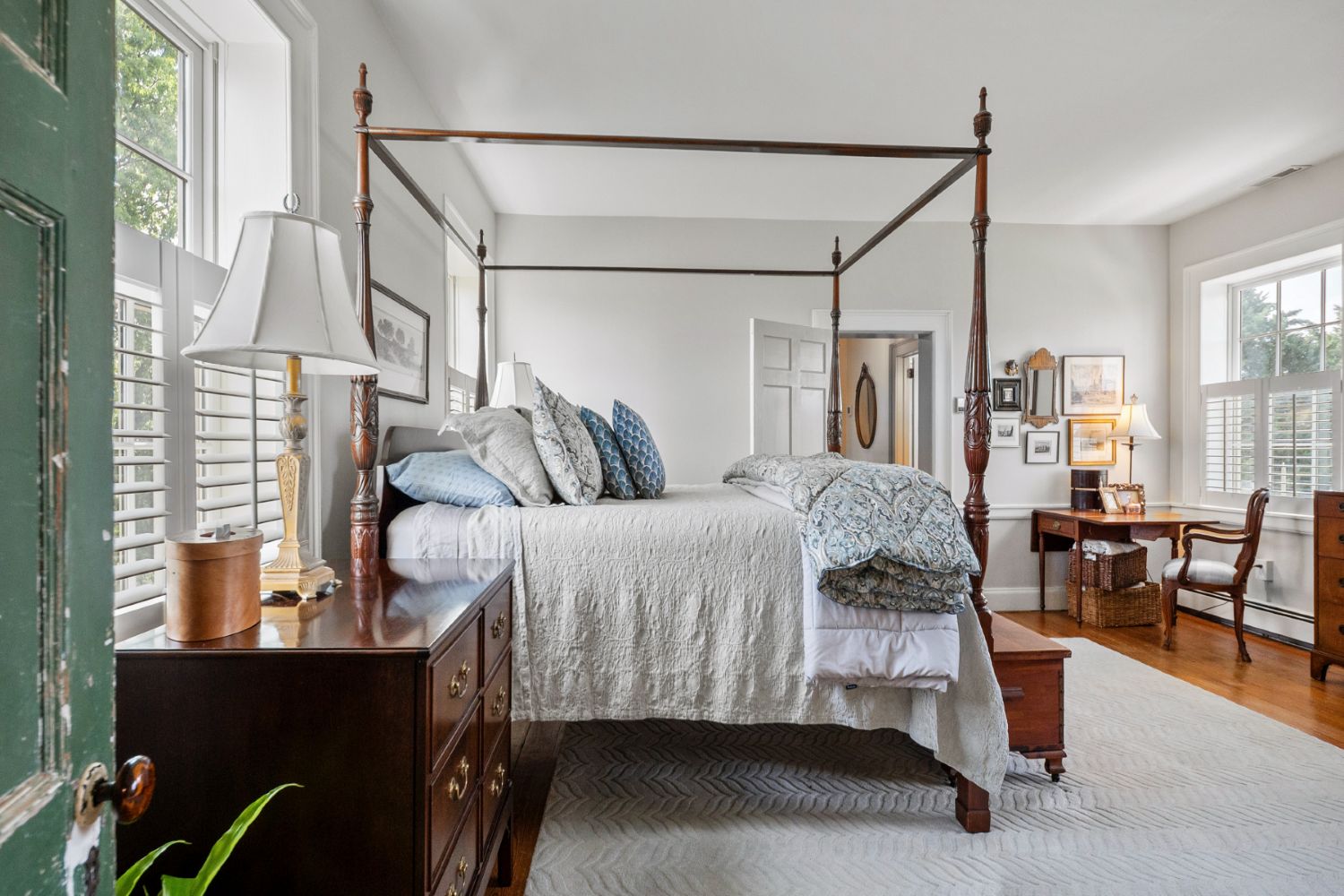
Serene hues complement four-poster elegance within a sunwashed, tranquil retreat.
At the second floor, the spacious Primary Ensuite begins with the bedroom over the Dining Room. Steps down to the 1850’s era wing now contains the Primary Bath, the secondary stairs to the Kitchen, Primary Dressing Room and Office. The bedroom’s four poster frame fills the space without infringing upon the spatial volume and the soft colors of white and blue create a serene retreat. The original door has been saved in its original state.
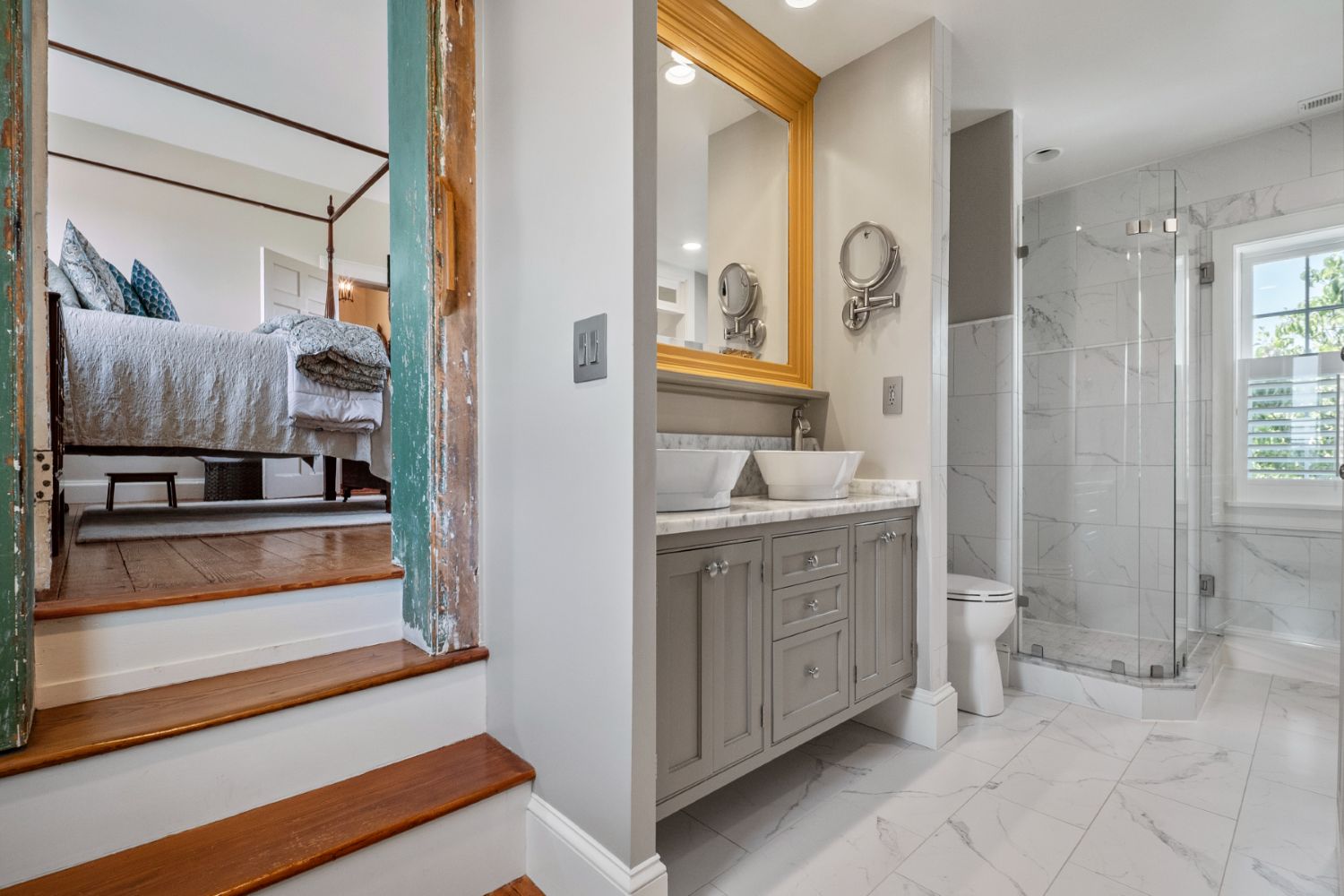
Transformed marble-finished spaces bring modern luxury to the heart of a historic wing.
It is difficult to realize that the elegant Primary Bathroom was once a storage room with crumbling lath and plaster walls, an old window with a plywood piece for a window treatment, and wood floors painted brown! Now the space is transformed with marble flooring and a Brazilian marble top for the dual lavatory’s floating cabinet with porcelain vessels. The glass walled shower and the one-piece eco-flush toilet are finishing touches. The Dressing Room with custom cabinetry completes the ensuite.

Exposed beams and sunlight filtered through square gable windows inspire quiet productivity.
The office is located at a quiet corner of the house and it its ceiling was removed to expose the rafters and the two square windows on either side of the chimney. The windows add additional sunlight to the room and the white walls accentuate the stained beams. The side gable wall infilled with bespoke millwork beckons one to select a book and relax in one of the chairs. When one is not working, the table and chair are positioned so one can take a break to look over a computer at the view of the landscape through the window.
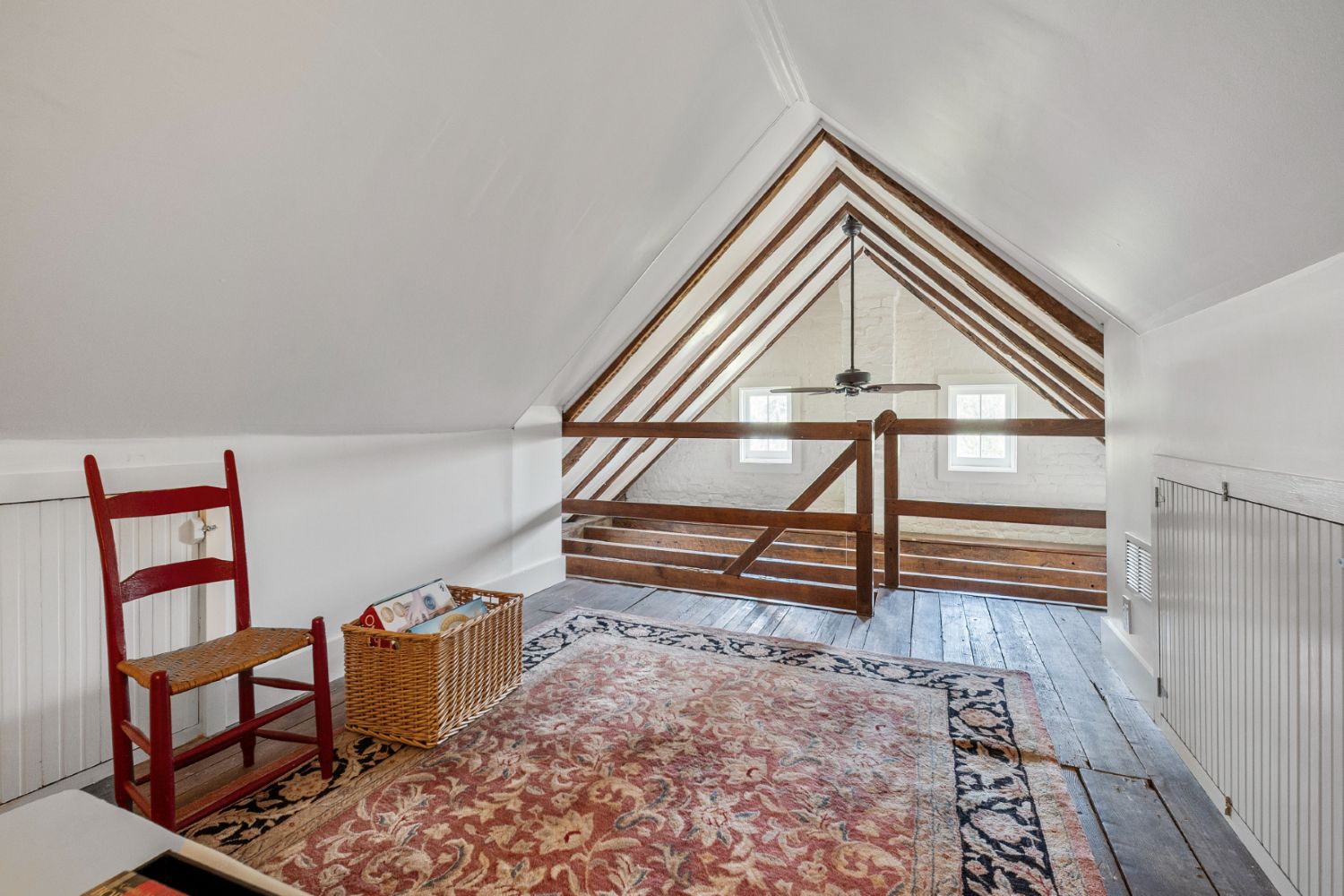
Geometric rafters and whitewashed walls create a versatile attic, steeped in architectural intrigue.
Another set of stairs leads from the second-floor office to a finished attic, with sunlight from the windows and doors leading to storage areas under the eaves. I admired how the exposed stained rafters, ceiling joists and railing stand out against the white walls and ceiling to accentuate the office’s spatial geometry. This bonus room has myriad uses-second office, playroom, teen hang-out, extra sleeping space, etc.

Preserved joists and weathered wood detail the restoration history of this elegant guest space.
I would be quite content to be a guest in this elegant bedroom opposite the stair hall and the primary bedroom. The four-poster bed, fireplace, armoire and the writing table would please any guest. The fireplace’s exposed wood framing illustrate a fire that occurred long ago from an old chimney fire and shows the sister joist techniques that were used to repair the damage. The fireplace surround is a simplified reconstruction.
The interior architecture of the bedroom is left “as-is”, to better study the original construction techniques. Old drywall partially obscures the chair rail, and the walls need to be replastered and the partial paint removal from the door offers clues as to its past colors. The beams are exposed in this room but they would have originally been covered by a ceiling.
Between the Primary Bedroom and the Guest Bedroom is a bath created by the space that was originally a large open landing off the stairs with a window for cross ventilation. The room’s size now easily accommodates a full bath.
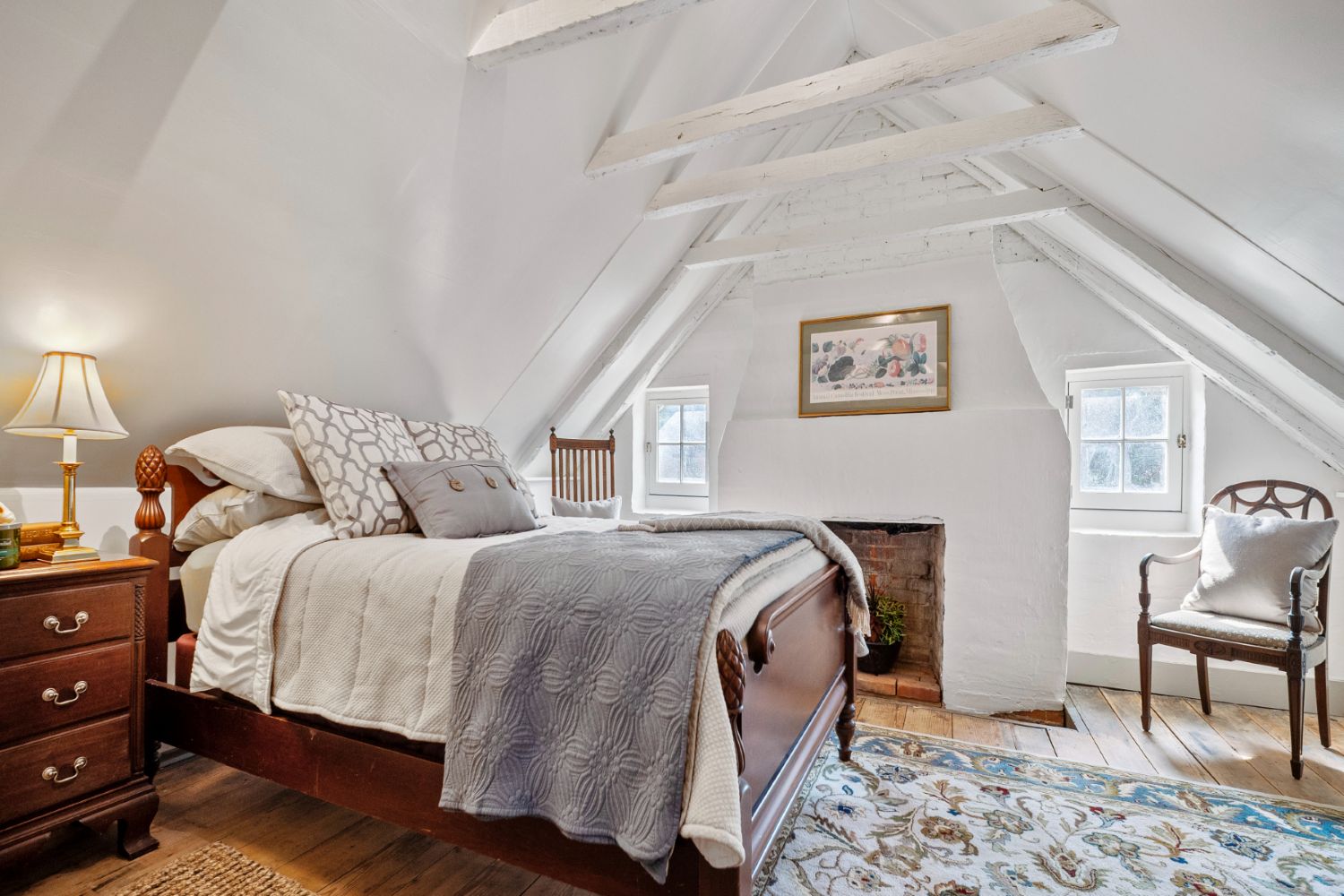
Earth-toned finishes frame serene vistas and the warm embrace of exposed beams.
My fave spaces in houses are always the charming spaces that are tucked under the roof’s framing. Here, the white enclosure of the walls, exposed collar beams and the chimney create a soothing space for sleep. The fireplace indicates this room was used all year, perhaps by the family’s children, servants, or enslaved people. The windows that flank the chimney offer bird’s eye views of the landscape three floors below. I lingered in this room because I especially liked the earth tones of this room’s interior design.

Playful geometry and bright accents make this charming twin bedroom a delightful retreat.
At the opposite end of the third floor is this delightful bedroom with colorful twin beds and the same spatial geometry as the other guest bedroom. The small windows on either side of the fireplace are called “lie on your stomach” windows since their sills are at the same height off the floor as the top of the beds are. The white walls and ceiling reflect the light and the blue accents of the baseboards, the frames of the twin beds and the blue in the rug create a fun and relaxing room for children of all ages.
The Owners’ philosophy of their stewardship of this remarkable property has been to preserve the house wherever possible as a learning lab of architectural history; while simultaneously adapting is use to accommodate a growing family over time. They thoughtfully left some small areas of walls throughout the house to expose the original techniques of its construction. They also obtained matching grants to become a host site for the University of Delaware’s Office of Archaeology and Historic Preservation. The cellar’s dirt floor was excavated 18” lower and recovered artifacts helped to document the life of an early 18th century house.
The house’s architectural characteristics and the shrinking inventory of historic sites also led the Owners to begin the process for “Mt. Pleasant” to be eligible to be listed in the National Register of Historic Places. I have no doubt that this unique house will soon be proudly displaying its plaque.
Realtors are sometimes accused of “puffing”, or exaggerating a property’s features, but as an architect, I can sincerely state that “Mt. Pleasant” far exceeds all of my selection criteria of site, architecture, interiors and landscape. The house’s gardens enhance the architecture and the exquisite interiors complement the interior architecture so harmoniously. My compliments to the Owners for preserving, restoring and renovating this important piece of Maryland’s architectural history. I envy the very lucky next steward of this unique property-Bravissimo and Bravissima!
For more information about this property, contact Laura Batchelor, with TTR Sotheby’s International Realty at 410-673-3344 (o), 571- 276-4375 (c), or [email protected]. For more pictures and pricing, visit sothebysrealty.com/ttrsir “Equal Housing Opportunity”.
Photography by Moses George Cohen, 202-688-8581, [email protected],
https://linktr.ee/delmarvaaerial360 ,www.DelmarvaAerial360.com
Aerial Photography by Delmarva Aerial Photography (Hardware Studios)
The author is indebted to the Owners for sharing their extensive research and detailed explanations of each room’s features, restoration and renovation.
Contributor Jennifer Martella has pursued dual careers in architecture and real estate since she moved to the Eastern Shore in 2004. She has reestablished her architectural practice for residential and commercial projects and is a real estate agent for Meredith Fine Properties. She especially enjoys using her architectural expertise to help buyers envision how they could modify a potential property. Her Italian heritage led her to Piazza Italian Market, where she hosts wine tastings every Friday and Saturday afternoons.
The Spy Newspapers may periodically employ the assistance of artificial intelligence (AI) to enhance the clarity and accuracy of our content.
The Spy Newspapers may periodically employ the assistance of artificial intelligence (AI) to enhance the clarity and accuracy of our content.